My mother, Lavinia Robson nee Fuller, died in January 2016. I was feeling melancholy in the months after and searched through her photo albums and then moved onto her dad Johnny Fuller’s scrapbooks, finding his 1907 diary of his trip around the world. After all my family research since 2011, I found myself looking at the Fuller family history with different eyes, noticing things I had previously overlooked, or things that earlier didn’t mean anything to me, were now substantial discoveries. Now that I knew so much more about Johnny Fuller, I was looking for photos of his first wife Gertie, but found none. There was no reference to her, except for one tiny newspaper item at the bottom of a page in his scrapbook, where, in 1914 their divorce, a decree nisi was granted. I could see that a few pages from Johnny’s scrapbook had been cut out. It would seem, sadly, that Johnny was determined to close firmly the memories of his life with Gertie. I could feel his hurt and hers too and I determined that I would try to find out more about their life together, even if it only came from newspaper clippings. Some years ago I found a poster of the couple performing in 1905 and at the time, I didn’t know how precious it would become, as my only photograph of them together.
LEADING CHARACTERS IN THE FORTHCOMING PRODUCTION OF MY SWEETHEART, IN AID OF THE FUNDS OF THE SOUTH DUNEDIN ORPHANAGE

Otago Witness 20 September 1905
(1)Tony and Tina; (2) Percy James as Dudley Harcourt; (3) Mr R. King as Dr Oliver; (4) Miss Bxemner as Mrs Fleeter; (5) Mrs John Fuller, jun as Tina my sweetheart; (6) Ben Stevens as Tony Faust; (7) Miss Myers as Mary Green; (8) Miss Addie Healey as Mrs Hatzell ; (9) Mr J. Dee as Harold Bartlett; (10) Mr Joe Stoyle as Farmer Hatzell; (11) Mr John Fuller, jun, as Joe Shotwell
More and more old newspapers are coming online in both New Zealand and Australia, as more regional newspapers are uploaded to their websites. Previously unavailable information is now readily available at my fingertips and our family is indebted to these websites, as much as to the journalists who followed practically every move the Fullers made in their public and private lives. Much as modern celebrities are today followed by the paparazzi, our Fullers were making news. It was their combination of talent and charisma. The Fuller’s had the X factor and people wanted to be around them. They made people smile and they made them happy; it was infectious. Johnny and his dad John Fuller Snr. knew how to treat people with courtesy, respect and humility, no matter their walk of life; John and Johnny knew how to get on with people. It is a gift, and one you have to work at. It is not easy making people happy, but the Fullers seemed to do it with ease. If there was a problem, they could always solve it. There was always a way through and around everything, and I think that if the Fuller’s had a problem they would fix it, even if it meant bending the truth a bit, because it kept everyone happy. It was easier in those days, there weren’t the consequences and if you told a bit of a long story, there was really no way it could be checked. The Fullers also knew what it was like to be poor and they never forgot that or took for granted their successes.

Referee, 18 January 1905

Evening Post, 8 February 1905
As can be seen in these newspaper clippings, the Fullers were taking a few months off for some rest and recreation before starting a busy new year of scheduled theatrical performances all over New Zealand.
Clearly John Fuller Snr. was at his best when on tour, playing to receptive audiences who couldn’t get enough of his wonderful tenor voice. The introduction of new feature celebrities was also bringing in the crowds. Indeed the recent inclusion of Ardo the Frog, Fuller’s answer to Dix’s Ferry, the Human Frog and an amazing contortionist Miss Pearl Akarman were popular crowd drawing showstoppers during the Fuller varietal performances. The Fullers knew what their audience wanted and they delivered it to faithful and appreciative spectators.
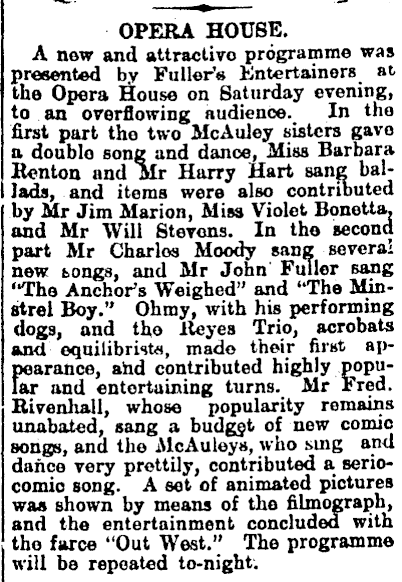
The Press, 27 February 1905
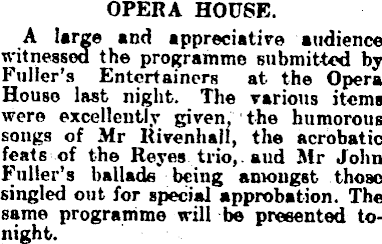
The Press, 1 March 1905
The McAuley Sisters, Barbara Renton, Harry Hart, Jim Marion, Miss Violet Bonetta and Ohmy and his performing dogs and Pete Miller and his musical cats, duck and a goat. Also popular and famous in their own right was Will Stevens, Charles Moody, Pearl Akarman, Ted Anderson, Jenny Johnston, Leslie Forrest and Carl Collier. Humorous songs by Mr. Fred Rivenhall and acrobatic feats of the Reyes Trio were mixed in with the famous John Fuller ballads.
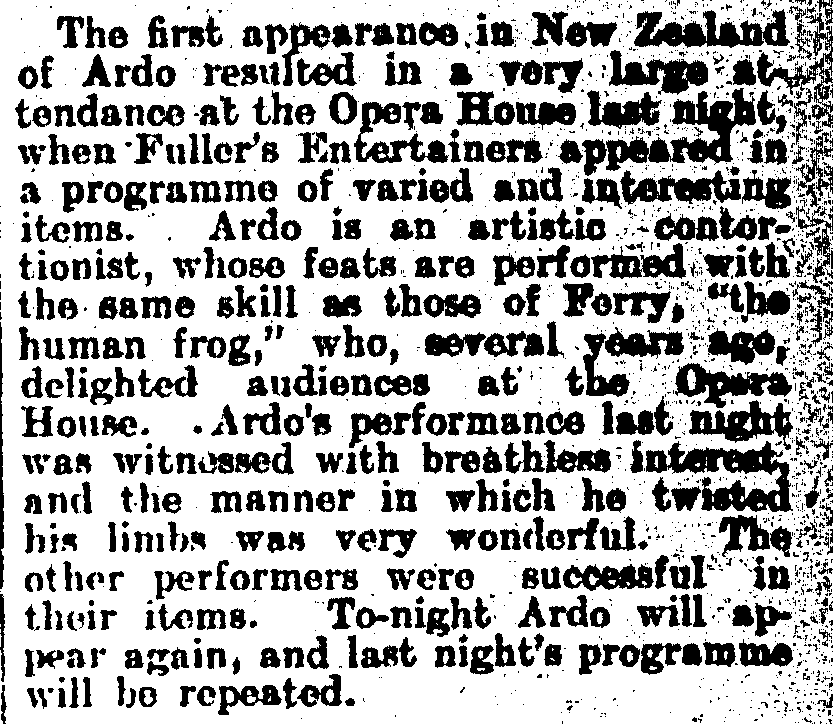
The Press, 14 March 1905
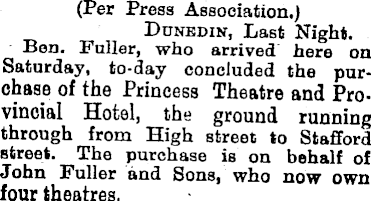
Manawatu Times, 14 March 1905
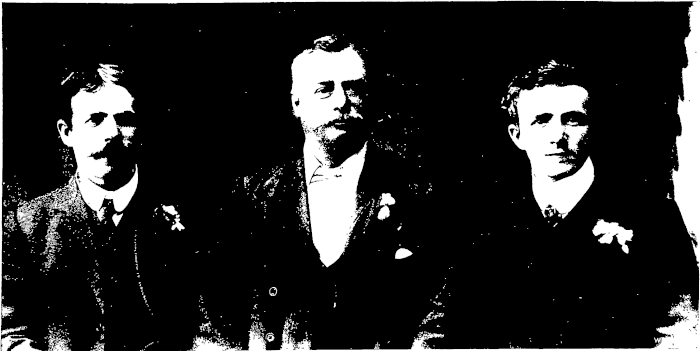 John Fuller Snr (centre) and sons Ben and John Fuller Jnr. Proprietors of the Princess Theatre, Dunedin, Otago Witness, 29 March 1905
John Fuller Snr (centre) and sons Ben and John Fuller Jnr. Proprietors of the Princess Theatre, Dunedin, Otago Witness, 29 March 1905
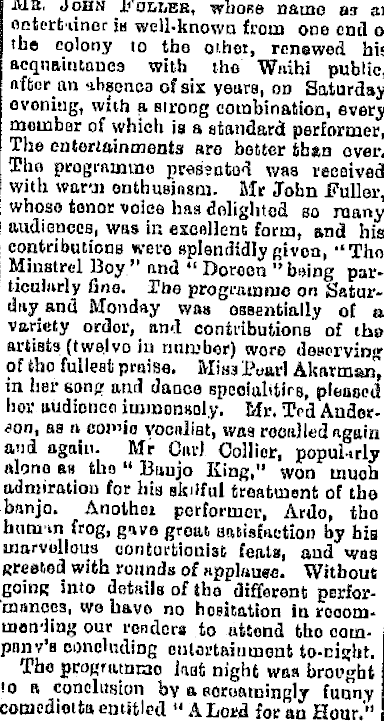
Waihi Telegraph, 25 April 1905
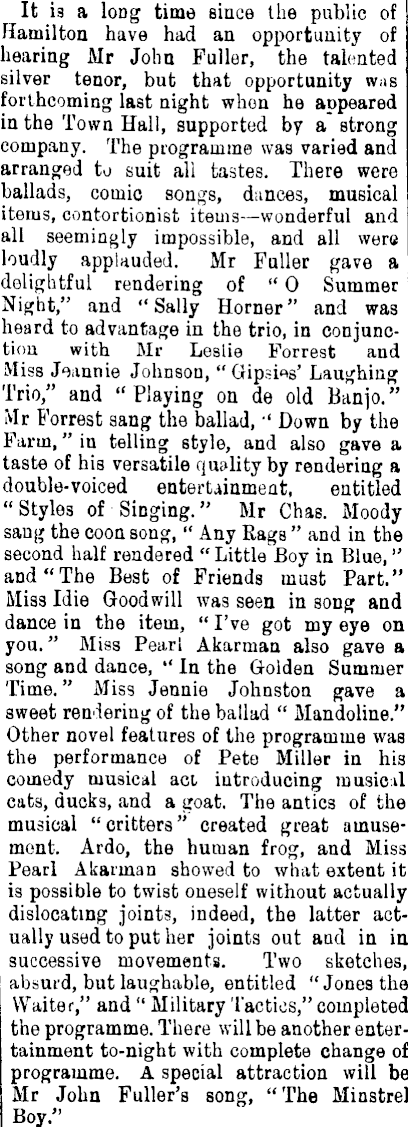
Fuller’s Empire Company, Waikato Times, 10 May 1905
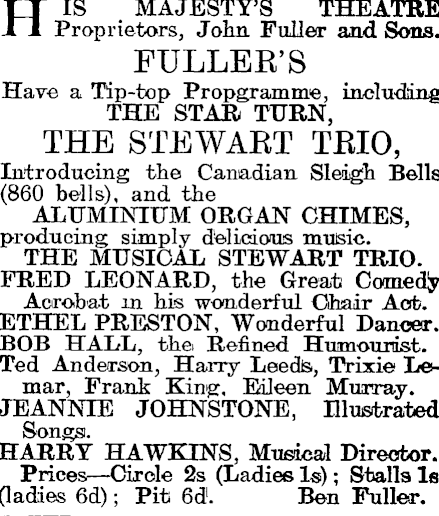
New Zealand Freelance 1 July 1905
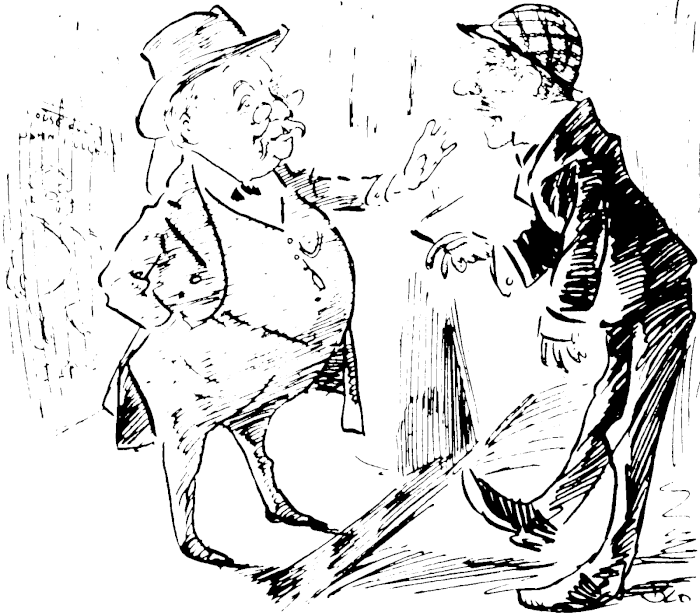

Observer, 15 July 1905
The Fullers were making history and making it to suit themselves and everyone around them. They were entertainers, comedians, singers, actors and a bit of that magic must have stayed with them when they were off stage; their public expected it. Theirs was clearly the life of celebrity. However, like all celebrities, their stage appearances can take a toll. My grandfather for instance, paid a heavy price with the breakdown of his first marriage to Gertie Fraser.
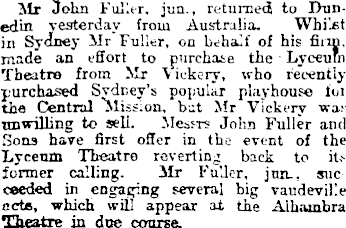
Dunedin Evening Star, 31 July 1905

Punch Magazine 13 July 1905
This photograph of Johnny has been cropped from a photograph of Johnny with his brother Ben and his father John Fuller Snr.
I am committed to account the story of Johnny and Gertie carefully and sensitively, for here was a couple so clearly in love with each other, the world was their oyster, they now had a darling baby daughter Phyllis, more money than they could sensibly spend and both had careers and had made a commitment to each other in marriage. Things were going extremely well financially for the Fullers family and for Johnny and Gertie their early-married life must have been blissful happy and rewarding. However, sadly in a further chapter, I will relate the story about how their romance faltered, to the point of a very public and humiliating divorce for them in 1913.

John and Gertie Fuller, Electoral Roll 1905-1906, Otago, Dublin, New Zealand
It was wonderful to find this Electoral Roll for Johnny and Gertie Fuller living in Dunedin, New Zealand. Johnny was managing the Princess Theatre and the Alhambra Theatres in Dunedin and his wife Alice Gertrude was listed as well. They were listed in different addresses due to the fact that Johnny had registered his name from his business address and Gertie from their home address. As can be seen Gertie is living at 6 Stafford Street which is the address of the Provincial Hotel, previously owned by Jessie Burton, Ben Fuller’s first wife.
These Electoral Rolls are a marvelous tool for the genealogist who can collect and correctly place their ancestors into their homes, listing not only their occupation and full address, but also all other members of the family over the age of eighteen years of age.
New Zealand is to be congratulated for being the first country in the democratic Western world to afford women the vote on 19 September 1893, when Lord Glasgow, the Governor General, signed a new Electoral Act into law to allow women the right to vote in parliamentary elections. Without a doubt this claim is probably the most significant move for women’s rights in the modern era and it is amazing that it happened in this small and isolated corner of our civilisation. I never cease to be impressed by New Zealand and their ability to capture the feel of the people and put into action without fuss, the most advanced human rights processes that the world has known. The Waitangi Treaty on the Bay of Islands at Whangarei, just north of Paihia, between the Maori tribes and the English settlers on 6 February 1840 is also another example of the way that New Zealand has spearheaded human rights, well ahead of the rest of the world.
Geoff and I visited the picturesque Bay of Islands in March 2019 and spent a morning viewing the Treaty Grounds Museum. The following day we returned for a tour of the Treaty Grounds with their magnificent views overlooking the harbour and were treated to a spectacular Maori dance ceremony to finish our tour. It was probably the best two days we have spent in New Zealand and it has left us with a lasting memory regarding the insightful and peaceful way that the New Zealand peoples have dealt so remarkably with their heritage, sharing their culture and promoting peace and harmony. We left impressed and proud that we are just a small part of the peoples who have helped shaped this wonderful nation. I don’t mention this lightly, because this was our fifth visit to New Zealand since 2012, whilst undertaking family research on both sides of our family.
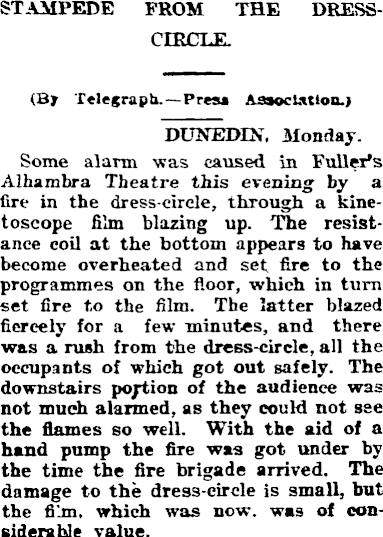

Auckland Star 8 August 1905
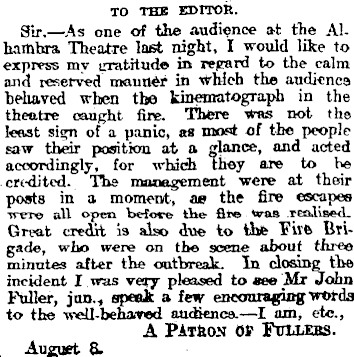
Evening Star 9 August 1905

![]()
Otago Witness, 9 August 1905
John Fuller Jnr. appears in the first photograph standing on far right hand side. It was well known that the Fuller family loved their greyhounds, both as racers and as pet owners.
It was interesting to see this clipping regarding a recording of John Fuller’s singing. It would be incredible to find this rendition, probably a cylinder recording of John Fuller or even more wonderful to find an earlier cylinder recording of his signature song Geraldine.
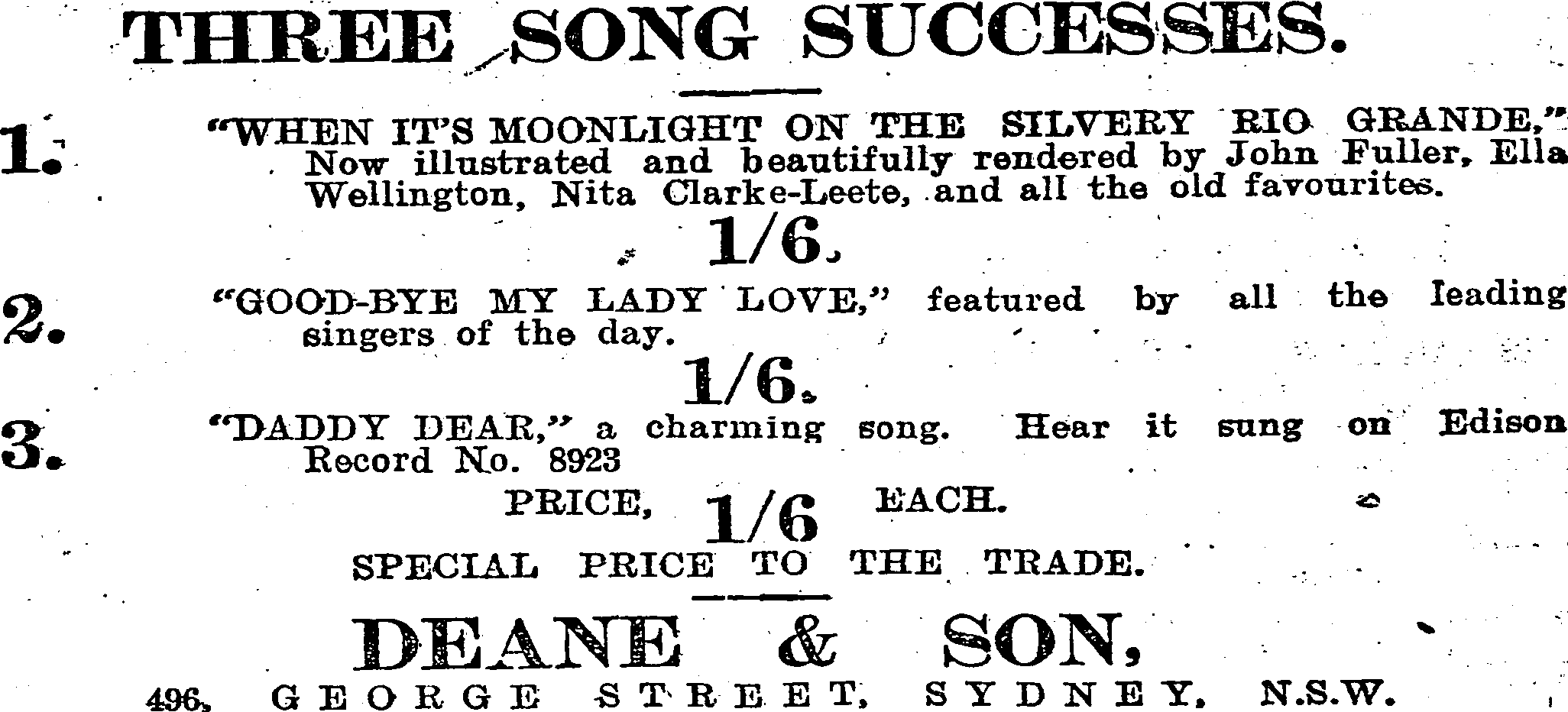
New Zealand Mail, 13 September 1905
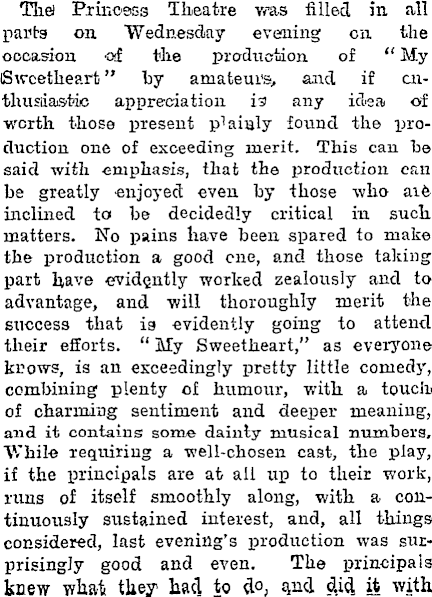

Otago Witness 4 October 1905
The Otago Witness, Dunedin reviews My Sweetheart, “Among the principals, the most outstandingly successful was certainly Mrs. John Fuller Jnr. in the role of Tina, the lady mentioned in the title. Mrs. Fuller made a very winsome, attractive and animated Tina, and was perfectly at home in the part, acting always naturally and with understanding, and being always to be depended on to make the sentimental and humorous scenes in which Tina figures so largely go with zest.”

Punch, 12 October 1905
The Australian article from Punch gives a remarkable summary and update on who, what and where the Fullers were doing in New Zealand. Johnny is in Christchurch managing the Opera House, Walter is now managing His Majesty’s in Wellington and Ben Fuller is in Auckland managing the Opera House.
In my last chapter I wrote about Ben Fuller’s life, about finding love, then marriage, fatherhood and subsequent tragedy, when his beloved wife Jessie died in 1903. This all happening so suddenly to a man who was not yet thirty years of age. However, happiness was once again to enter Ben’s life with his marriage to Elizabeth Mary “Lily” Thomson on 8 November 1905, a New Zealand singer and pianist of great regard.
It is written in Actor’s Blood by Alistair Duncan that Ben had fancied Lily on the stage as she performed in the Fuller’s theatrical productions, but her father had warned Ben off any romantic advances to his daughter some years before his marriage to Jessie. Mr. Thomson had died in 1897 and with this objection by her father now removed, widower Ben, was free to marry the very beautiful and still available Lily Thomson.
THE FUTURE MRS BENJAMIN FULLER, MISS LILY THOMSON TO MARRY
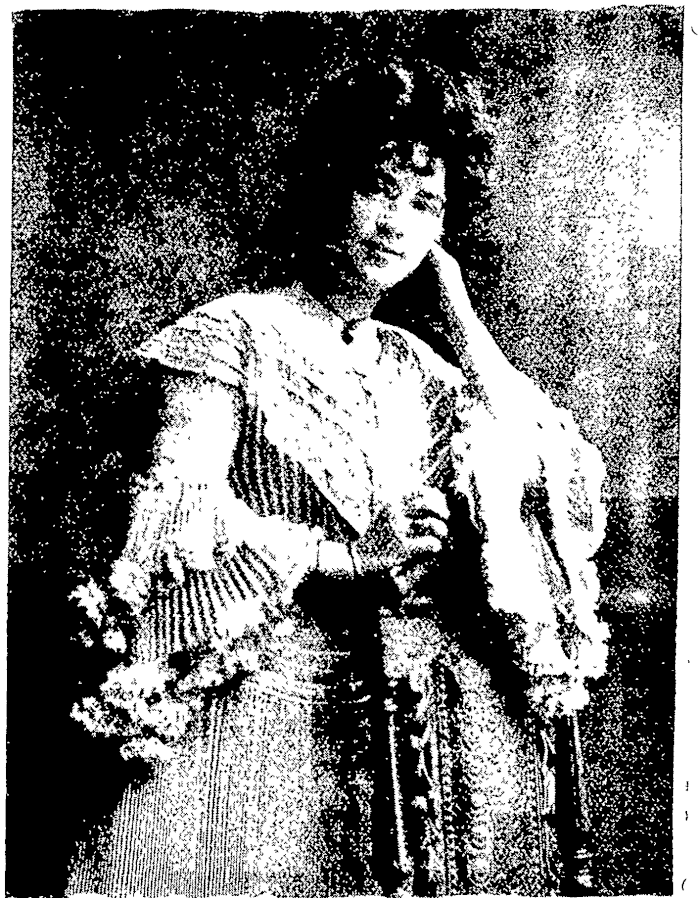 Otago Witness, 8 October 1905
Otago Witness, 8 October 1905
New Zealand Marriage Record 1840-1934:
| Name: | Benjamin John Fuller |
| Gender: | Male |
| Marriage Year: | 8 November 1905 |
| Relation: | Bridegroom |
| Folio Number: | 6172 |
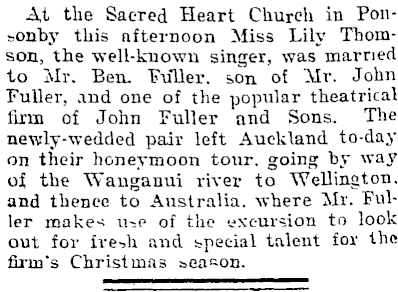
Auckland Star, 8 November 1905

Observer, 8 November 1905
 New Zealand Electoral Roll, 1905-06, for John and Emily Fuller, Devonport, Auckland
New Zealand Electoral Roll, 1905-06, for John and Emily Fuller, Devonport, Auckland
This record finds John Fuller Snr and his wife Ma listed as living in Devonport, which is on the harbour foreshore of Auckland looking back to the city. John is listed as a theatrical manager.
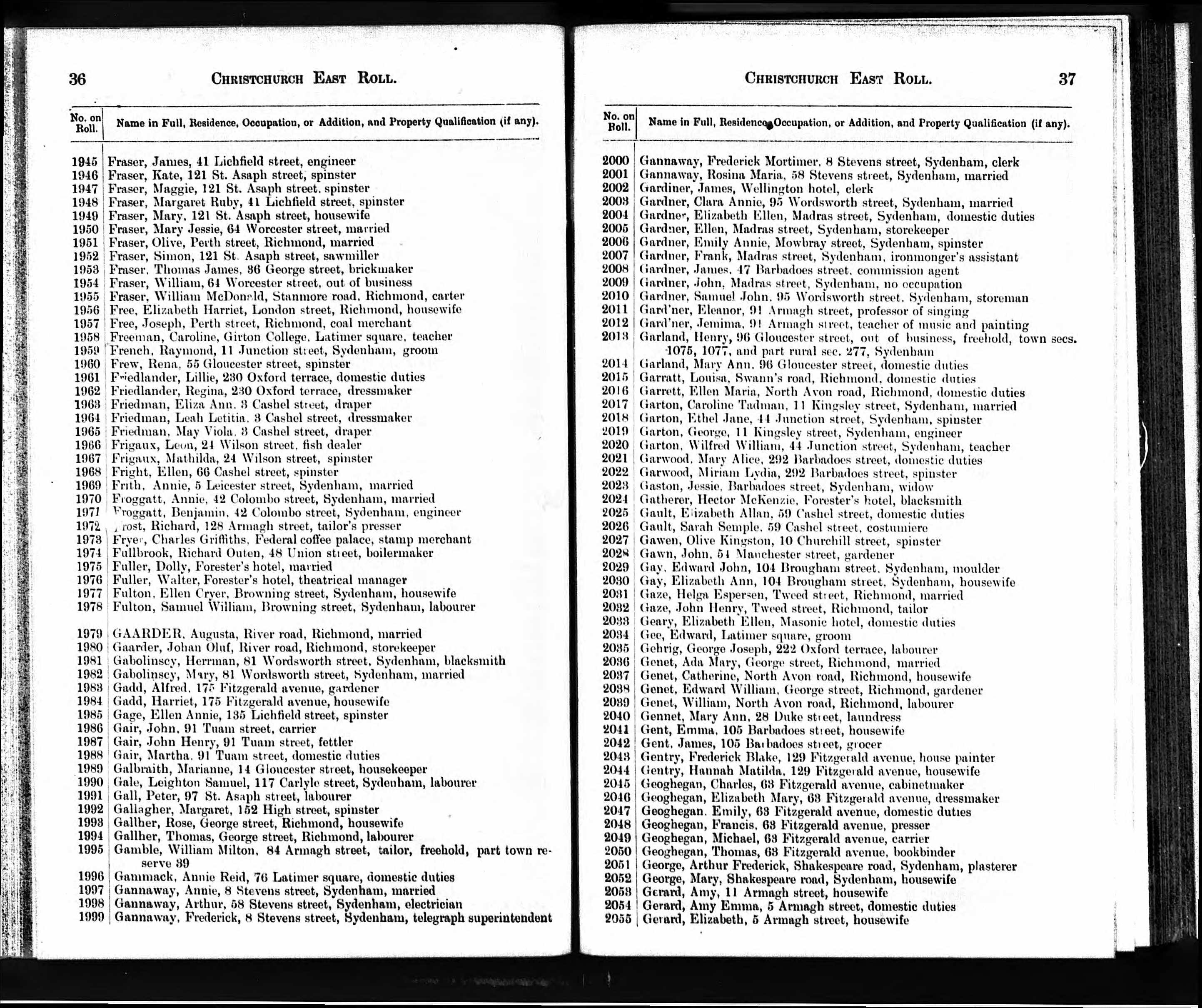
New Zealand Electoral Roll, Walter and Dolly Fuller, Forester’s Hotel, Christchurch, 1905-6
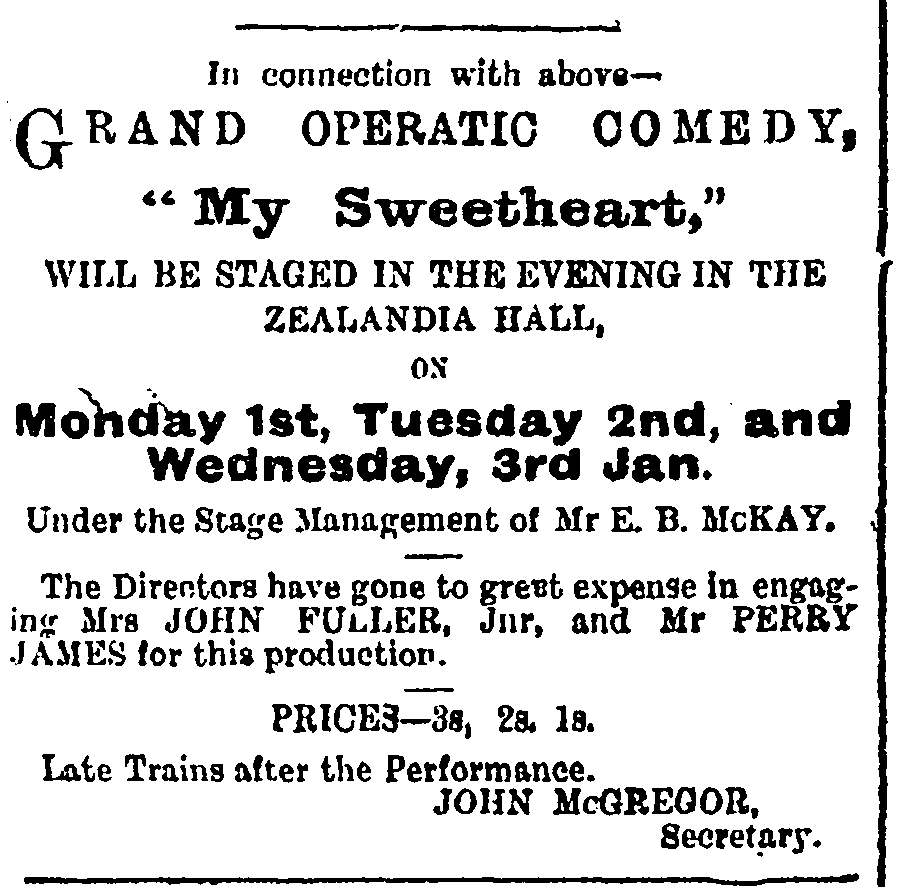
Southland Times, 20 December 1905
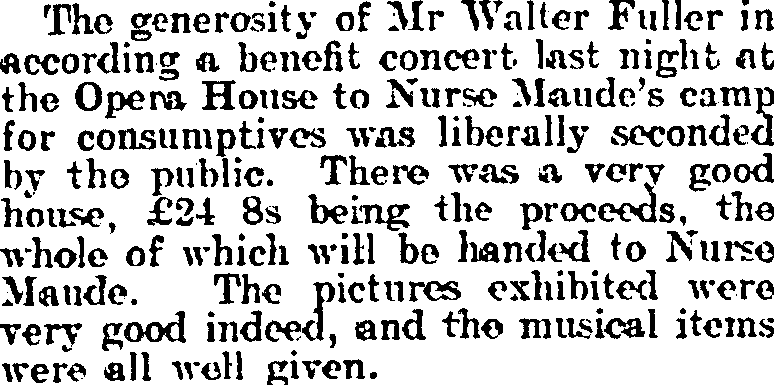
Press, 8 January 1906
The Fuller family knew that generosity was always well received by the press and just as they loved to appear at Easter and Christmas services, these benefit concerts were always a great draw.

Press, 12 January 1906

New Zealand Electoral Roll, Benjamin John Fuller, 16 Hawker Street, Wellington, 1905-06
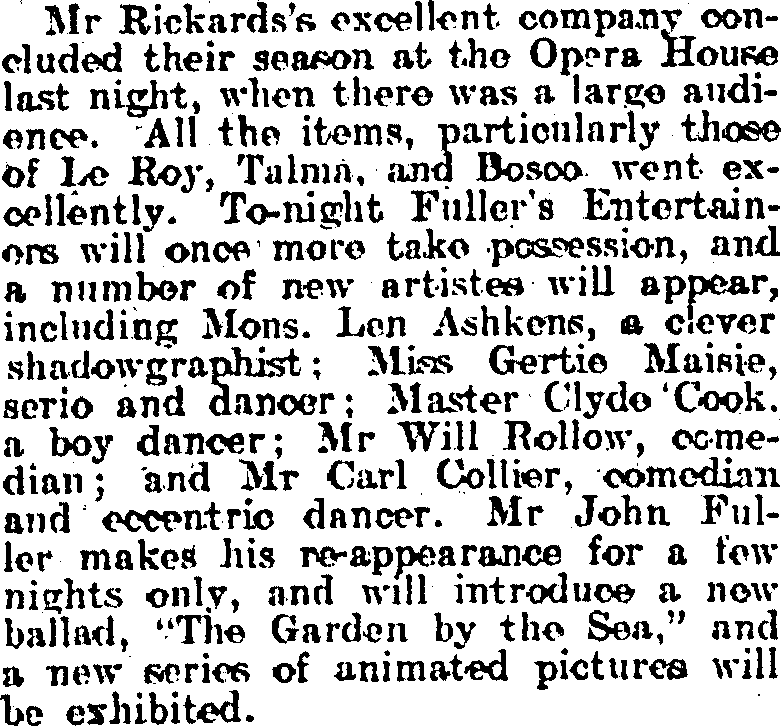
New Ballad Press, 3 February 1906
The Opera House in Auckland was still only on a lease hold situation, limiting the Fuller’s entertainment business. However, there was a good advertising campaign to announce their company’s return, top billing went to shadowgraphist Len Ashkens, serio singer and dance Gertie Maisie, boy dancer Master Clyde Cook, comedian Will Rollo and comedian and eccentric dance Carl Collier.
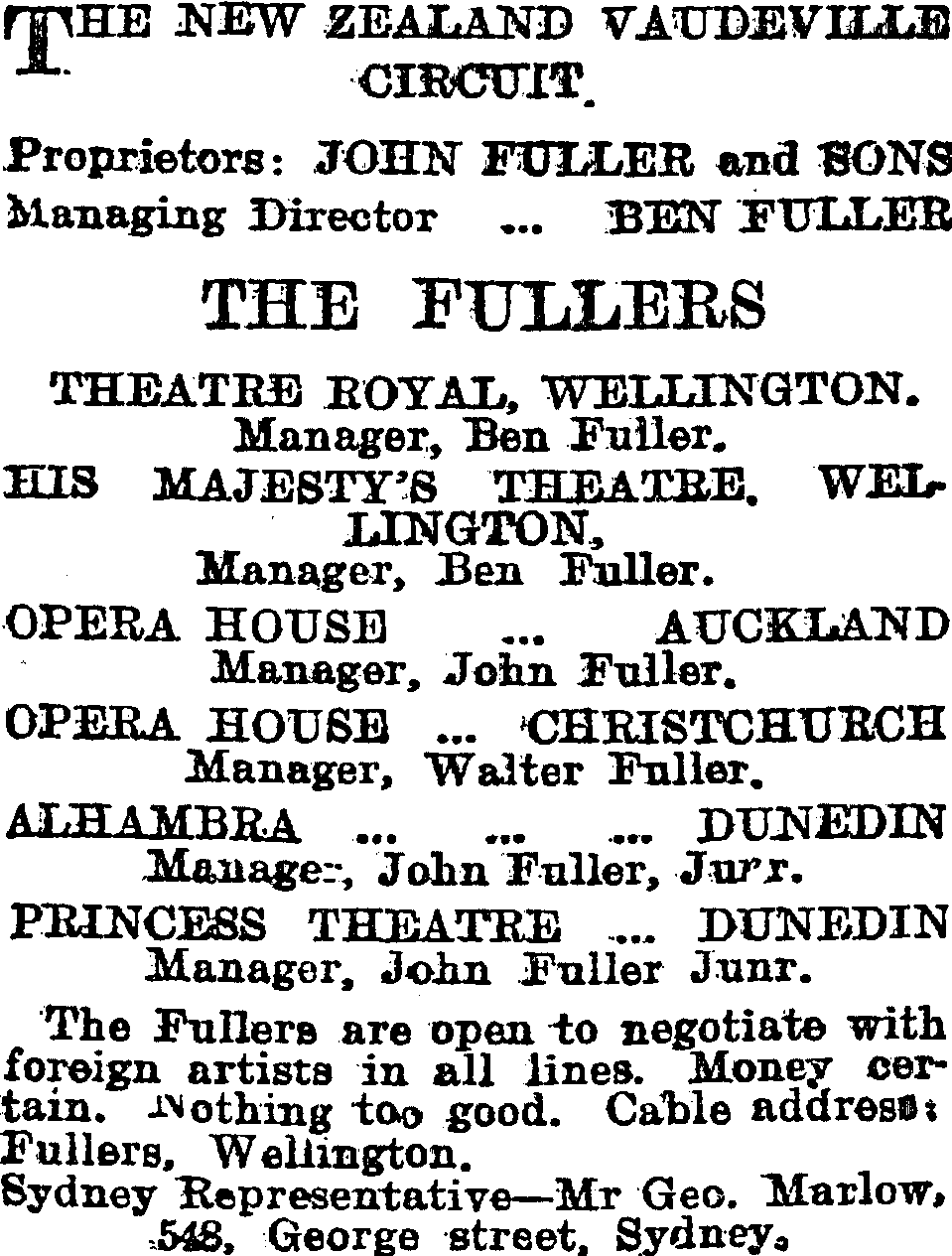
New Zealand Mail, 4 April 1906
Interestingly, this advertisement shows that the Fullers have invented yet another company, The New Zealand Vaudeville Circuit. Ben Fuller has taken over the title as Managing Director. John Fuller Sen. is happy to manage Auckland’s Opera house and it can be seen that he is handing over the reins of the business to his sons who are doing a remarkable job spreading themselves out across the rest of the country. Ben was a natural showman, like his dad, and it was only a matter of time before he exerted his dominance over his brothers. Walter was retiring and content in his life and his life as a musician overrode any ambitions to run the company. Johnny Fuller, being the younger brother, deferred to Walter and Ben, however, it could be seen that his area of expertise was his financial brain and together with a more conservative nature, he was forever trying to keep Ben from expanding too quickly with his new and extensive plans for the expansion of the business.
Most interestingly, my sister Lavinia Chrystal and I have transcribed our grandfather John Fuller Jnr’s Diary of his World Tour of 1907 and very often we have been able to see his comments, wondering “what Ben was up to” whilst he was away. The fact was that the press and public absolutely loved Ben Fuller’s winning ways, his success was marketable and a license to print money for the Fullers. He never failed to offer an interview and his star quality or charisma was helping to propel the Fuller name in the press both in New Zealand and in Australia.
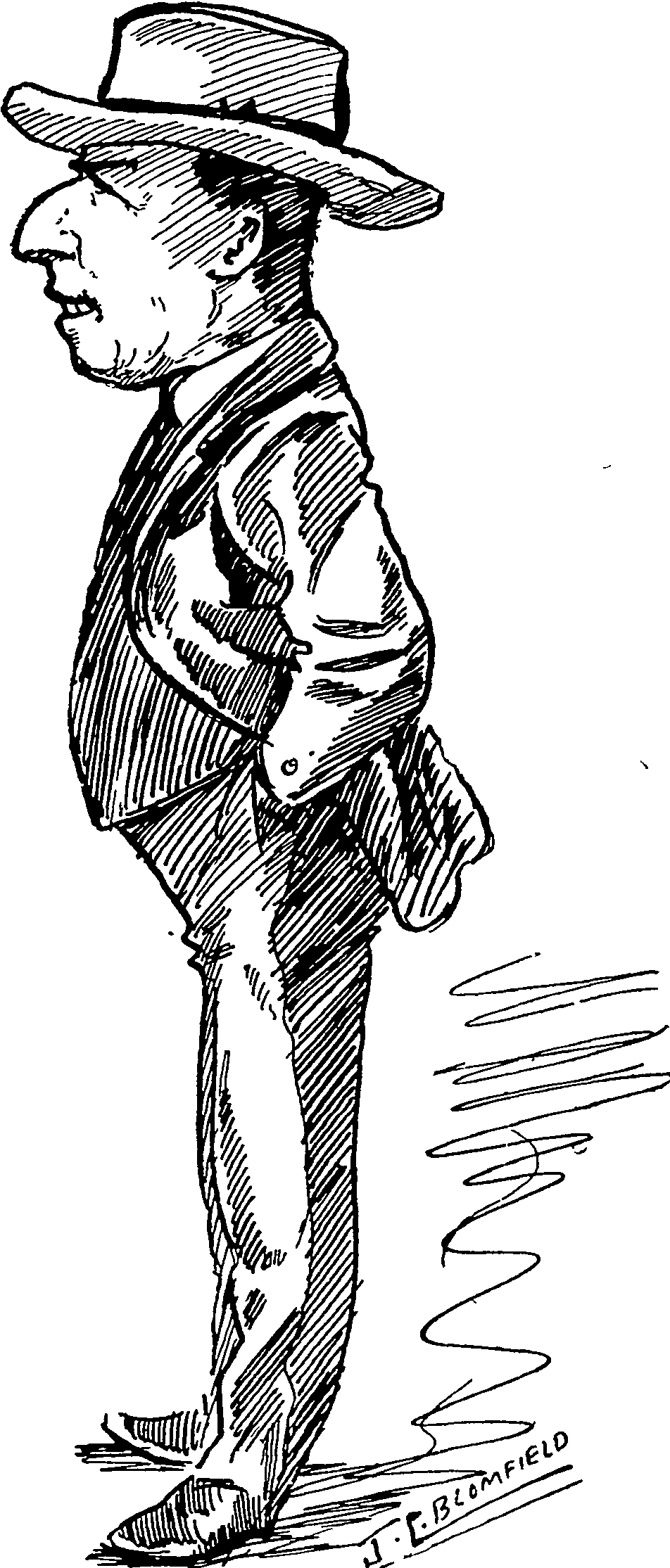
Ben Fuller Cartoon, Free Lance, 28 April 1906

Evening Post 24 July 1906
Ben Fuller regales his funny experiences hiring performers for their concerts.

Fuller’s Theatre Royal, Wellington, New Zealand, Referee (Sydney), 1 August 1906
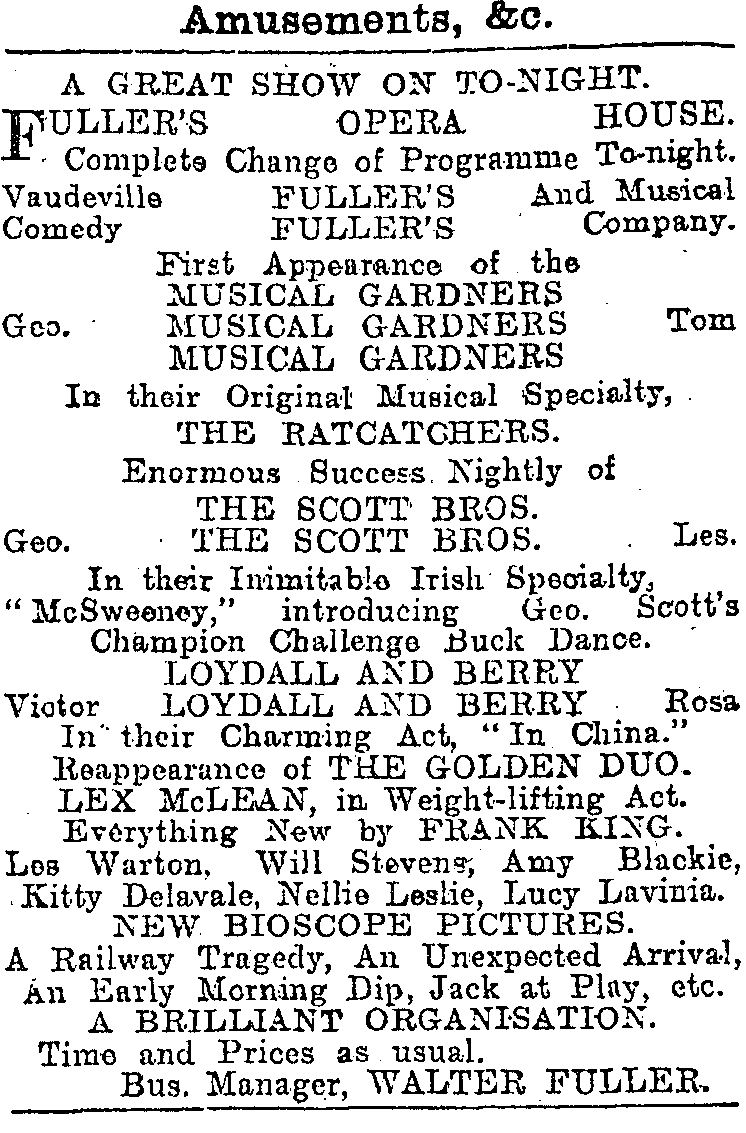
Opera House, Christchurch, Lyttelton Times, 11 August 1906
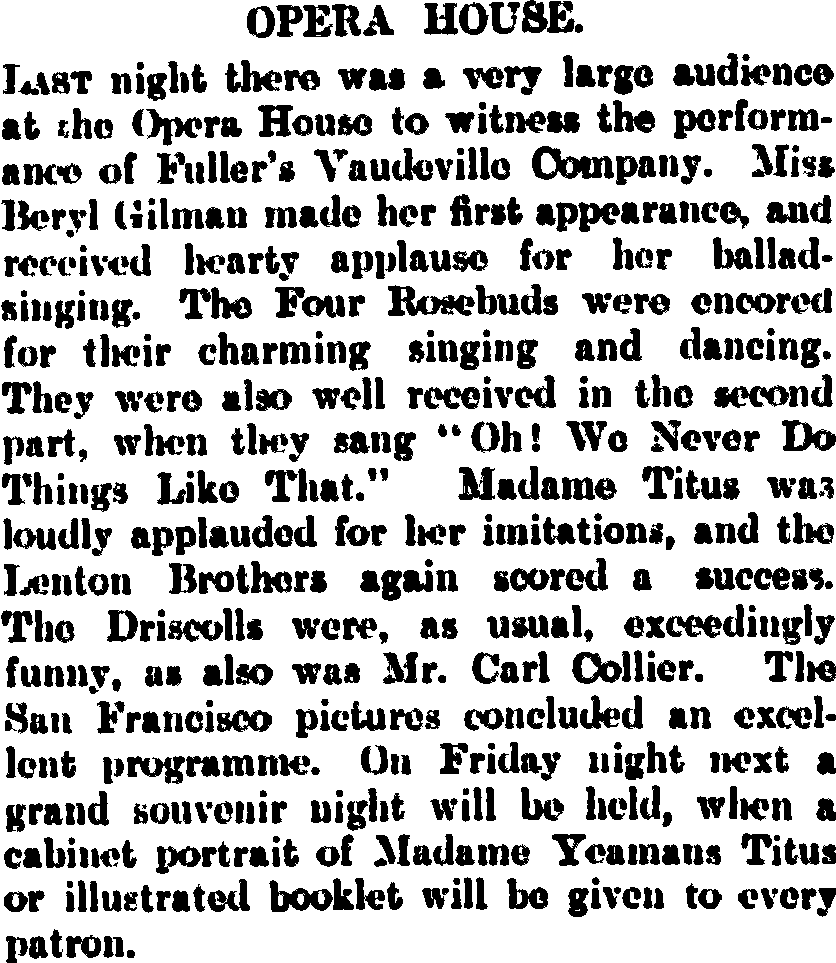
Opera House, Auckland, New Zealand Herald, 14 August 1906
The Fuller’s Vaudeville Company has full houses with very eclectic and popular acts showing at their signature theatres across New Zealand, including the first appearance of Miss Beryl Gilman, The Four Rosebuds, Madam Yeamans Titus, The Lenton Brothers, The Driscolls and Carl Collier.

Referee (Sydney), 14 August 1906
In just twelve years the Fuller’s influence in the theatre world had become renowned, so much so that John Fuller’s name was indeed a household word in New Zealand.
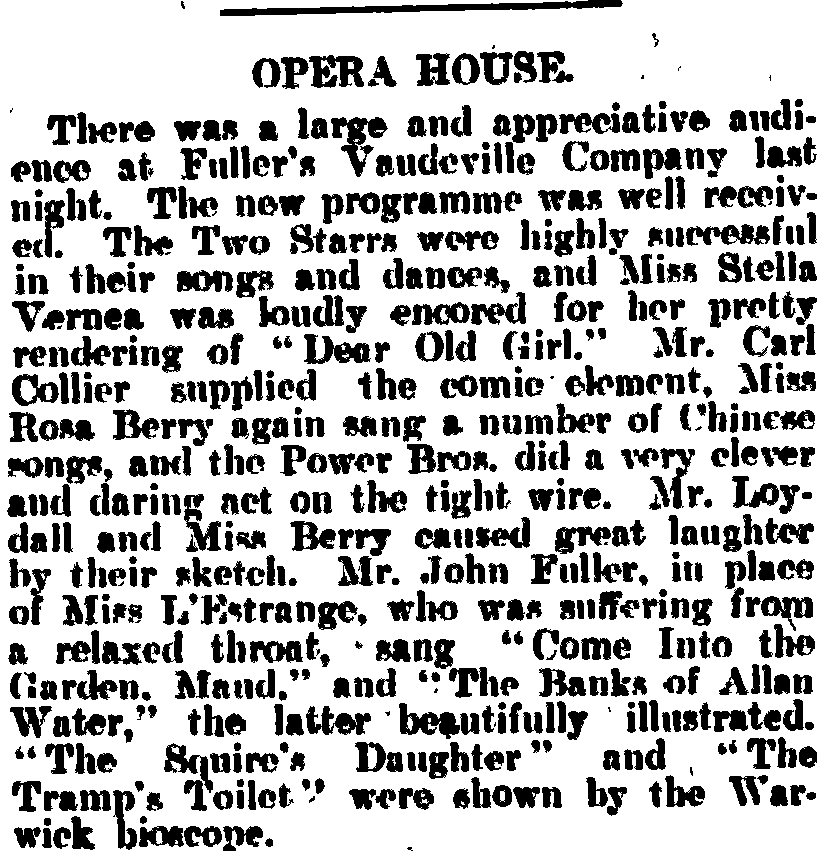
New Zealand Herald, 23 September 1906
Included in the top billing were the Two Starrs, Miss Stella Vernea, Mr Carl Collier, Miss Rosa Berry, the Power Bros., Mr Loydall and Miss L’Estrange.
WELLINGTON WING WHISPERS
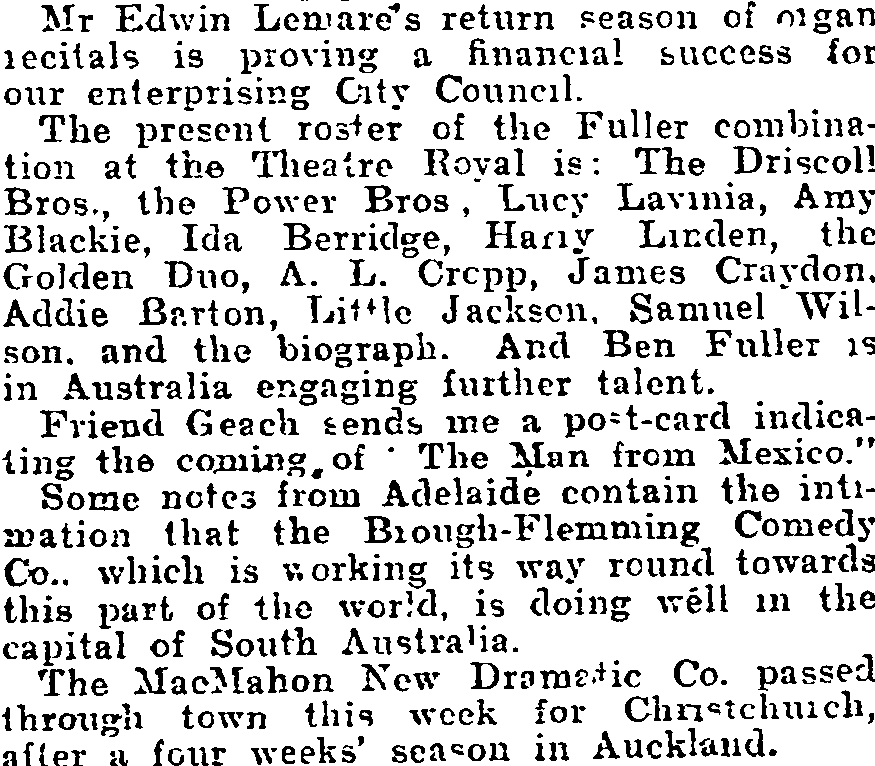
Otago Witness, 17 October 1906
Theatre Royal stars were The Driscoll Bros., the Power Bros., Lucy Lavinia, Amy Blackie, Ida Berridge, Harry Linden, The Golden Duo, A.L. Cropp, James Craydon, Addie Barton, Little Jackson and Samuel Wilson

Entertainment at Lumsden, Southland Times, 13 November 1906
It was wonderful to read this article about Gertie Fuller and her accomplished career and ability to draw a crowd for a good cause such as a parish fundraiser for Lumsden. To see that Gertie was so popular, that “when this became known, success was assured. The house was literally packed, every available inch being occupied” It was also wonderful to capture this list of popular songs of the times, Gertie singing Navajo, for which she was vociferously applauded and encored, I wouldn’t leave my little wooden hut and Gondolier.

Otago Witness, 26 December 1906
Another wonderful article from the Otago Witness summarized the Fuller’s Boxing Night entertainment:
The Auckland Opera House, managed by John Fuller Snr., starring the Rollos, Lewis Sisters, Arthur Touches, Amy Blackie, Lucy Lavinia, Pearl Lovell, Phyllis Fay, Kitty Delavale and Sam Wilson.
Wellington Theatre Royal, managed by Ben Fuller, starring Graham and Dent, Les Warton, Harvey and Morris, The Carmos, The Rosebuds, Tom Hedley, Will Wynyard and Slade Murray.
Christchurch Opera House, managed by Walter Fuller, starring The Bicknells, Percy Denton, Driscoll Boys, Lesso and Roberts, Dorothy Le Estrange, Lillian Loftus, Herz Trio and May Wallace.
Dunedin Alhambra Theatre. Managed by John Fuller Jun. starring Credge and Gibson, Master Norman Mudford, Valentine Newton, Ida Berridge, Annie Cavender, Crayden and Barton, Little Jackson, The St Leonards, Will Stevens, Harry Linen, Ward Lear and Fred Stokes.
This article announced that Will Stevens has terminated his employment with the Fullers to pursue engagements in Australia.
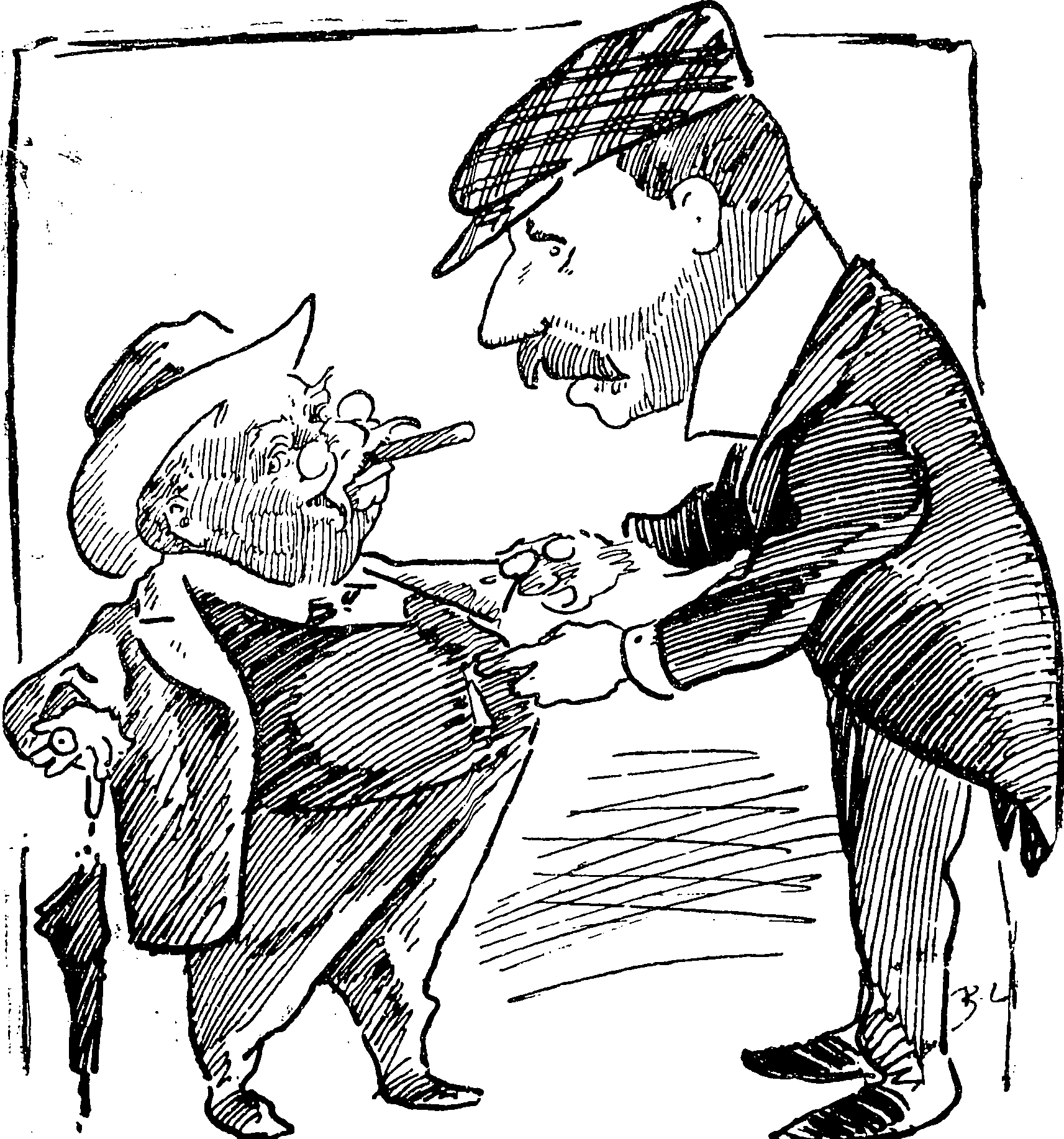

Observer, 5 January 1907

Evening News, 25 January 1907


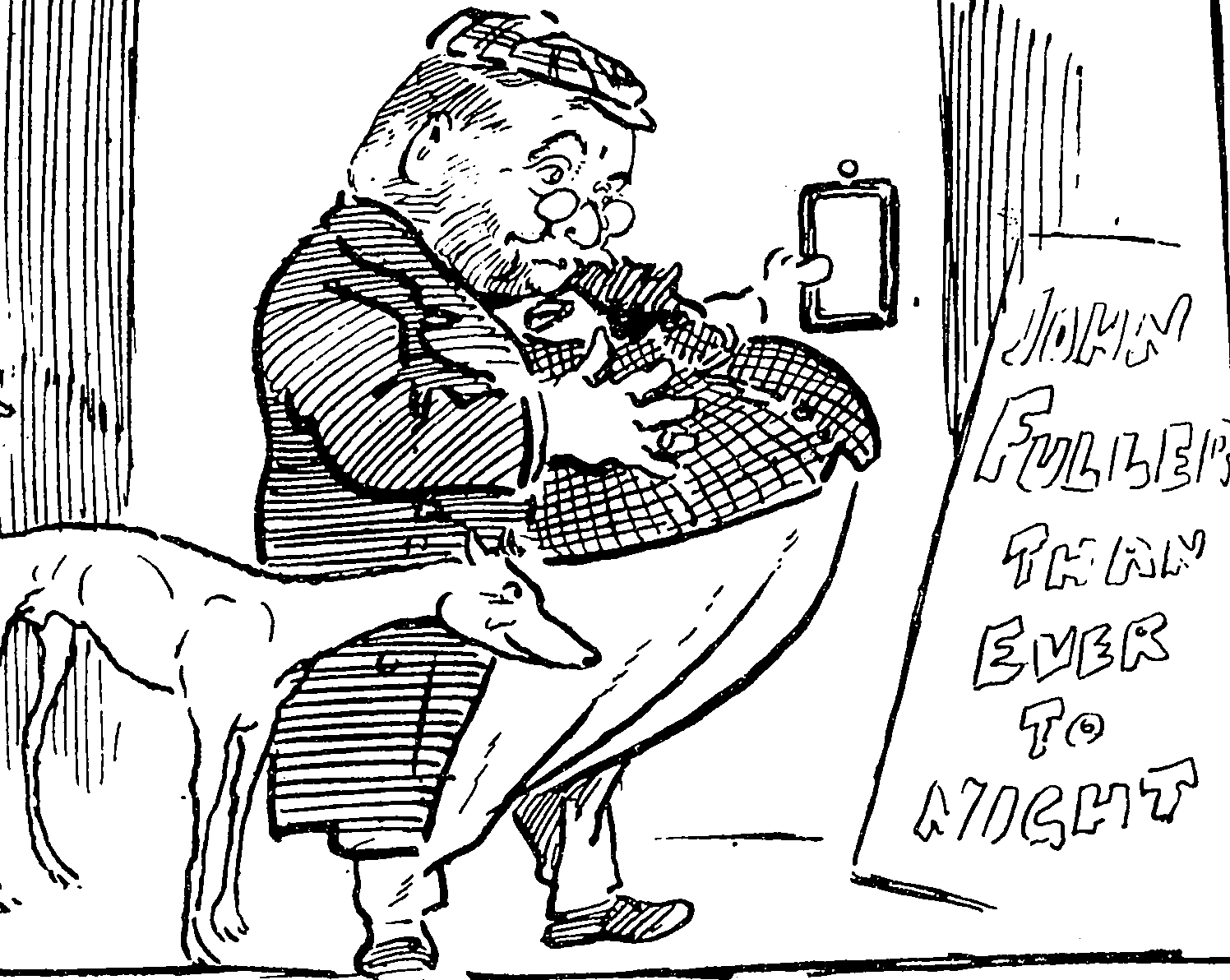
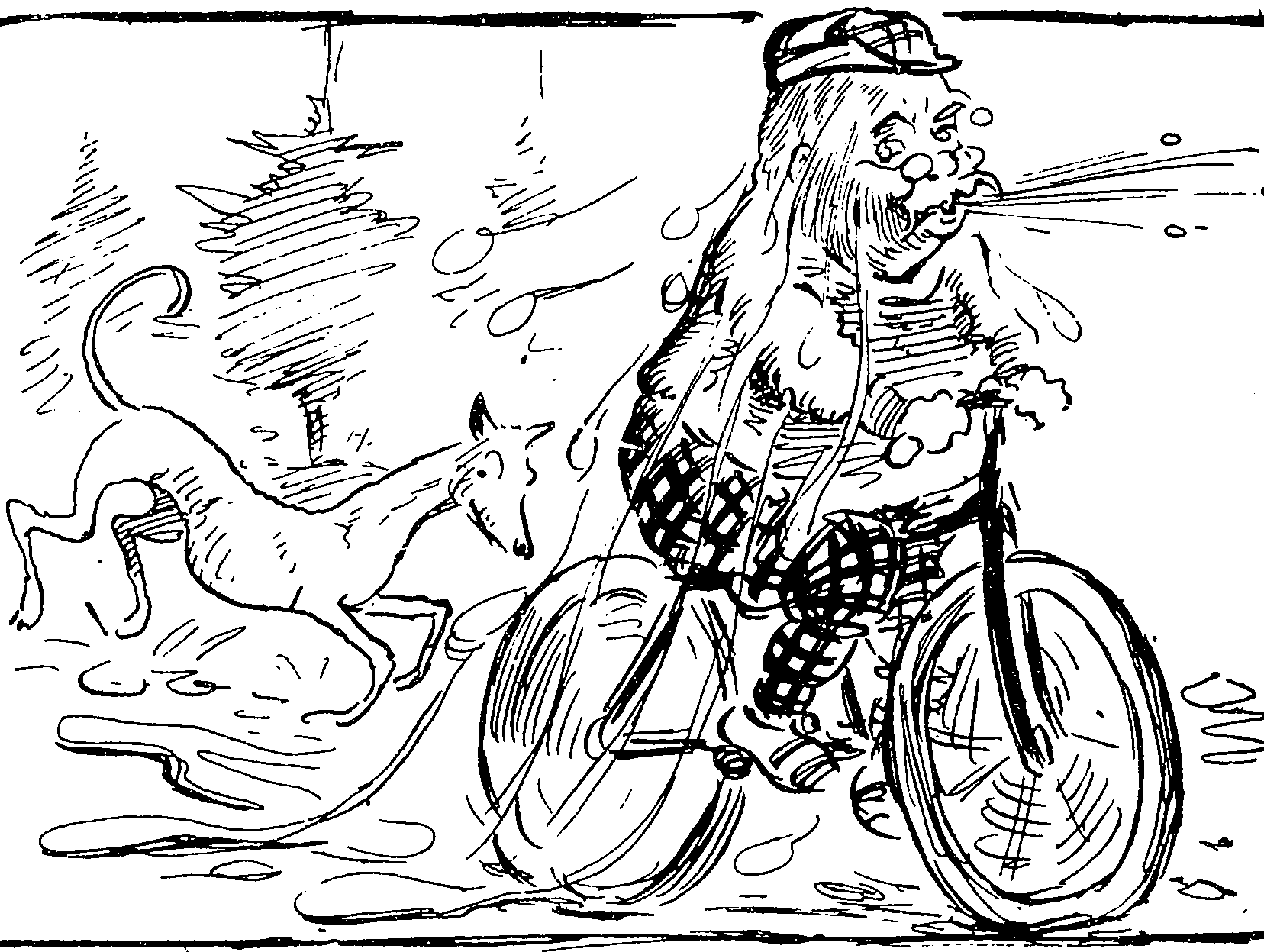



Observer, 23 February 1907

New Zealand, City and Area Directory for John Fuller, Beach Street, St Clair, 1907
Again I could see that Johnny had moved to the water in Dunedin and settled out of town in Beach Street, St Clair with his wife Gertie and small daughter Phyllis. As I have seen in other cities the Fullers had a penchant to be beside the sea, perhaps this was a typically English reaction to their London heritage when they lived in the slums of London and the escape to the beach and sunshine was something so especially English. Later when John and Gertie settled in Wellington they purchased a home on Oriental Parade overlooking the magnificent harbour and when my grandparents Johnny and Lavinia Fuller first settled in Sydney they chose the waterfront of Sydney Harbour at Elizabeth Bay for their first home, just a few houses up from where his brother Ben and Lily Fuller had settled, also in Billyard Avenue.
John Fuller Snr and his wife Emily, known always to the family as Ma Fuller, also chose Devonport in Auckland right on the waterfront with spectacular views back to the city.
There was so much going on for the Fullers in 1907, John Fuller Jnr. was leaving for his exciting world tour, there was a new manager to hire for Dunedin during Johnny’s trip, new acts to employ both in Australia and New Zealand and there was the re-building of their Wellington Theatre, His Majesty’s theatre was to be strongly built to enable it to withstand a strong earthquake. Ben Fuller also was commended for his innovative employee insurance scheme. This part of the chapter will comprise snippets from newspapers in Australia and New Zealand concerning the Fullers and narrowing down the selections was difficult as practically their every move was monitored. It was obvious too that the Fullers had mastered the art of the “press release”, often in the form of postcards or notes to the entertainment reporters of the major newspapers which were then often picked up by the more provincial papers. John Fuller Snr. had certainly passed on to his sons the art of self-promotion and in several cases I could see “the boys” releasing their own promotional material on the same day, possibly without consulting each other. The sibling rivalry was obvious to me whereby they were thrilled with their outstanding financial success and theatrical popularity, but at the same time, they had to keep an eye out as to exactly what their own brothers were up to!

Referee, 20 February 1907

Sunday Times, 25 February 1907

Queenslander, 2 March 1907

Referee, 6 March 1907


Referee, 6 March 1907
“Mr. John Fuller, Jun., who has left for a world’s tour.”
It was wonderful to work with my sister Lavinia Chrystal transcribing our grandfather John Fuller Jnr’s 1907 Diary. It took several months to complete this task, much of it done in the winter months of 2017 working in my sunny sitting room looking out onto Sydney Harbour. A quick chat, a cup of hot tea and we were down to our work, perhaps completing about 5-7 pages per sitting. It was hard work and thankfully as I became accustomed to my grandfather’s handwriting, it became easier day by day. The Diaries are in two volumes of 150 pages each. There were several times each sitting when we were stumped for a word, however, most of the time it was eventually resolved and many was the time we exclaimed about how interesting and descriptive his historical and social observations were. We were particularly intrigued by his intrepid sightseeing and often commented about how differently we view the world today and what sights were iconic views for our grandfather to take in. His observations on each county’s social mores, habits and the weather were intriguing, as were his constant comparisons to New Zealand. I lament that when Johnny was in London he did not detail more about his visits to his relatives, as he seemed determined to press on with his duty to report on each and every theatre he visited, down to a headcount for the evening, the theatre layout, costs and a description. We were also intrigued about how little personal content was evident. Gertie was mentioned only fleetingly during the entire diary and this I think I can confidently explain, due to the fact that he was posting off the original and another copy off to his father and his brother Ben in New Zealand.

March 14, At Sea ex Fremantle, John Fuller Jnr’s World Tour 1907, page 7
Johnny had been officiating in the capacity as Cruise Entertainment Director and to be honest, who could have been better at this job? I think he is modestly explaining that he tried to enlist others to help, but in the end, this was probably better left to an expert like himself. It was wonderful to read where he and Gertie entertained the other passengers singing the lovely duet, In The Dusk of the Twilight, a song they had often sung on the stages of the Fuller’s New Zealand theatres.

March 16-20, At Sea, Indian Ocean, John Fuller Jnr’s World Tour 1907, page 8
“At the evening held a dance the deck beautifully decorated with flags and coloured electric light, the Bremen’s orchestra in attendance. JF jnr. still master of ceremonies and M.C, it passed off splendidly but there is a decided predominance of lady passengers.” The page end with a birthday message to Ben for the 20th March 1907.

March 21-22, At Sea, Indian Ocean, John Fuller Jnr’s World Tour 1907, page 9
It took me ages to work out Johnny’s sign off, but finally it became clear that Mat Johnny was “More Another Time, Johnny”, and a sign that he was writing this diary as a report to his brother Ben and father John Snr. He would of course be putting several pages of his diary together in a letter to post back home. My sister and I admired Johnny’s command of the English language and his wide vocabulary; this coming from a person who had very little formal education.

Referee, 17 March 1907

Sydney Mail, 24 March 1907

Referee, 8 May 1907
This newspaper clipping regarding a postcard from John Fuller Jnr. may seem out of date in sequence, however, by early April, John and Gertie were already in Italy, and had started their grand tour of the Continent.

April 9-11, Naples, Italy, John Fuller Jnr’s Diary 1907
This excerpt from John Fuller Jnr’s Diary is a wonderful description of the Carlo Theatre in Naples. So many theatres around the world were inspired by Greek and Roman temples from the ancient world. These Neo-Classic Theatres were influenced by the scale, symmetry and the ancient orders of the Doric, Ionic and Corinthian styles. It was a combination of the classical, sublime and the romantic all crashing together, that created this awe inspiring and impressive theatre architecture, together with the new innovations of luxury plush velvet cushioned seating in the theatres. In all, it was the escapism, so yearned for by patrons, which was reflected in the theatres, where, for a short time a person could be transported to another country, in another age and totally forget their own mortal and possibly humble existence.

Paris, France, May 5, John Fuller Jnr’s World Tour Diary 1907, page 41
Harrington of Sydney is film producer Pathe’s agent and will soon be retained in Paris for the Fullers as their agent because John writes, “as soon as anything is out (they produce one new film every day) they forward (what they think will sut Australasian) four copies of each picture to Harrington. If we want to deal direct with Pathe we will have (page 42 cont.) to deposit so much with Pathe and he’d send us all the comic and good dramatic films published and as he sent the films and paid freight, so would our account be reduced,”

Paris, France, May 6, John Fuller Jnr’s World Tour Diary 1907
Continued. “if we didn’t like the film we could send it back (if we did so immediately), the price of film bought in Paris off Pathe (exclusive of customs freight) is one and a half shillings per metre (a metre is about 6 inches longer than a yard). I didn’t purchase any films in Paris as there was nothing startling produced while I was there.”
These films were 8 minutes in length and several were shown by the Fullers during one evening’s entertainment in their New Zealand Theatres. This was surely the transitional period for the Fuller’s moving forward from their original vaudeville varietal entertainment to the very popular silent movies which were transfixing audiences around the world. There was also plenty of scope for the Fuller’s Theatres to add sound/light effects, musical interludes and dramatic voice overs.

17 May, London, England, John Fuller Jnr’s World Tour, page 50
John Fuller Jnr. visits the Tivoli Music Hall whilst in London and observes the white safety screen being used for advertisements, operated by a magic lantern. This is classic Johnny at his best, “I gleaned that the adv. costs 5 pounds per month each and there were about 10 advertisements so that is a very good way of making revenue and it entertains or keeps interested the audience, until the commencement of the show. This ideas knocks the adv. Curtain, into a cocked hat and I’d advise trying the scheme at once.” John knew a good innovation and suggested his brothers not waiting for his return to implement this innovation.
After leaving London, John and Gertie went on a whirlwind tour of the “counties” and then onto Scotland and Ireland. Practically everywhere Johnny and Gertie went they were pursued by rain which started in Italy and blighted their trip.
I had to laugh when I read that Johnny had kissed the Blarney stone in Cork, Ireland because many years ago I also performed the same feat. I always laugh about it, because I actually kissed the Blarney stone twice. It is a bit of an effort as you are hauled upside down by a pair of strong lads and lowered over the edge of the tower and at the appropriate moment you are photographed as you kiss the stone. However, as I reappeared, my husband explained apologetically that his camera failed to take the photo and so the entire process had to be repeated! Hence the myth about talking a lot of Blarney abounds in the family, I fear.

Mercury, 21 May 1907
Charles Tilliard Natusch (1859-1951) was a prominent New Zealand architect and surveyor, noted for the building of Tudor styled homes for prominent citizens. He was engaged by Fuller’s Theatres to develop plans for His Majesty’s Theatre, Courtenay Place, Wellington. The theatre today is better known as the St James’ Theatre, which thankfully survives, thanks to the Wellington community who rallied to save the building from a threatened demolition in the 1980’s.
We own Wellington a debt of gratitude for this preservation; if only Sydney residents had been more active, perhaps today the St James Theatre in Elizabeth Street would survive? In its place we have a monotonous hard edged, featureless building that bears the name St James Centre and the wondrous 1920’s theatre which once boasted that it was the tallest building in Sydney at six stories is sadly long forgotten, as is the name Fuller’s Theatres. Today when I tell people I am writing up my family chapter on the Fuller family Theatre Empire I just get blank stares; how quickly fame and fortune are forgotten in our busy world.
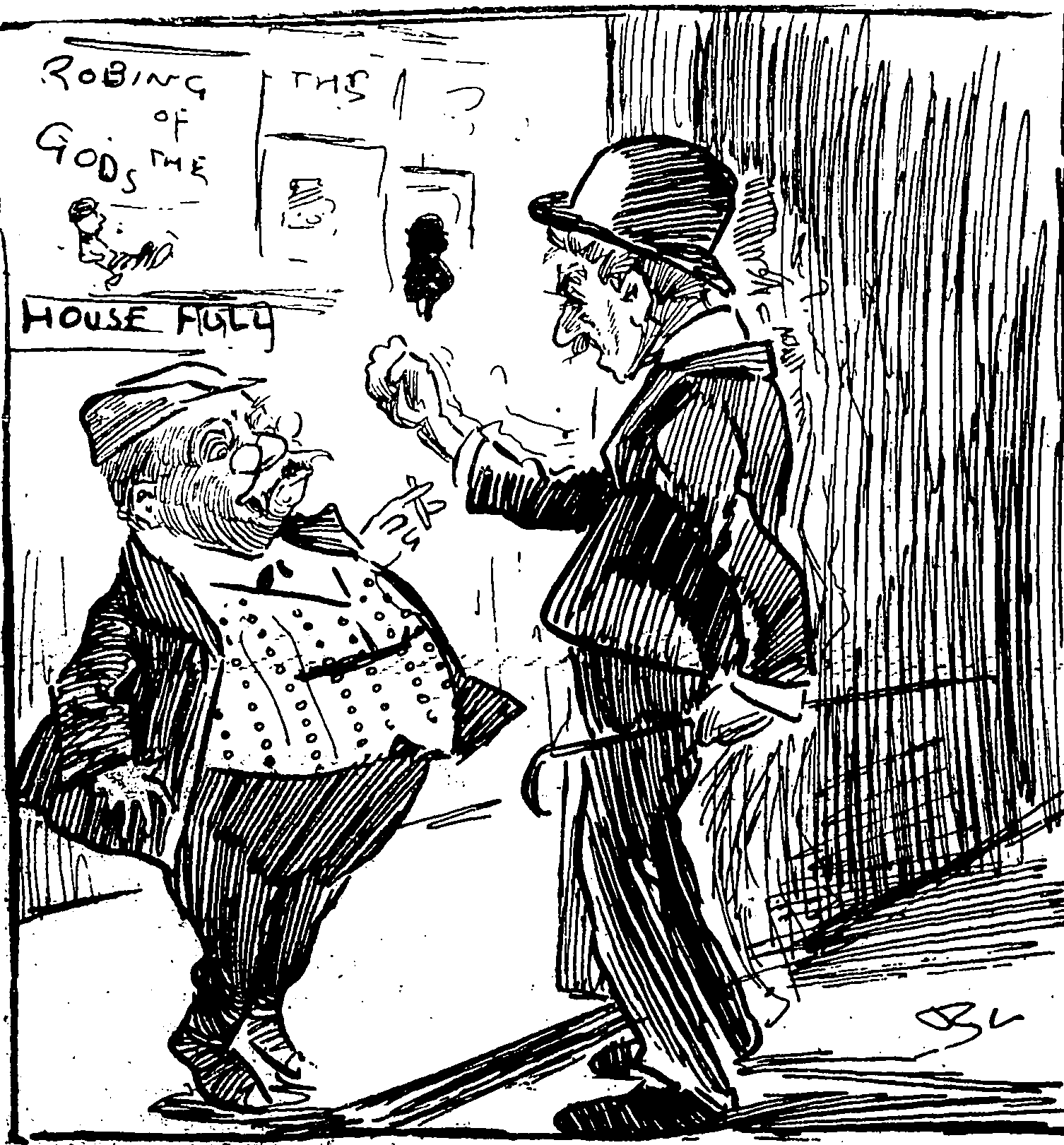

Observer, 1 June 1907
I have no idea what John Fuller Snr. must have made about these hilarious cartoons about his treatment of some of his less responsible Auckland patrons. I imagine he took it all in his stride and with a good laugh he probably adhered to the old adage that any publicity was good publicity for Fuller’s Theatres.
I have the distinct impression that this Fuller family had a great sense of humour and had a lot of fun doing what they did best, which was entertainment on a grand scale. I was only a small child of five years when my grandfather died, so my memories of him are vague. Obviously I never knew my great-grandfather, nor did my mother Lavinia Fuller, who was Johnny Fuller’s daughter from his second marriage know her grandfather. There was a seventeen year gap between Lavinia and her half- sister Phyllis Fuller. John Fuller Snr. died in 1923, just two years after my mother’s birth.
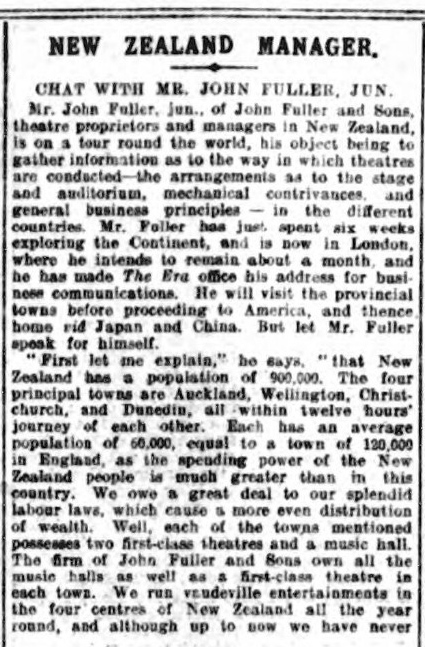
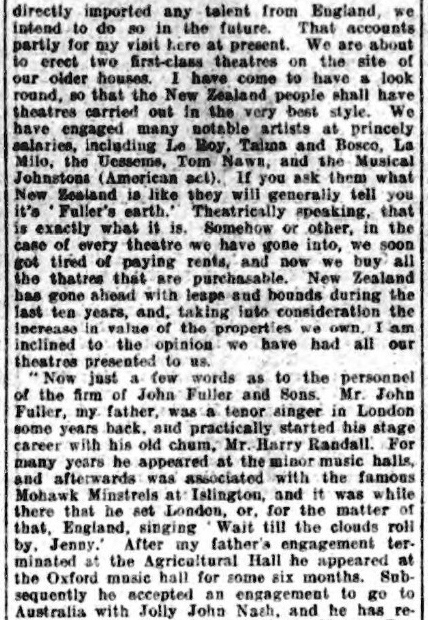
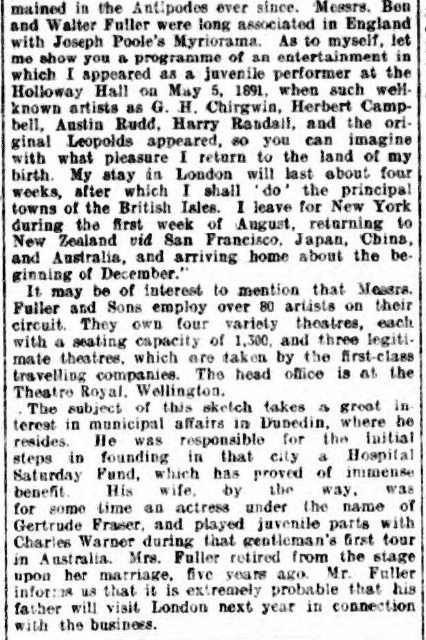
The Era, (London), 1 June 1907, clipping courtesy of Jean Thomas
This wonderful interview by the Era Newspaper, Londonwith John Fuller Jnr on his world tour of 1907 is so interesting, in essence it almost brings to life his voice, explaining his opinions, goals, achievements and the reasons for his trip around the world. A portion of the interview did appear in the Evening Post, Wellingtonon 27 July 1907.
I am indebted to the kindness of Jean Thomas, a talented researcher who lives in the U.K., who found this newspaper clipping for me from old English newspapers and sent it to me along with an enormous amount of information about John Fuller Snr. and his involvement on the London stage before he arrived in Australia in 1889.
Jean Thomas’ interest in the Mohawk Minstrels stemmed from her own ancestor, Little Thomas, who also performed in the troop in London. Jean found my website after typing in the name John Fuller into her computer search engine in October 2019. Jean emailed me to let me know she had some information about John Fuller and would I be interested? She then very kindly sent me music covers, song sheet music, newspaper clippings and Mowhawk Minstrel Programmes mentioning John Fuller Snr. This information was so interesting to me because I didn’t realise just how significant John’s musical involvement was in England during the 1880’s. I will updated my earlier chapters to include Jean’s clippings.

Referee, 5 June 1907

Referee, 12 June 1907
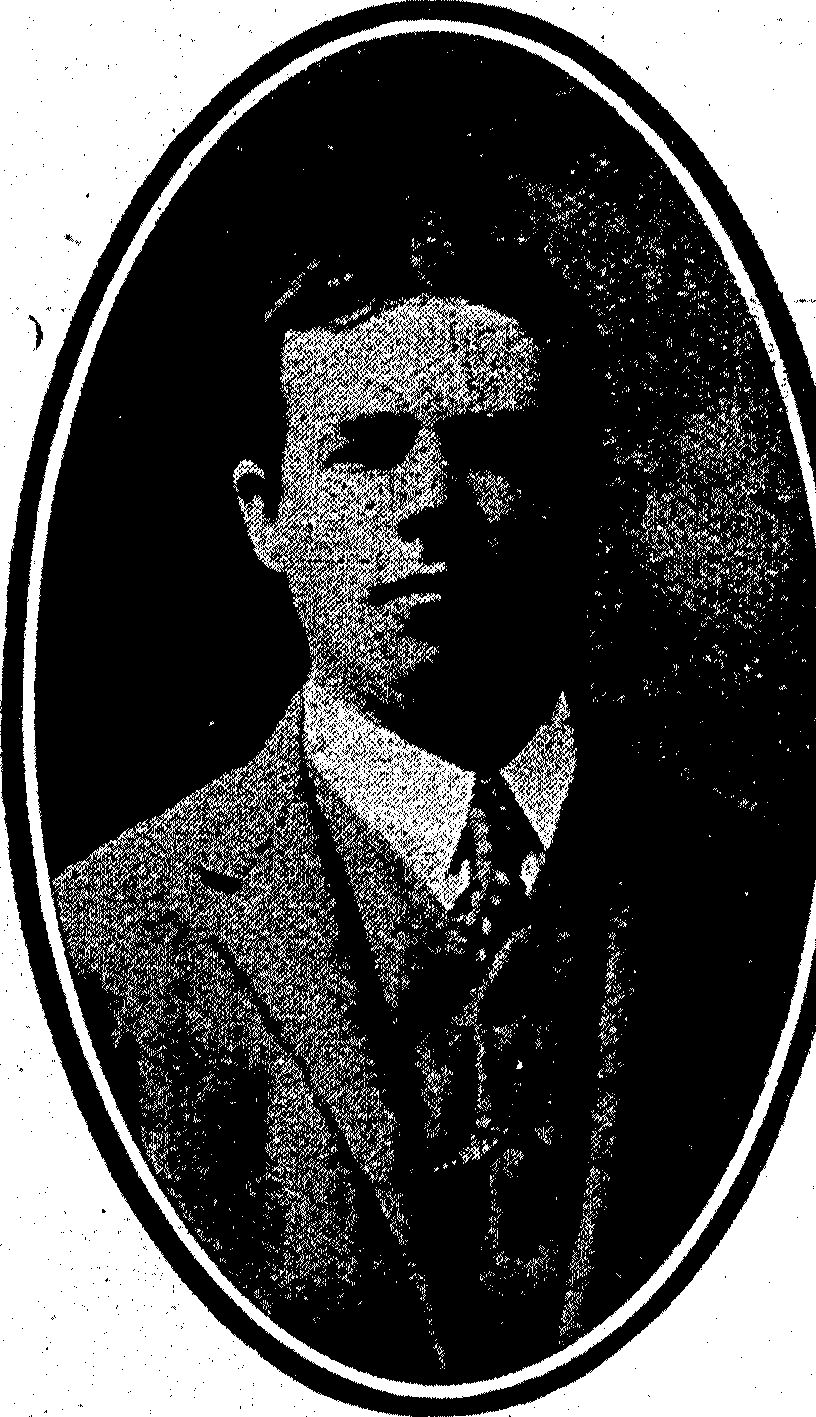

New Zealand Herald, 19 June 1907

Otago Witness, 3 July 1907
This interesting mention of the “olio” was an old theatrical entertainment trick for warming up the audience with a couple of stooges who appeared in front of the curtain before the start of the show.

Referee, 10 July 1907
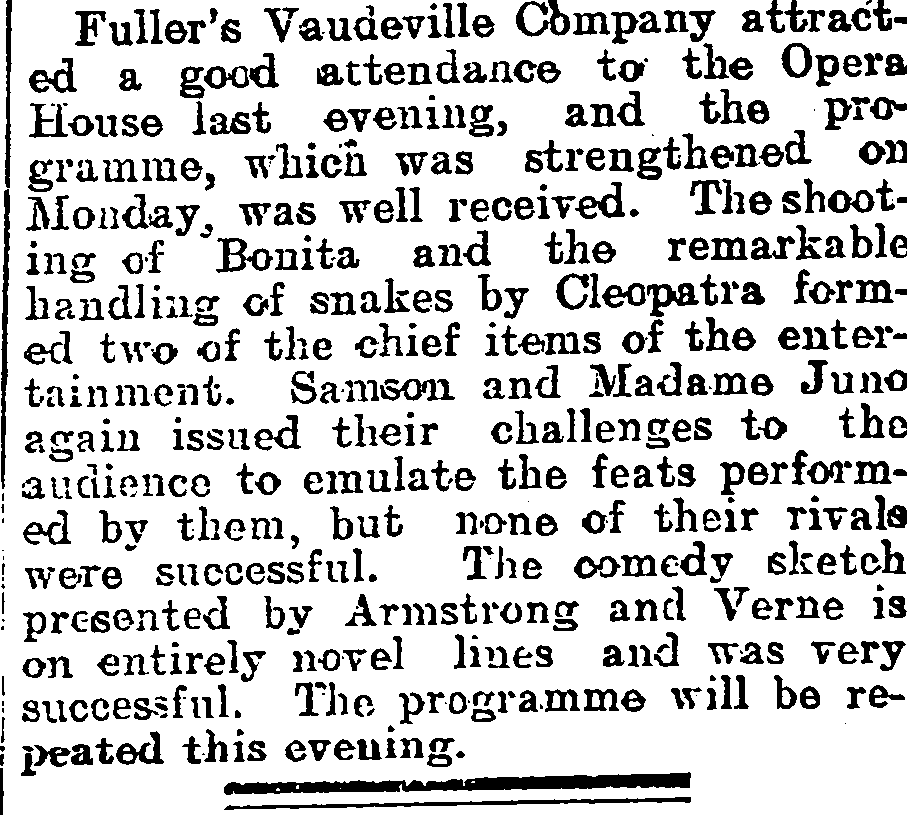
Wellington Star, 24 July 1907
The Fuller’s Vaudeville Company has such a talented cross section of performers, Bonita, the champion lady rifle shot, Cleopatra, the snake charmer to Sampson and Madame Juno issuing challenges to strong men in the audience; the entertainment value of the Fullers offering must have assured their success.
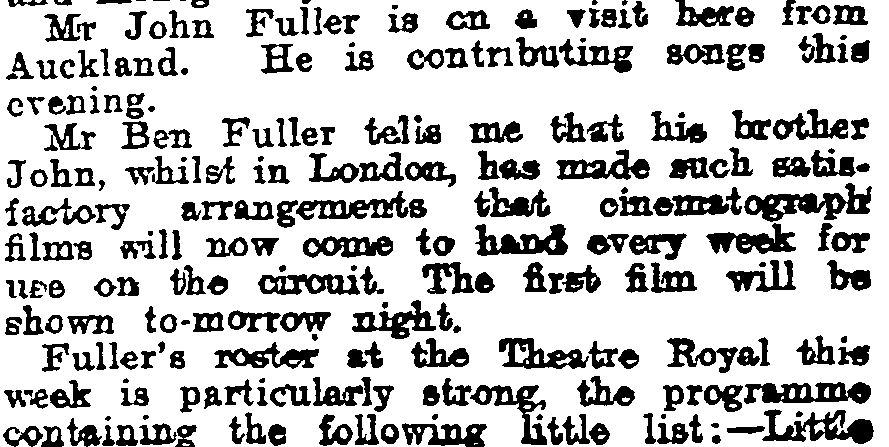
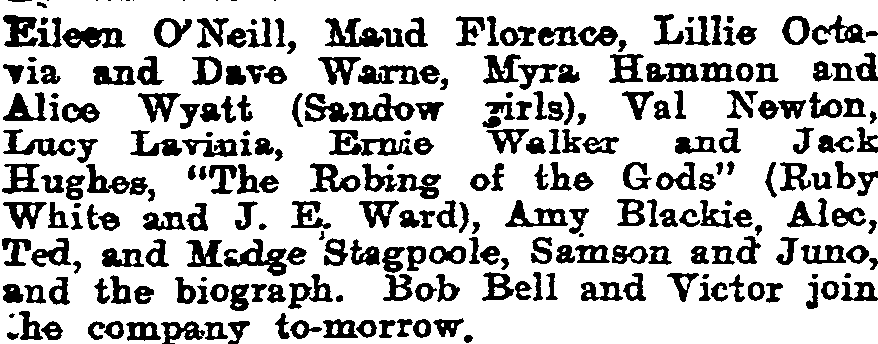
Otago Witness, 24 July 1907

Australian Star, 3 August 1907

Referee, 7 August 1907

Referee, 14 August 1907
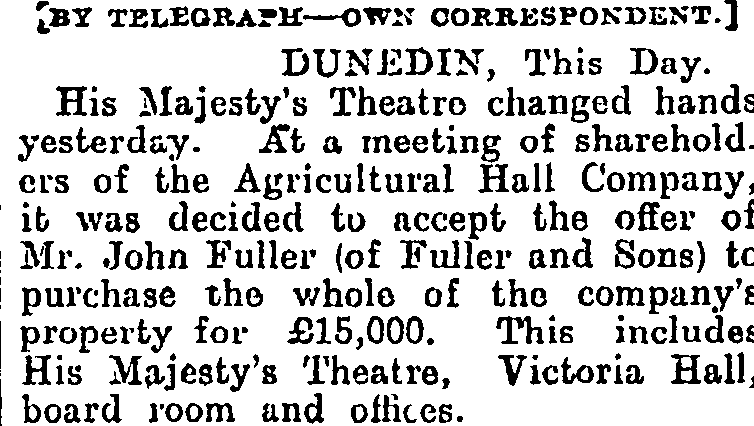
Evening Post, 23 August 1907

Referee, 27 August 1907

Referee, 28 August 1907

Sunday Sun (Sydney), 15 September 1907

Punch, 12 September 1907

The Sun (Sydney), 15 September 1907
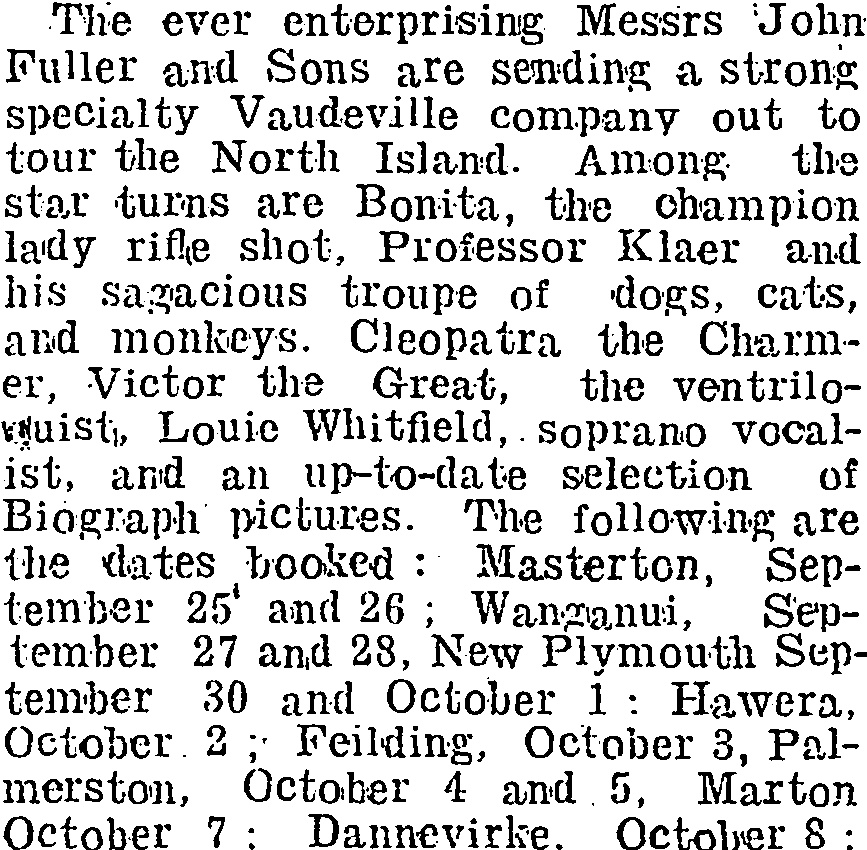
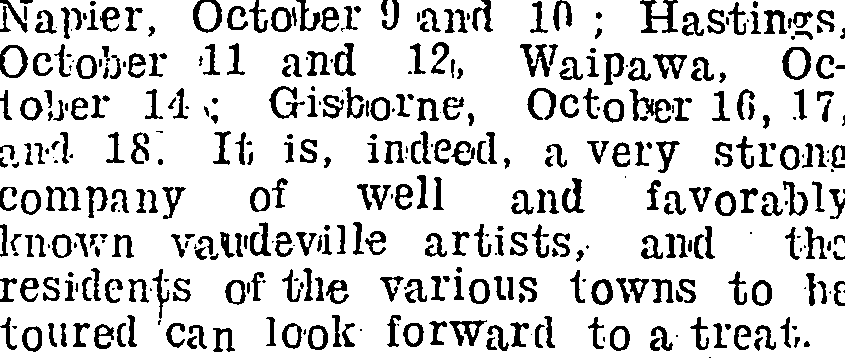
New Zealand Truth, 21 September 1907
The Fullers sent a strong specialty Vaudeville Company on tour to the North Island, among their star performers were, Bonita the champion rifle shot, Professor Klaer and his sagacious troop of dogs, cats and monkeys, Cleopatra the Charmer, Victor the Great, a ventriloquist and Louis Whitfield, soprano vocalist. These acts were supplemented with an up-to-date selection of their very popular eight minute biographical films.

Referee, 9 October 1907

Referee, 11 October 1907

Truth (Sydney), 20 October 1907 (badly faded)
“Ben Fuller has purchased the Australian biograph rights of the Squires Brock boxing match. Won’t take long to run the film off, unless there is a lot of preliminary padding,”
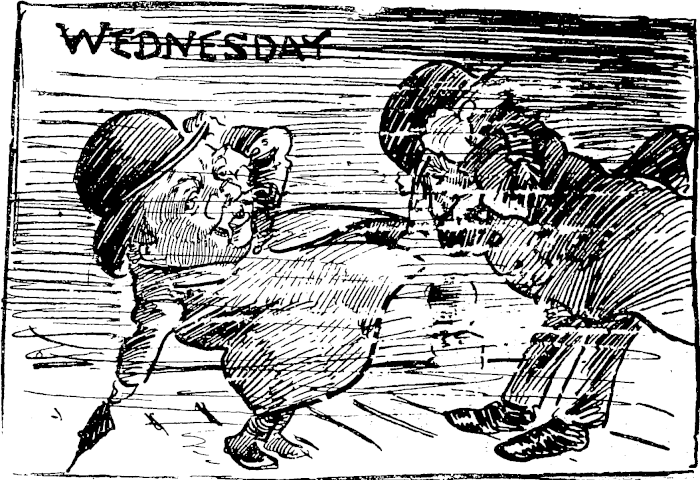

Observer, 26 October 1907

Boxing Truth, (Sydney), 19 October 1907

October 18, Shanghai, China, John Fuller Jnr’s World Tour 1907, page 80
Hettie Shellenhamer, Johnny’s sister and her husband John greeted Johnny and Gertie Fuller’s arrival on the wharf “all in black, a very drawn face and behold to my surprise she had evidently swallowed a football, which is expected to arrive Dec 12th or thereabouts.” They were in a bad way, with the tragic news that their little daughter Lydia Shellenhamer, who had been born about a year earlier, had died of cholera. Not only that, but John, the former head barman and caterer for Levies had taken a better paying job at the Shanghai Kursaal, called the Alahmbra, with a gaming parlour going on upstairs and things had not worked out well; the hours were particularly difficult to manage with a family to look after. Later business fell away in a downturn and John was expected to take less money.

October 18, Shanghai, China, John Fuller Jnr’s World Tour 1907, page 81
Worse was to follow when John moved to Chifu to run his own hotel, with the expectation that the U.S. Fleet would be in town for several months, however, the sailors were prevented from leaving their ships and John’s new business lost money and he went broke. “So you see what with Hettie ‘being that way again’, no prospects appearing on the horizon for John, they were in a damnable dilemma as Shanghai offers no escape for anyone when once out of a job”, these were chilling words indeed written by Johnny Fuller in his diary.

October 18, Shanghai, China, John Fuller Jnr’s World Tour 1907, page 82
I was proud to read how my Grandfather Johnny Fuller took things into his own hands and offered John Shellenhamer a job in New Zealand and to help his sister return home. Johnny was an astute judge of character and he knew that John Shellenhamer had the talent and ability to be a manager and it didn’t take long for John Shellenhamer, reinvented with the less German sounding surname Hamer, to prove he was a ‘good bet’ once he and Hettie moved back to New Zealand.
Johnny writes, “Shanghai (and the Far East generally) is a hot-bed of Cholera and fever and no place for white people. I considered it my duty to our own flesh and blood, to make an effort to get John and Hettie to a civilized country and I offered John, subject to the firm’s ratification, a job as manager for one of our shows during Dad’s absence….”

Referee, 6 November 1907
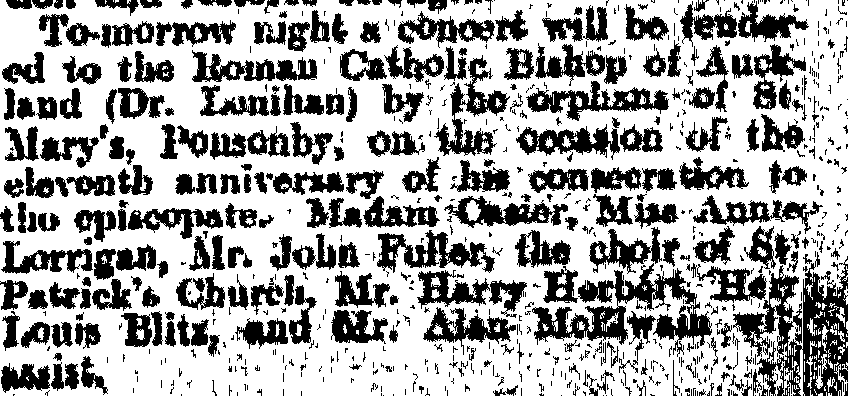
New Zealand Herald, 14 November 1907
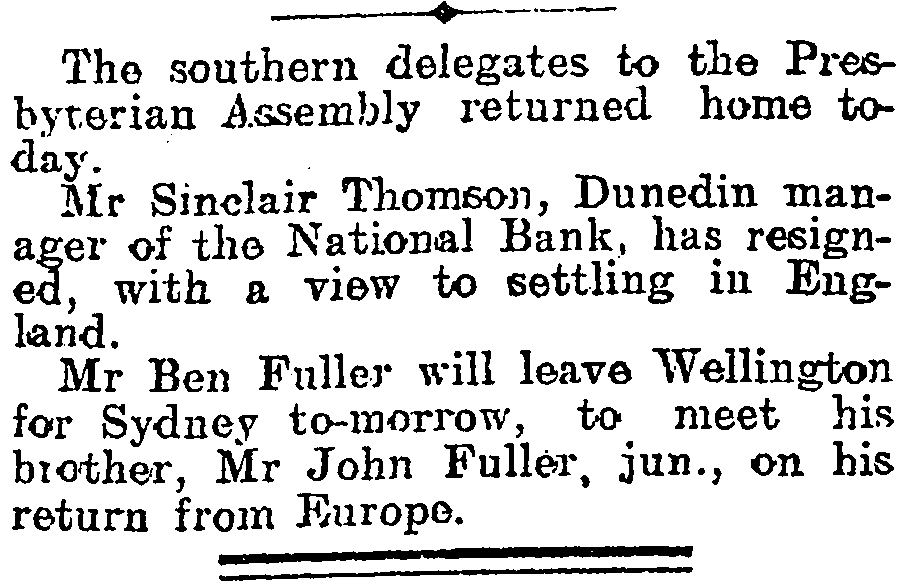
Wellington Star, 14 November 1907

Truth, 24 November 1907
It was impressive to see that Ben’s wife Lily Fuller had good business skills and was well and truly involved in the Fuller fold.

Mr. and Mrs. J Fuller, Saloon Passengers, aboard the Nikko-Maru, Tokyo, Japan, via ports to Sydney 29 November 1907

Examiner, 28 November 1907

New Zealand Truth, 4 January 1908
It is incredible to read this article and see that John Fuller Jnr. predicted the threat of war with the Japanese with these interesting words, “the future possibility of the warlike Jap.” As many as 30 years before this threat actually eventuated. I am in absolute awe of Johnny perception and understanding of the social mores of his time.
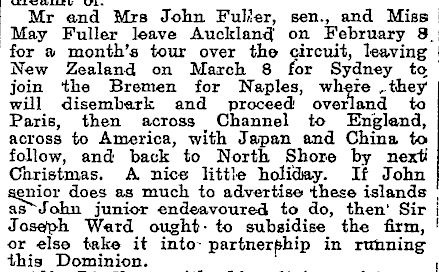
Otago Witness, 8 January 1908
John, Ma and May Fuller leave for their world tour only a short time after Johnny and Gertie returned. I have often wondered what happened to the small children in the family during these travels. John and Gertie had left their four year old daughter Phyllis at home and now John and Ma were leaving their nine year old son Raymond behind. It is probable that the Fullers had a nurse to care for the children and that Phyllis may have stayed with her grandparents in Auckland while Johnny and Gertie went on their world tour.
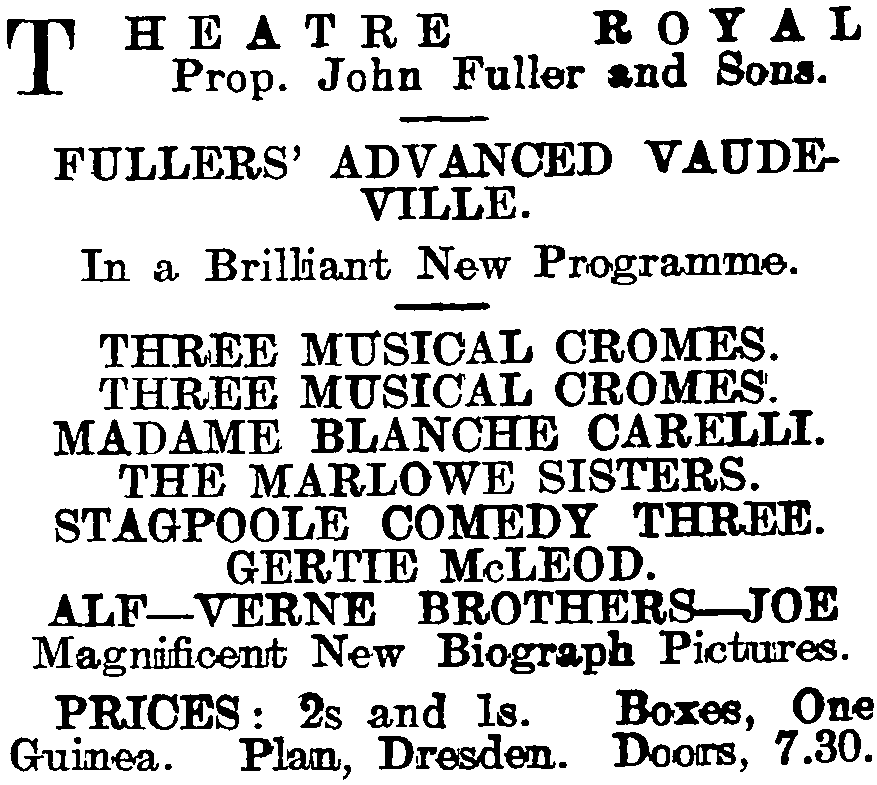
Theatre Royal, Wellington, Free Lance, 11 January 1908
YELLOW PERIL TERRORS
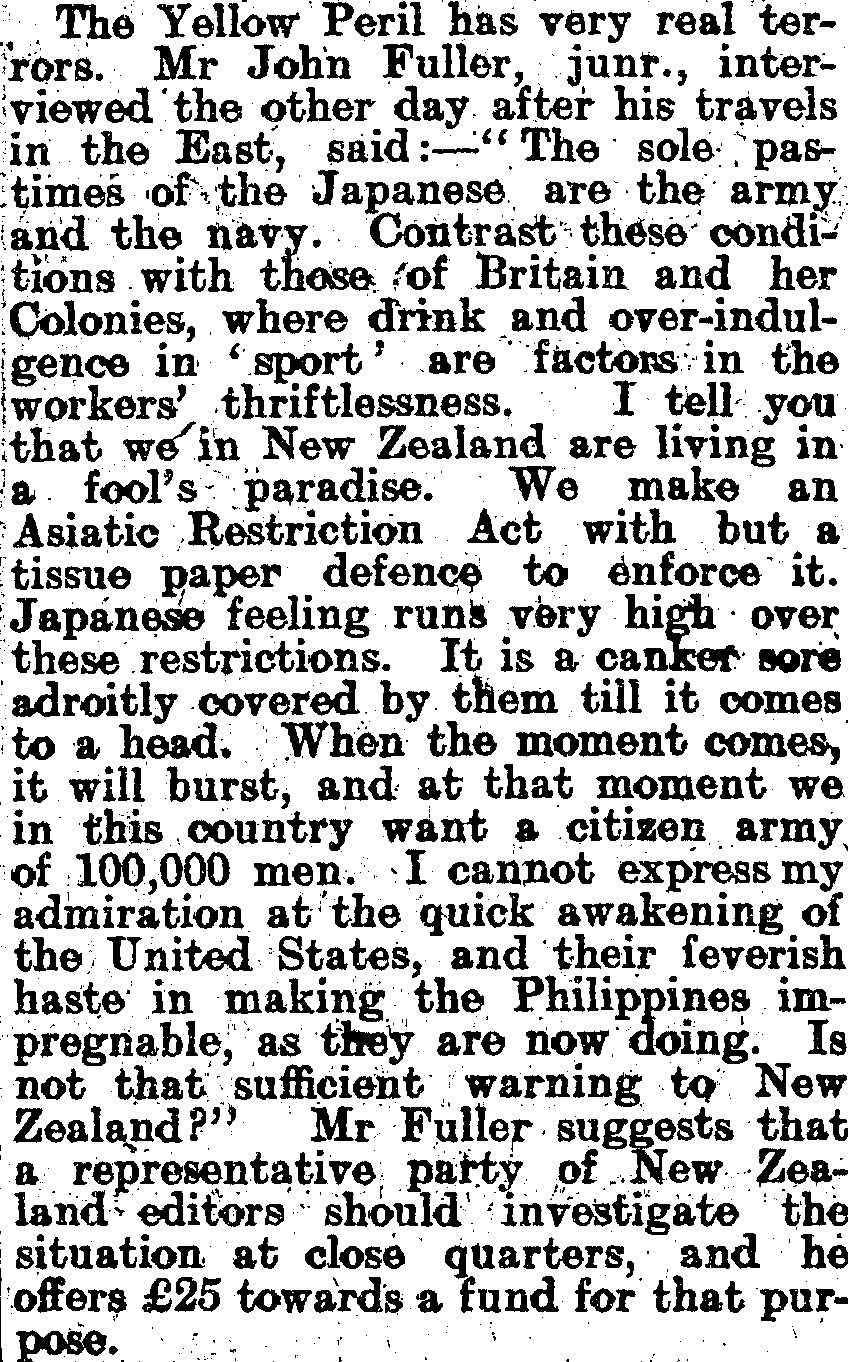
Marlborough Express, 15 January 1908
If only the New Zealand, Australia and for that matter the United States had paid more attention to the rising forces of Japan threatening peace in the Pacific region. It is astonishing and very illuminating that my Grandfather predicted this conflict.
Sadly, it was the weakening of Europe during World War II, which emboldened Japan to go it alone in the Pacific and stage an horrific, stealth bombing attack in the early morning of 7 December 1941, wiping out much of the US Fleet in Hawaii. No doubt, without the United States entering the Second World War at this stage, the security of Australia and New Zealand would have been compromised, to the point that they may have become Japanese dominions.
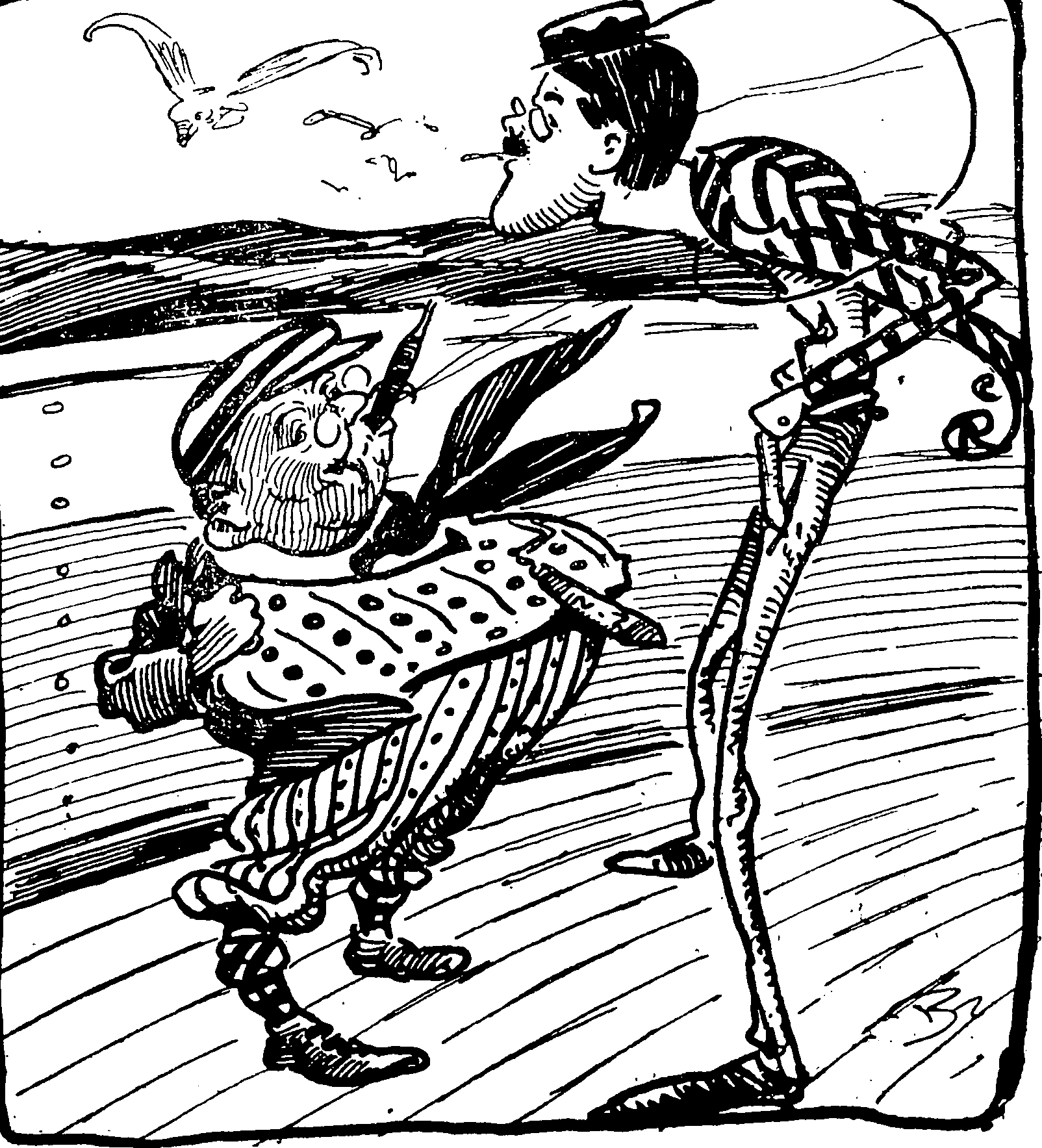

Observer, 8 February 1908
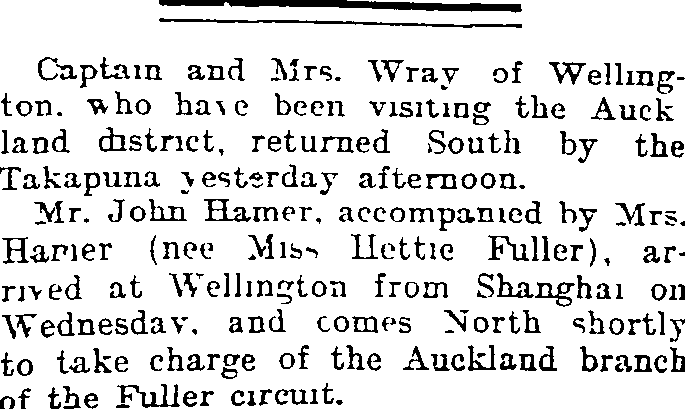
Arrival of the Hamer Family, Auckland Star, 7 March 1908
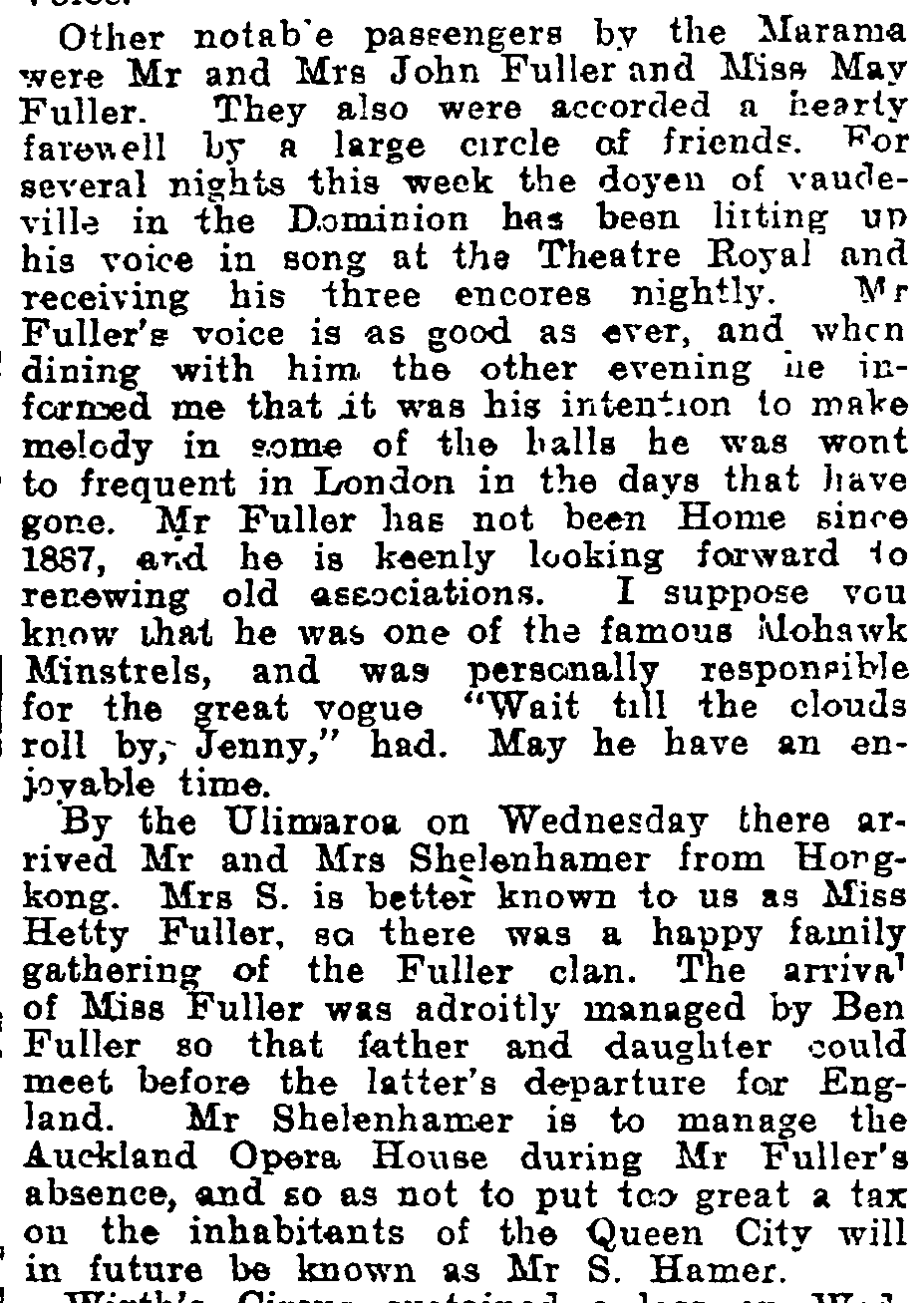
Otago Witness, 11 March 1908
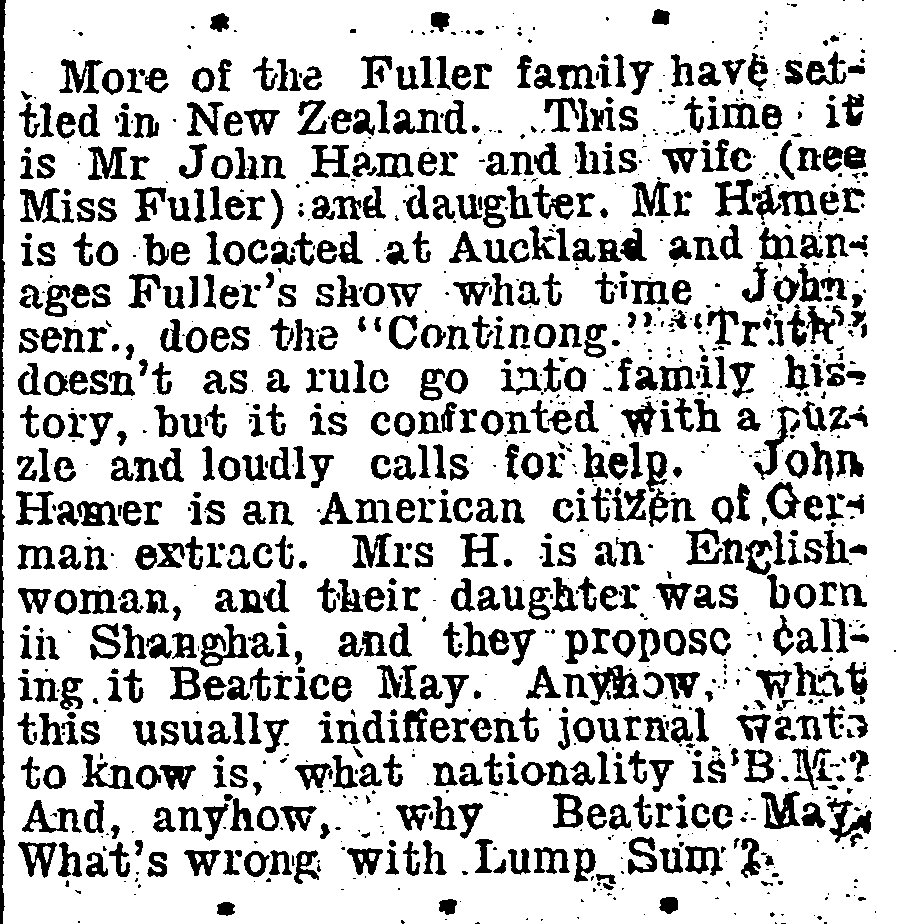
New Zealand Truth, 14 March 1908
John Shellenhamer, reinvented as John Hamer, to tone down his German sounding name, is now managing the Fuller’s Auckland Theatre domain.

Photographic Portrait of John Shellenheimer, 1908, courtesy of John Stuart and Virginia Telfar, grandchildren of John and Hettie Hamer

Star, 1 April 1908
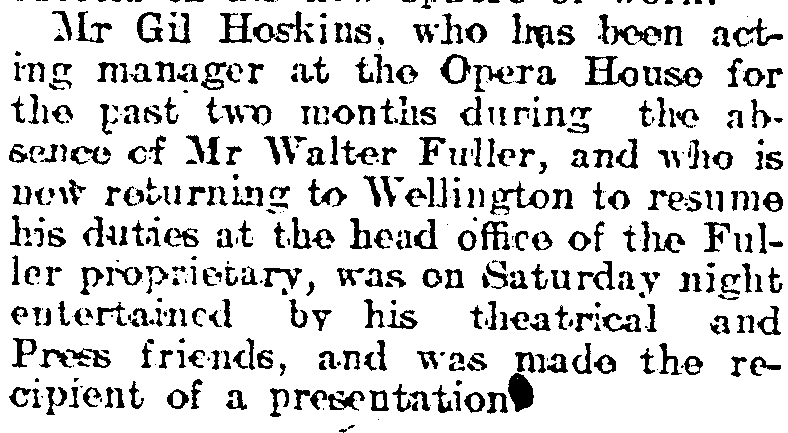
Press, 6 April 1908
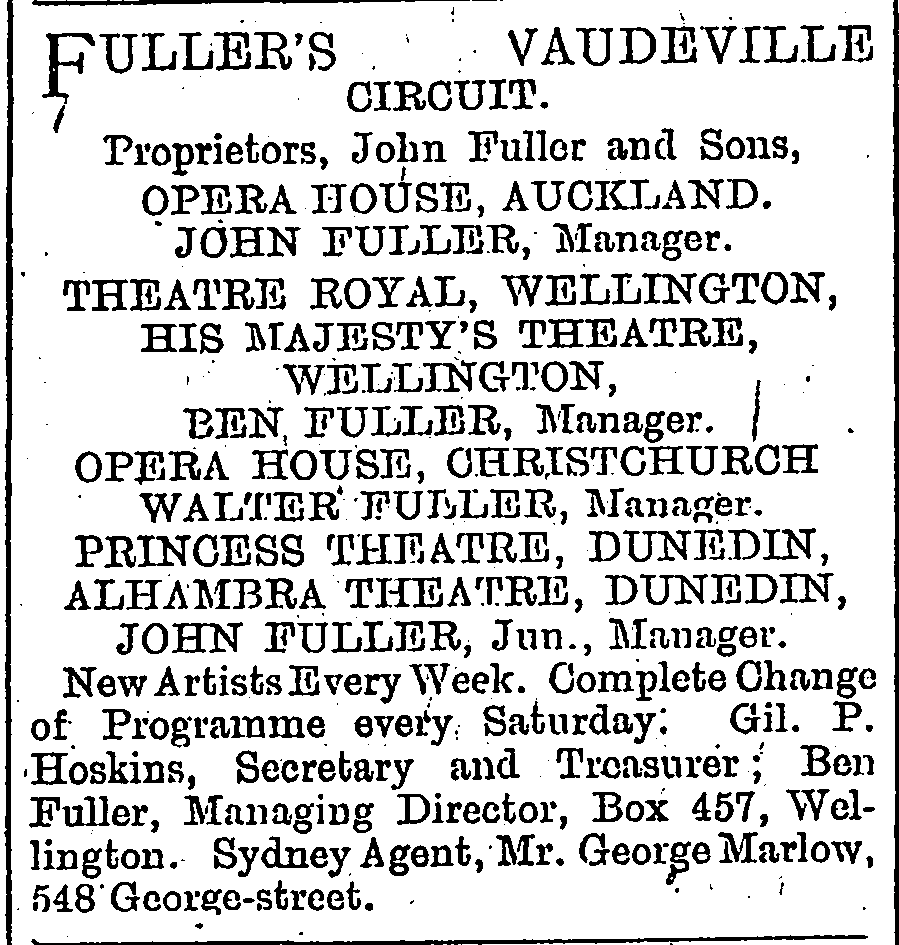
New Zealand Truth, 11 April 1908
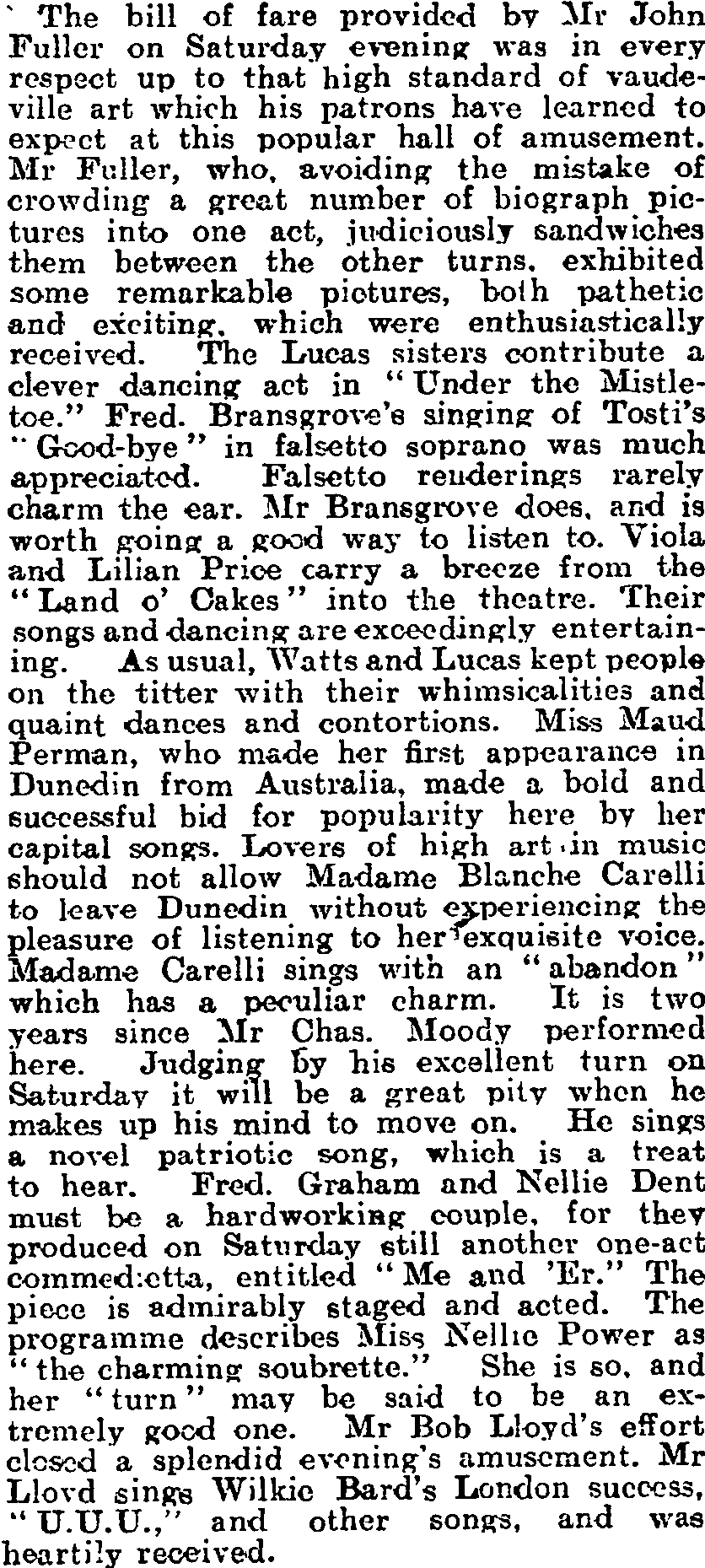
Otago Witness, 15 April 1908

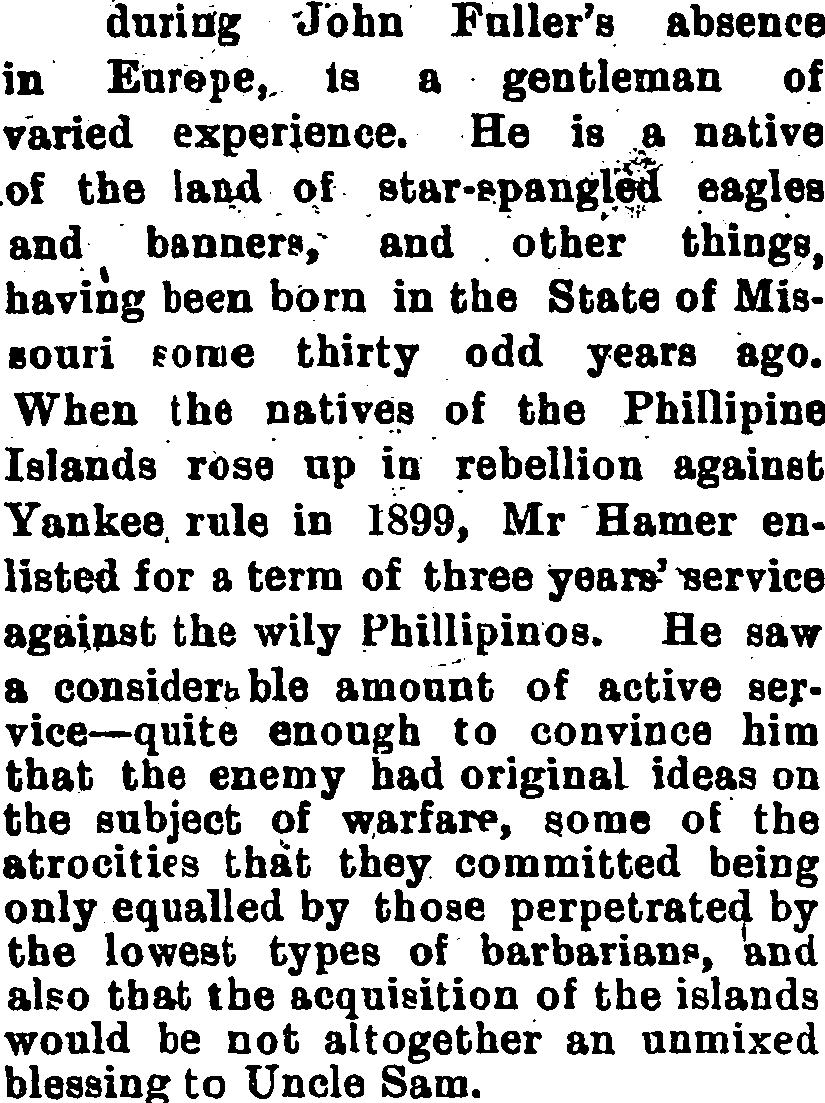
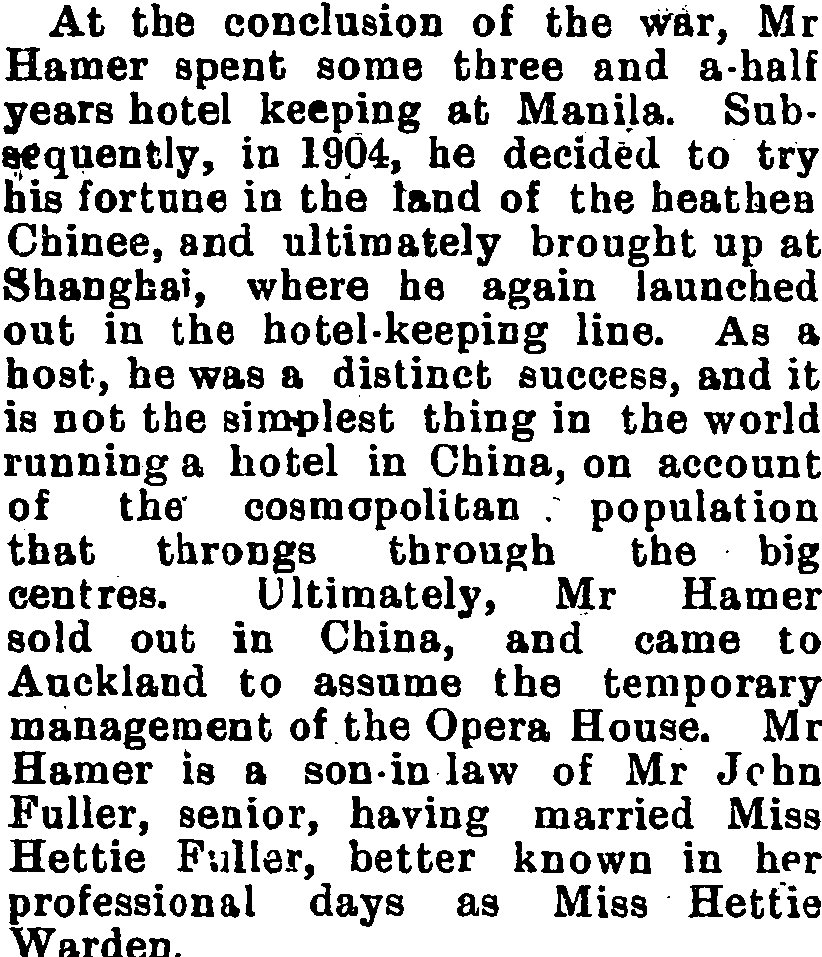
Observer, 25 April 1908
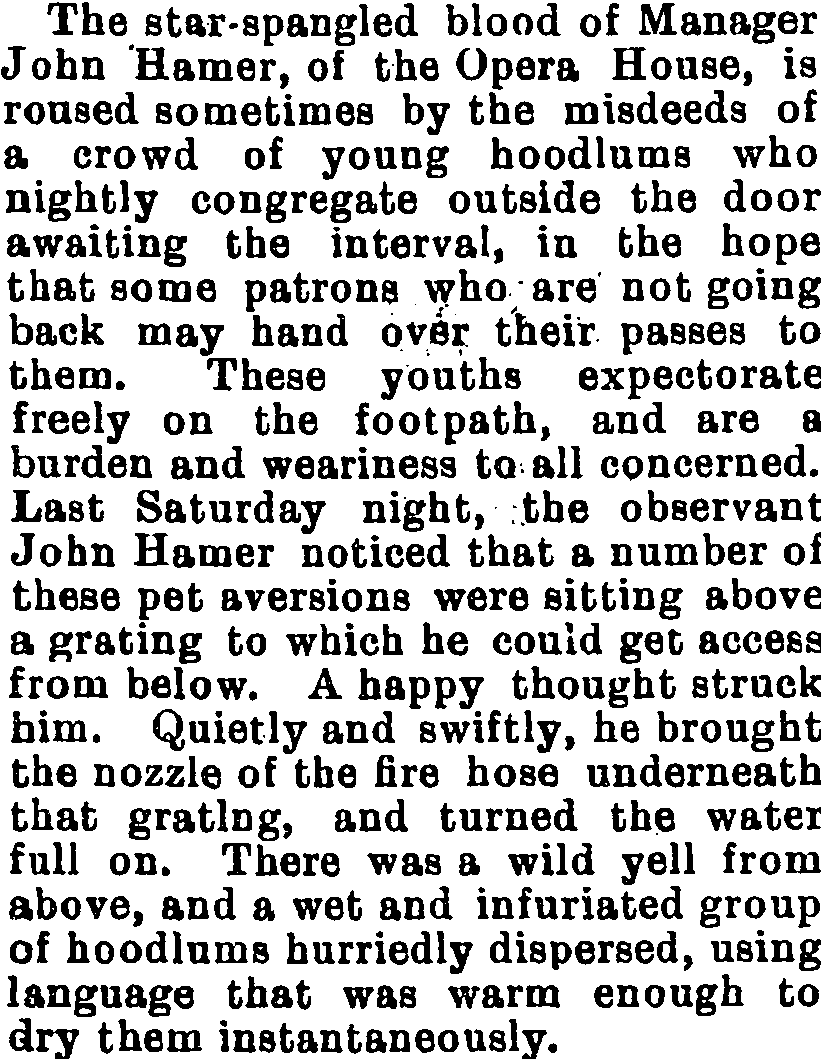
Observer, 30 May 1908

May Fuller and John Fuller Snr. Riding Through the Gap of Dunloe, Ireland, 2 July 1908, near Killarney, image courtesy of The Dickson’s Photograph Album, kindly provided by Emily Dickson, a grand-daughter of May Fuller.
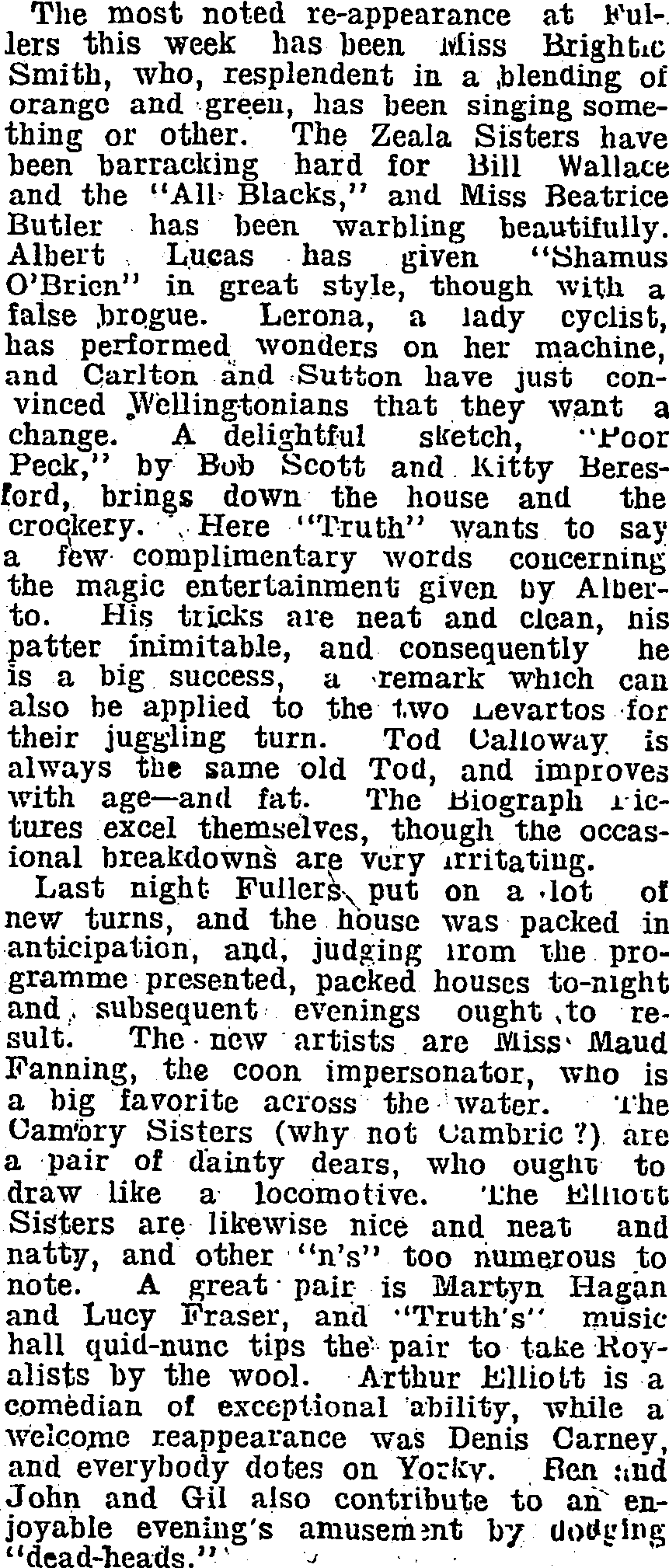
New Zealand Truth, 1 August 1908
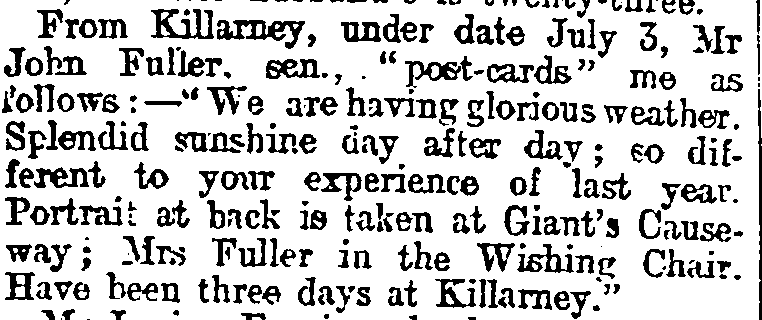
Evening Star, 18 August 1908
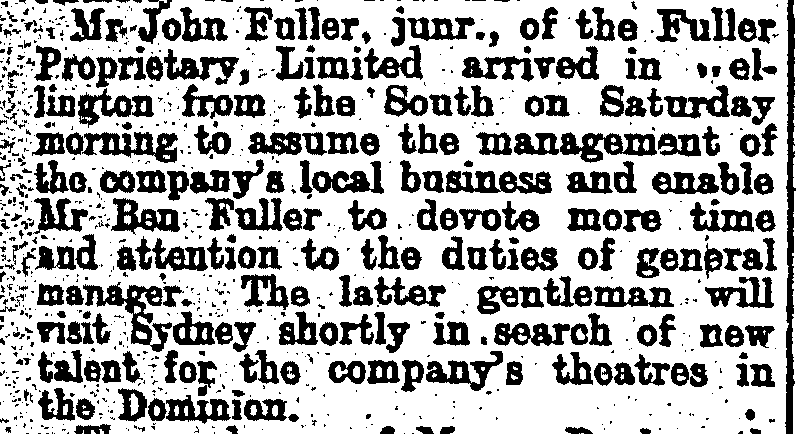
Wellington Press, 20 July 1908
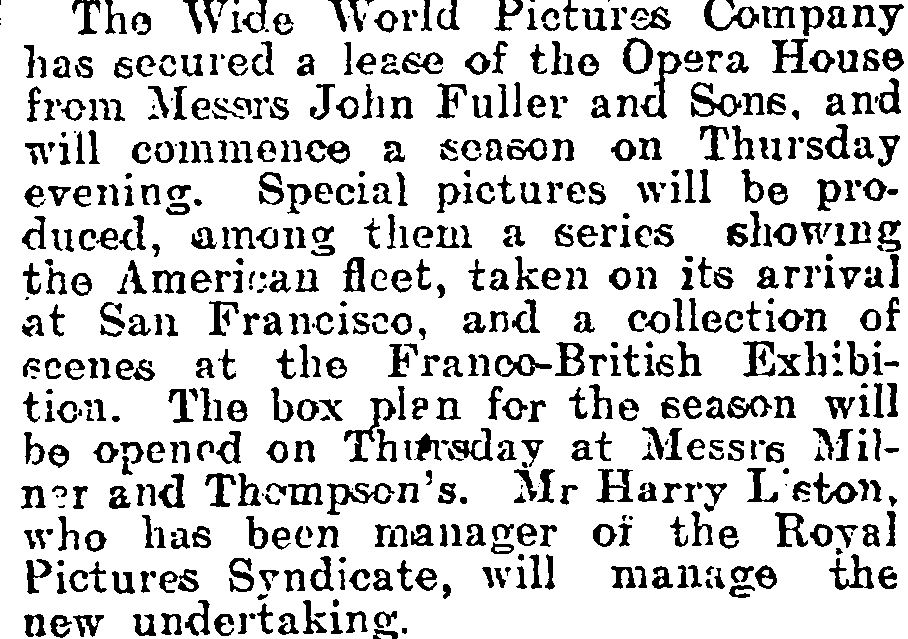
Star, 28 July 1908

Otago Witness, 29 July 1908

John and Emily Matilda “Ma” Fuller and their daughter May, aboard the Kronprinz from Southampton to New York, 28 August 1908

The Theatrical, 19 August 1908

Press, 10 August 1908
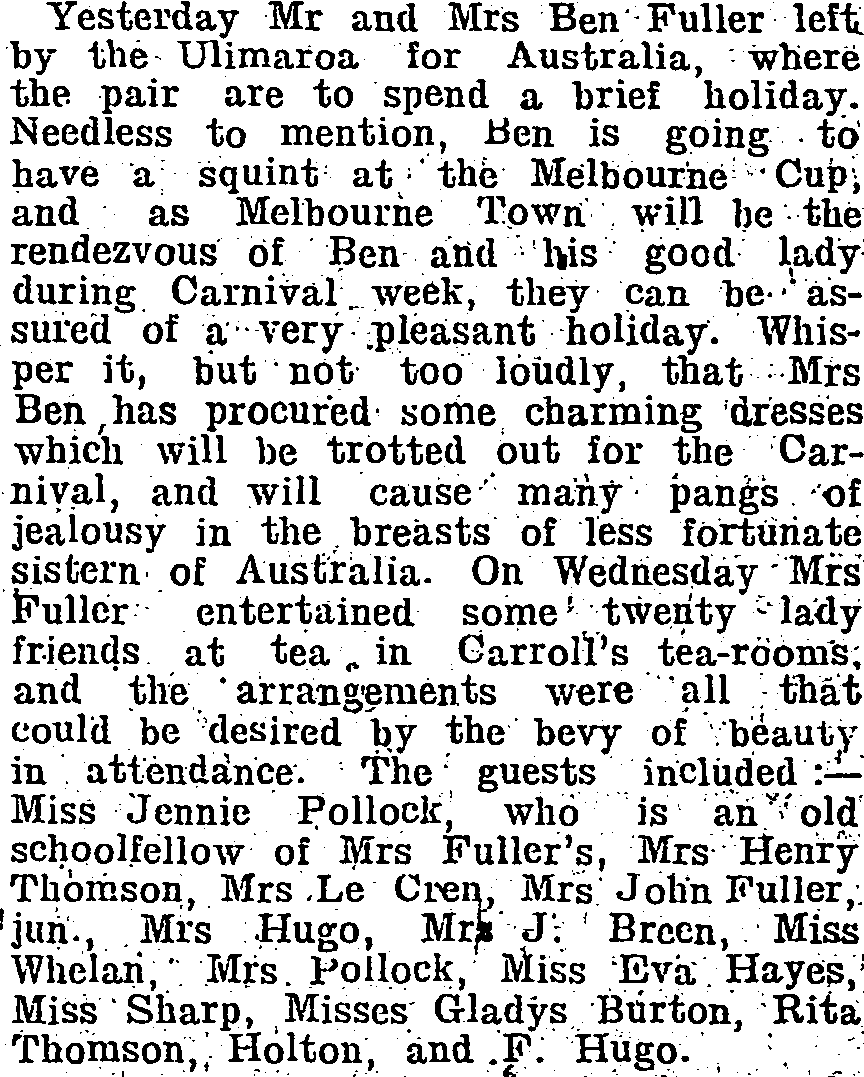
Truth, 24 October 1908
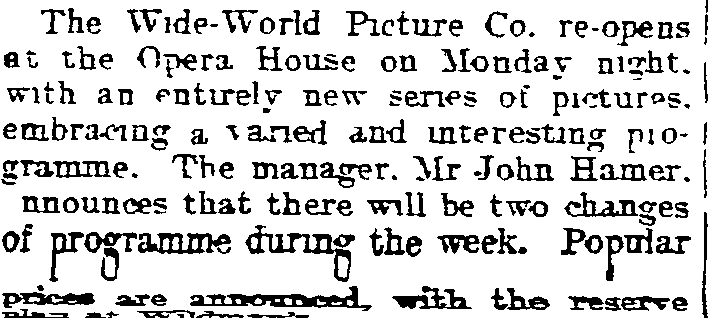
Auckland Herald, 31 October 1908
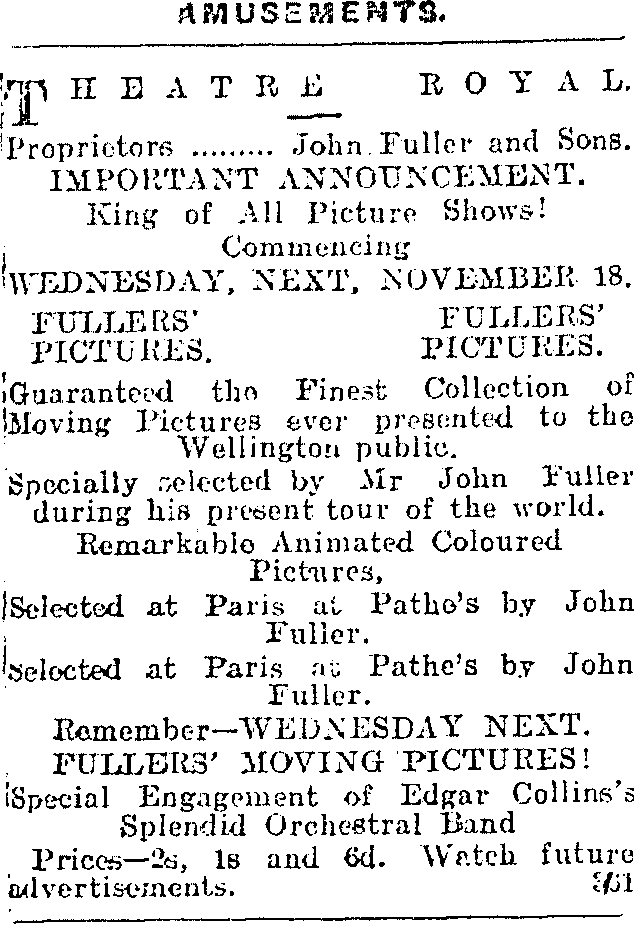
New Zealand Times, 14 November 1908
The Fuller’s advertisements were proclaiming their new selection of films purchased from Pathe’s of Paris.
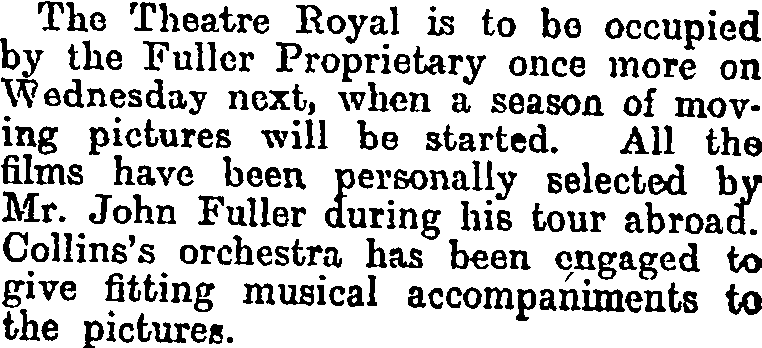
Evening Post, 16 November 1908
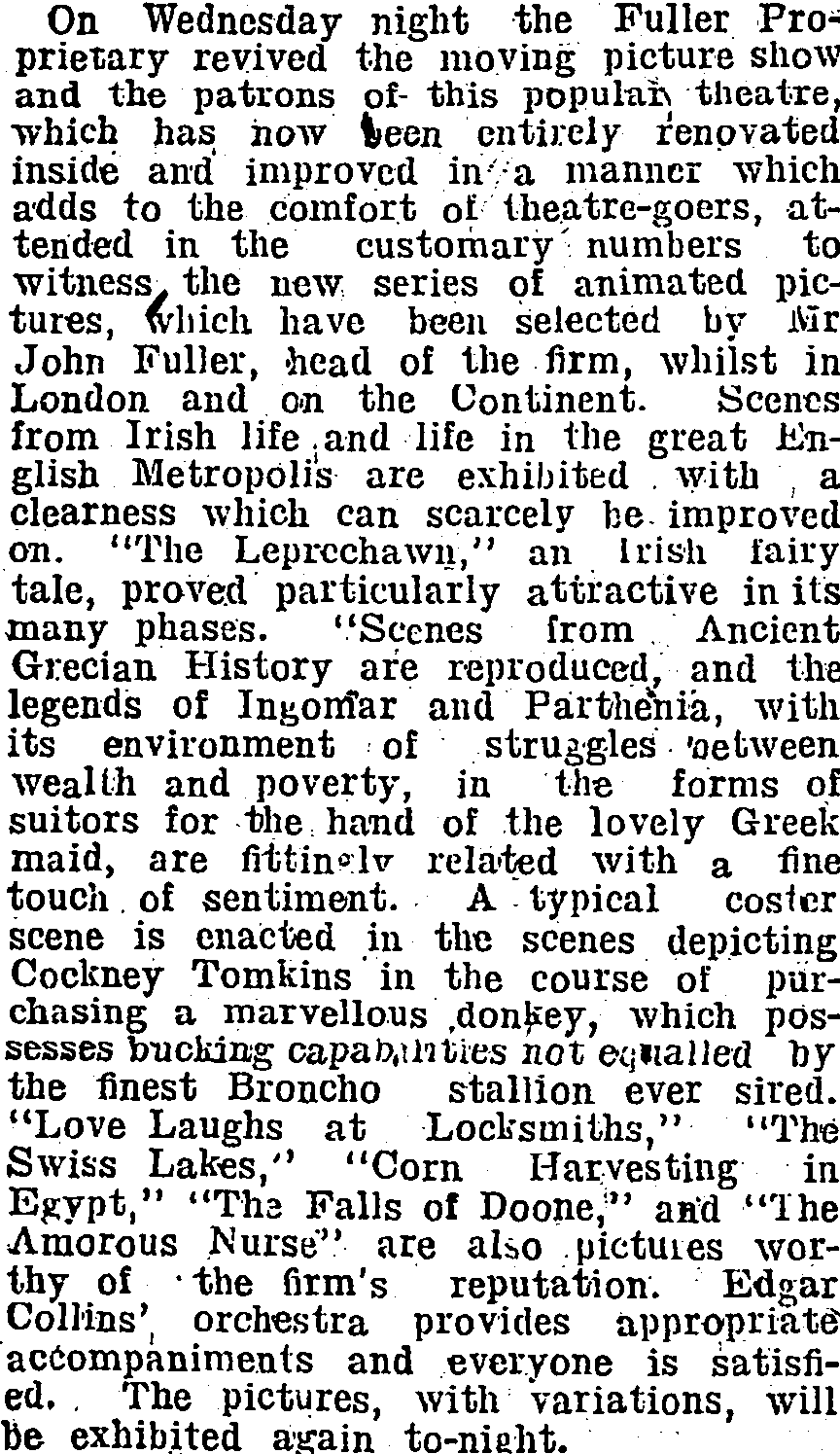
Truth, 21 November 1908
A large listing of the newest films showing in Fuller’s theatres. Scenes from Greek history and contemporary films Love Laughs at Locksmith, Corn Harvesting, The Falls of Doone and The Amorous Nurse were popular.

Referee, 25 November 1908
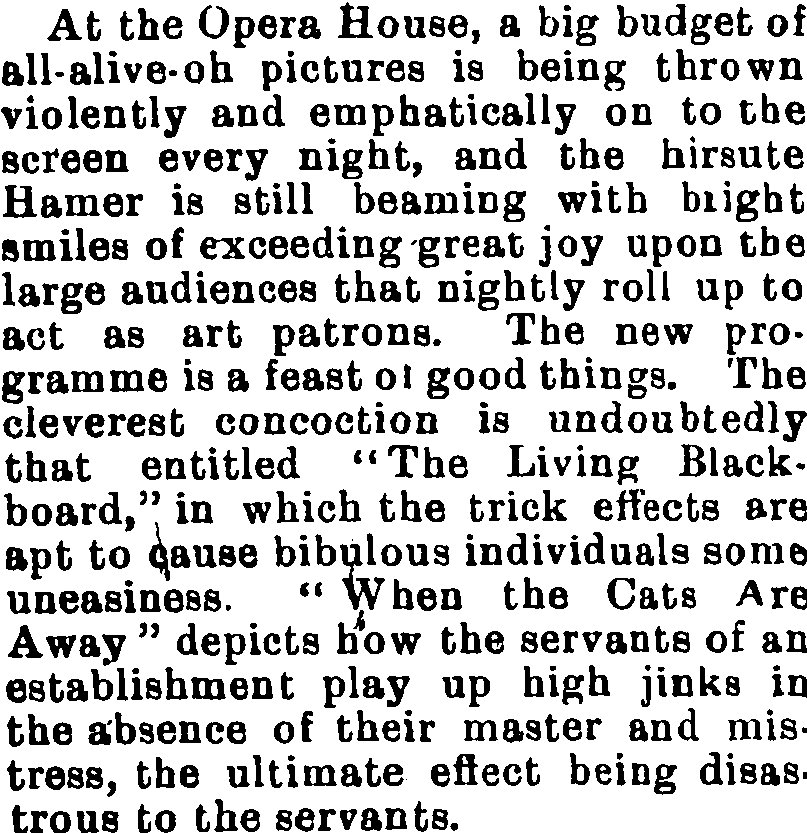
Observer, 28 November 1908
It is wonderful to see Fullers Theatres and newspaper critics providing reviews of their current movies.
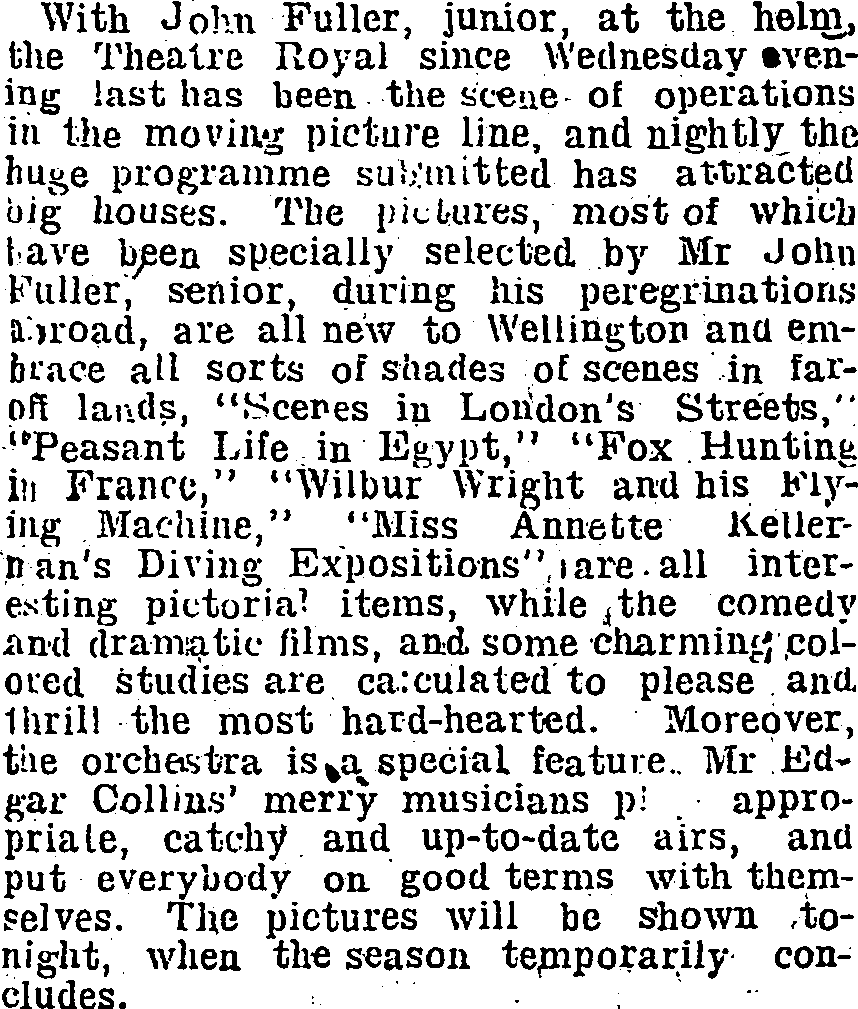
New Zealand Truth, 5 December 1908
Wellington was embracing all sorts of films, “Scenes in London Streets, Peasant Life in Egypt, Fox Hunting in France, Wilbur Wright and his Flying Machine and Miss Annette Kellerman’s Diving Exposition” were all popular. As was the live feature of Mr. Edgar Collins’ Merry Musicians.

Evening Post, 19 December 1908

Referee, 23 December 1908
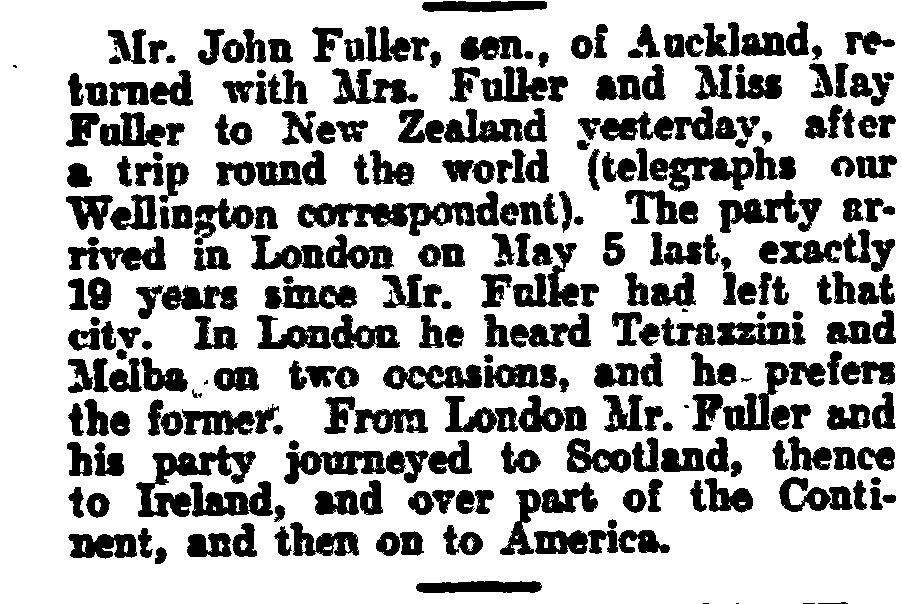
New Zealand Herald, 24 December 1908
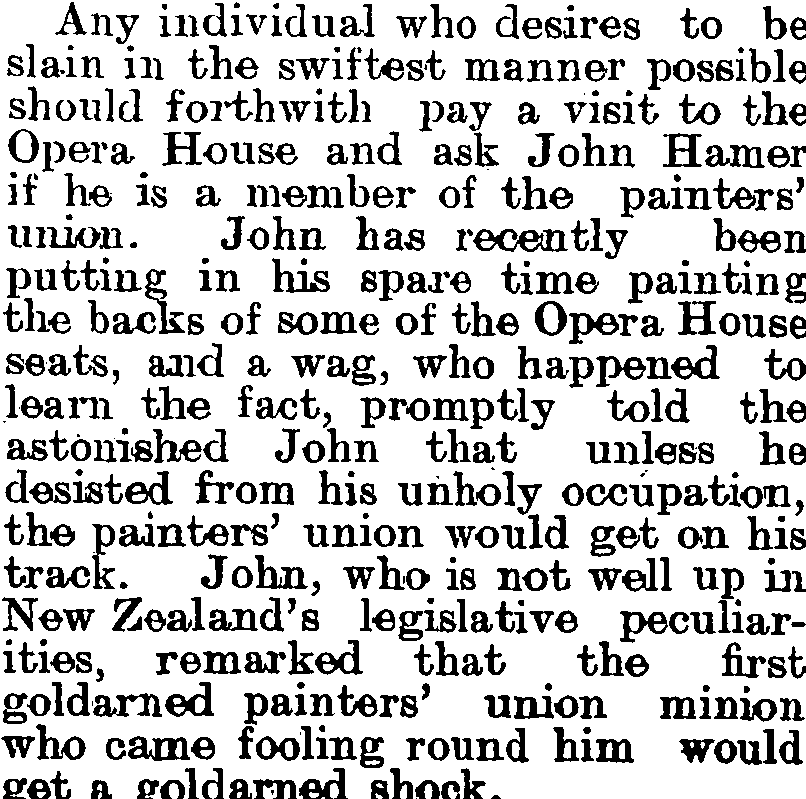
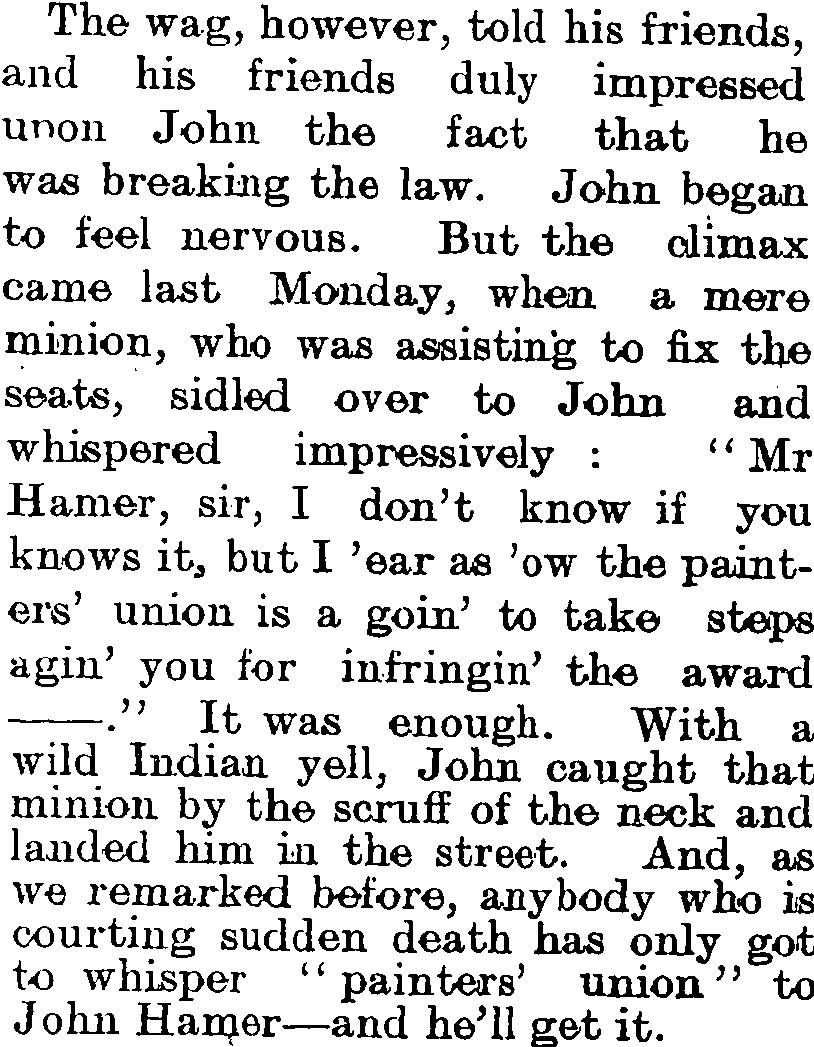
Observer, 26 December 1908
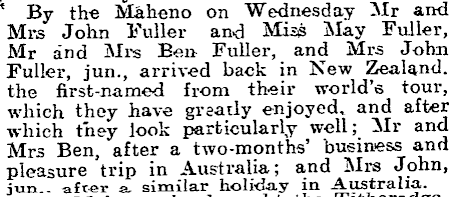
Otago Witness, 30 December 1908

Otago Witness, 30 December 1908

New Zealand Truth, 2 January 1909
The newspapers were always keen to interview the Fullers on their return from their World Tours. John Fuller Snr. is upbeat, jolly and very honest about the highs and lows of his trip and very ready to compare favourably his own establishments in New Zealand with those on the Continent, in America and Japan. This column is an insightful expression of the freedom of speech enjoyed a century ago, when people had the ability to honestly reflect an opinion without the fear of “shutdown” or political correctness that is experienced so often in our modern world.
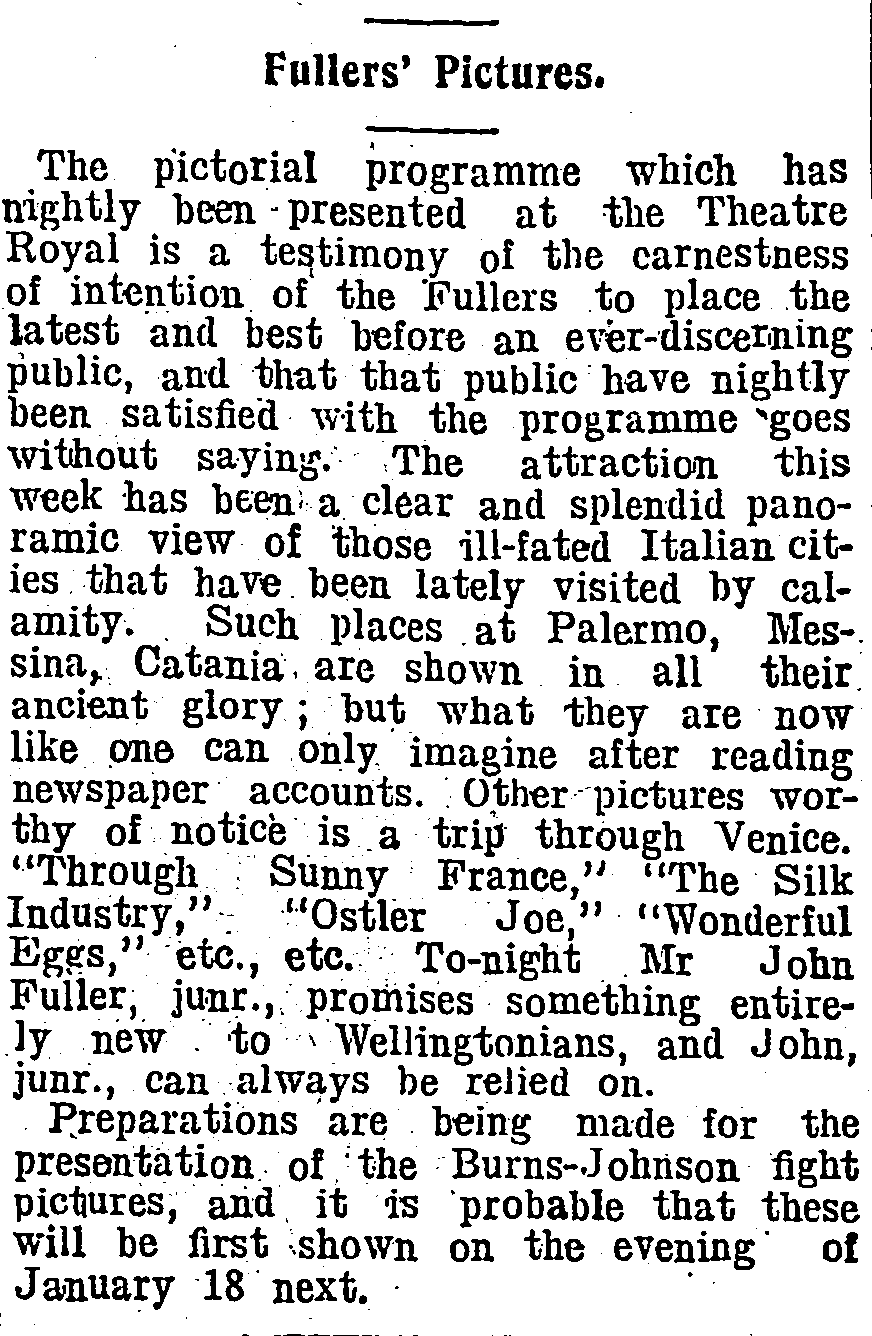
New Zealand Truth, 9 January 1909
Movies being popularly shown in the Fuller’s Theatres were of Palermo, Messina and Catania, reflected in their ancient glory, before the calamity of the recent earthquake. Trips Through Venice an Sunny France, the Silk Industry, Ostler Joe, Wonderul Eggs.
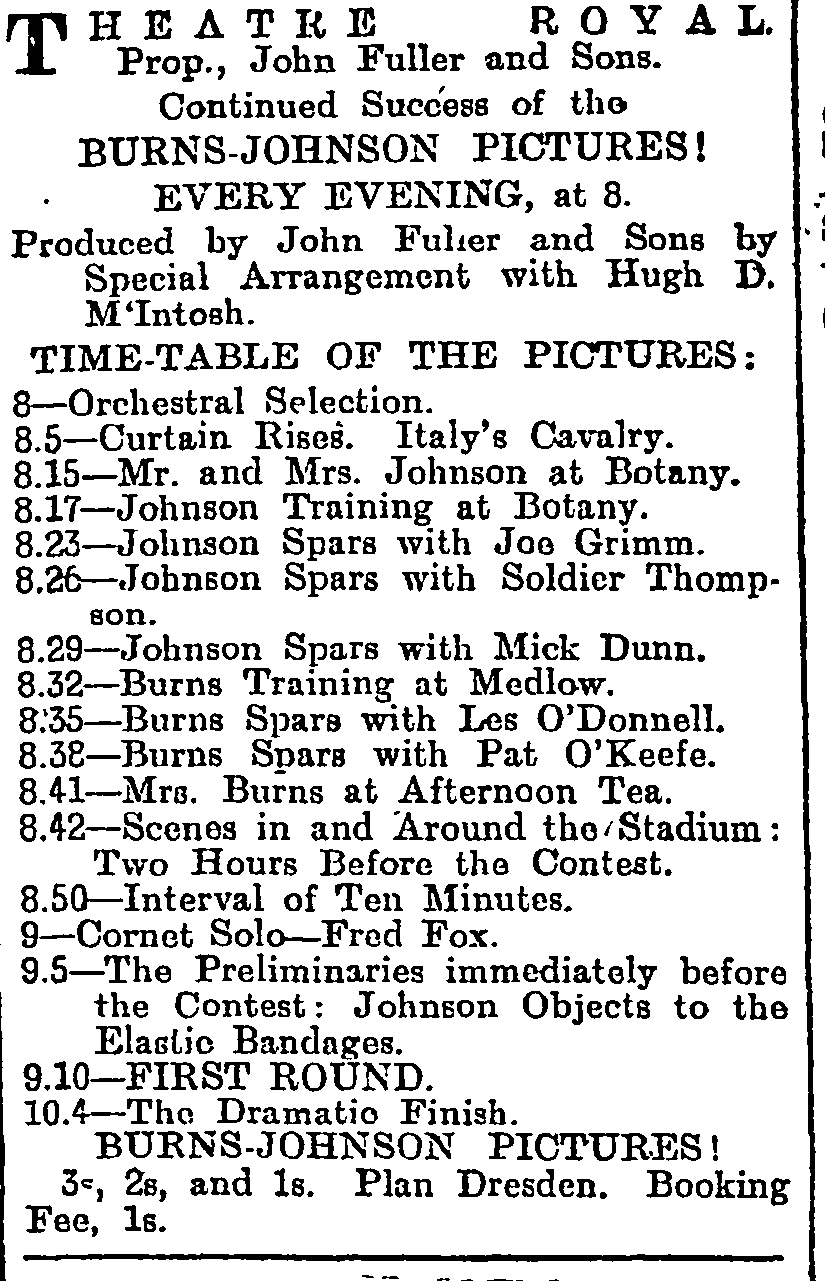
Evening Post, 23 January 1909
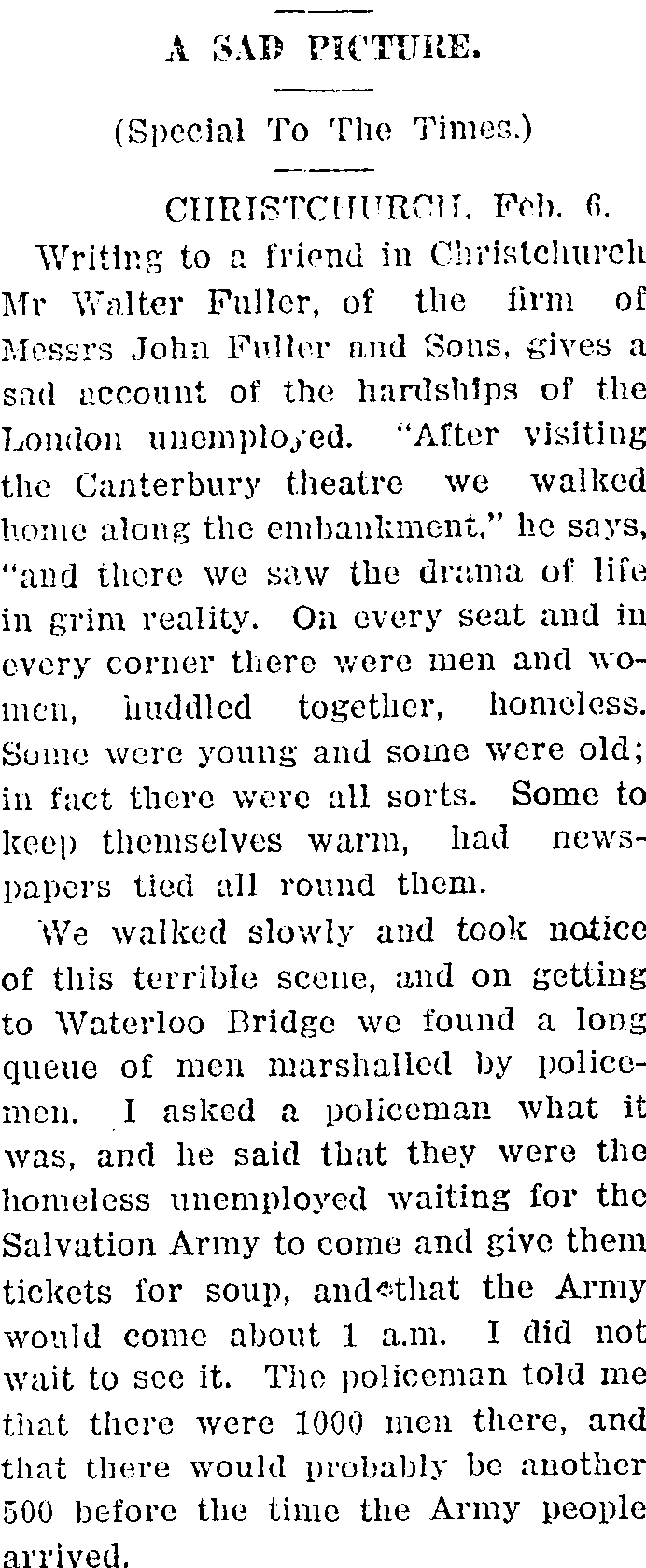
Southland Times, 8 February 1909
Walter Fuller’s sombre and heartfelt sorrow regarding the poor in London, reflects his sensitivity for his fellow man, knowing himself how poor his family had once been in London he must have appreciated the courage of his father to take on a job on the other side of the world and to later ask his scattered family to pack their belongings and catch the first ship to New Zealand.
The next page shows the shipping record for Walter and Dolly Fuller returning to Australia from England aboard the Aroya and I noticed that so typically Walter travelled in the second saloon class, even though he could have travelled first class all the way. This was his choice and it says so much about his less flamboyant personality than that of his younger brothers and also shows happiness in life with his own choices.

Walter and Dolly Fuller, 26 May 1909, London to Brisbane aboard the Aroya



Wanganui Chronicle, 11 February 1909
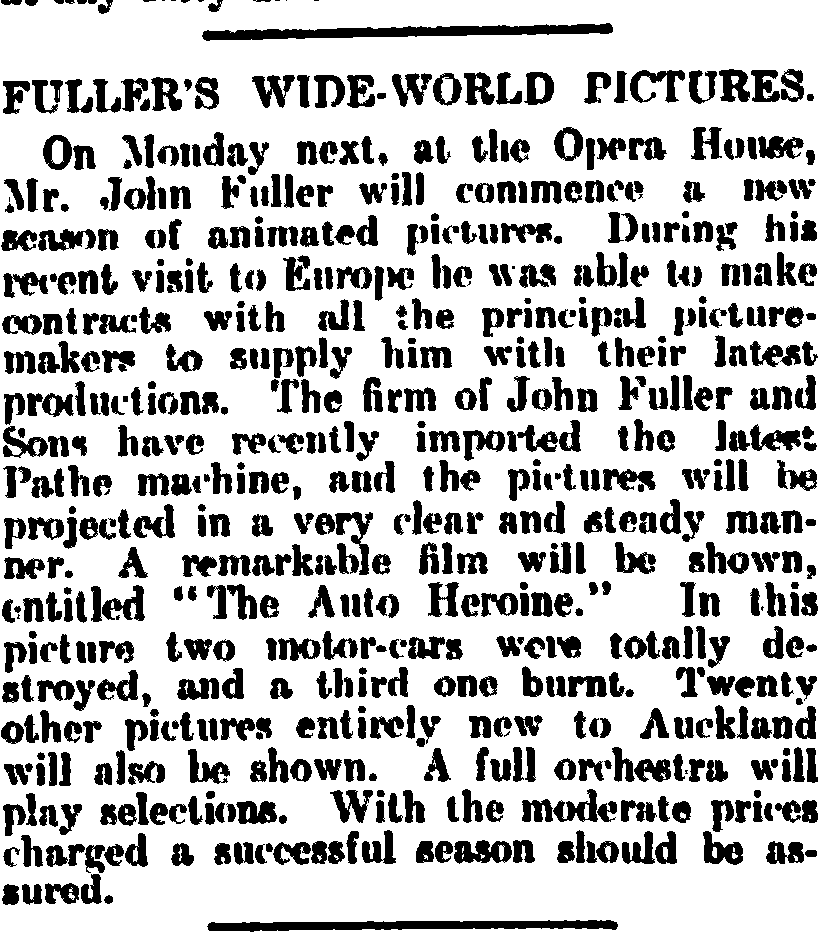
New Zealand Herald, 12 February 1909

Dominion, 18 February 1909
Johnny Fuller Jnr. was the master of the press release and here he sought to play down the dangers of theatre goers to his Fuller establishments in the wake of the Acapulco tragedy.
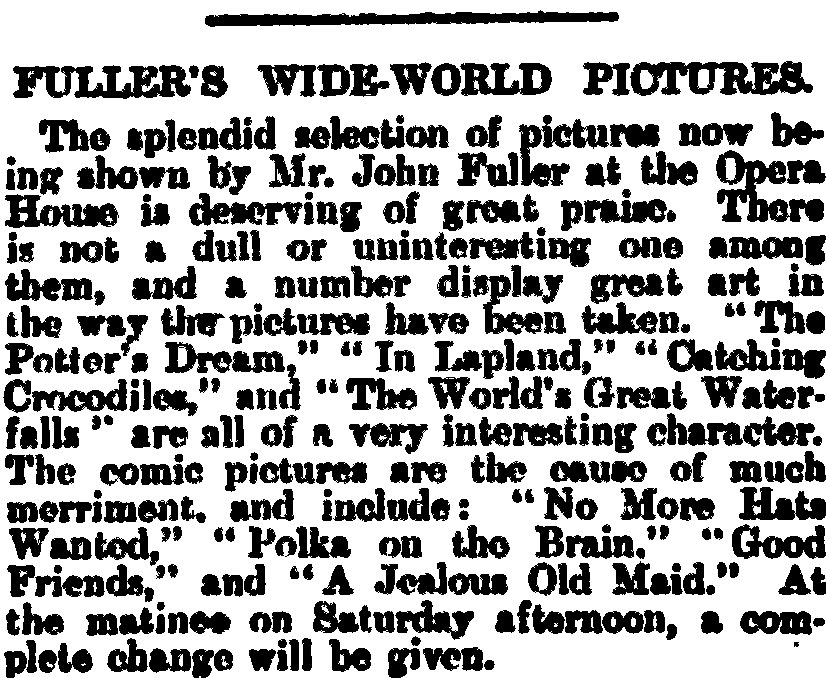
New Zealand Herald, 3 March 1909
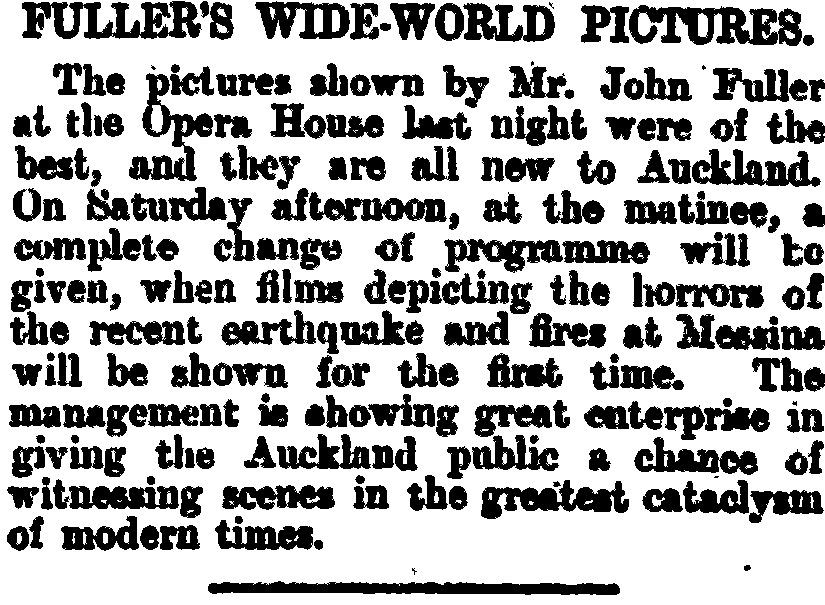
New Zealand Herald, 5 March 1909
Fuller’s Wide-World Pictures realised that disaster movies were popular amongst their audiences and that cataclysmic events such as earthquakes, firestorms and volcanic eruptions sold seats in their theatres. So did other popular events such as royal celebrations, overseas wars, breaking world news, intrepid explorers and their discoveries, mass murderers and their victims, the weird, the para-normal and the mysterious. To be honest, not much has changed with audiences today!
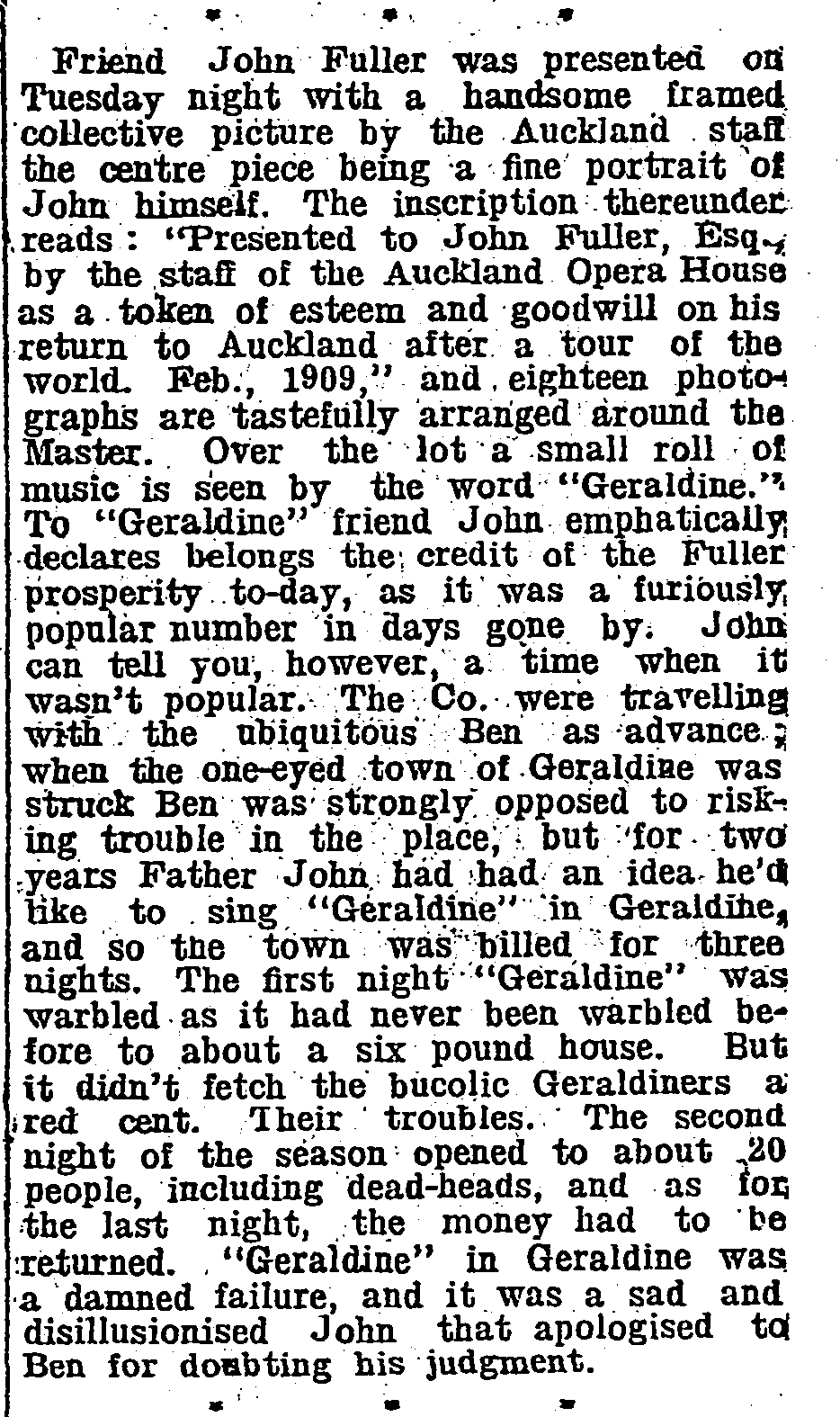
New Zealand Truth, 13 March 1909
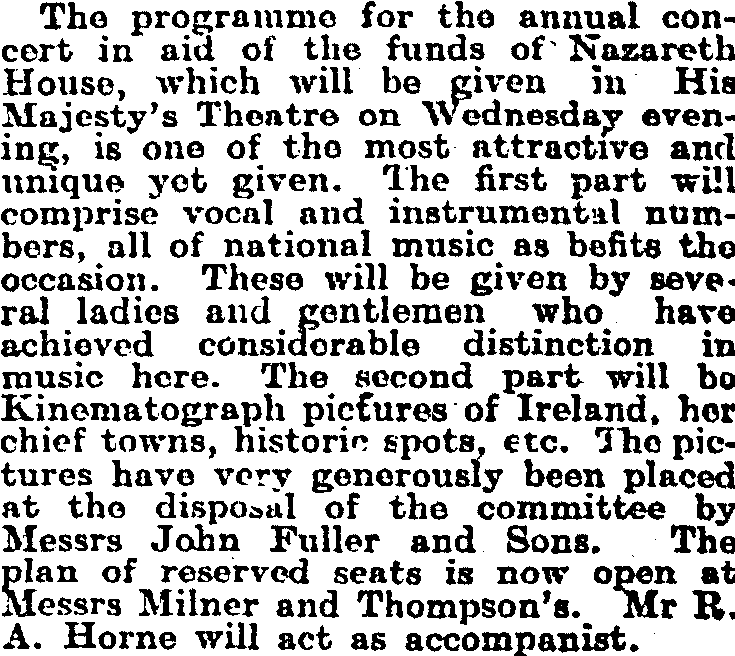
Press, 13 March 1909
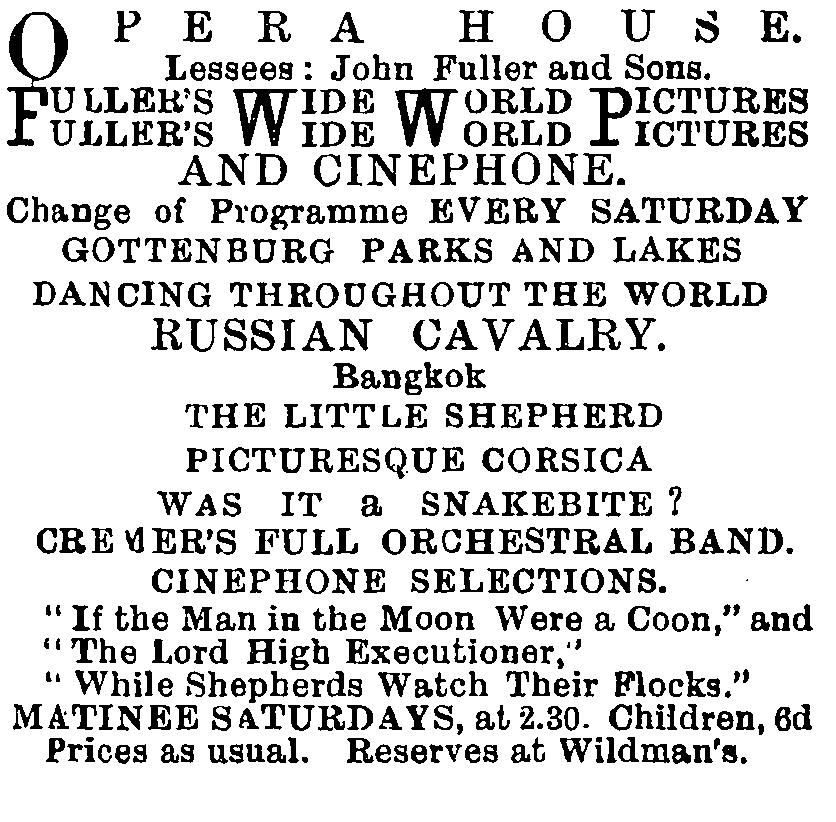
Observer (Auckland), 1 May 1909
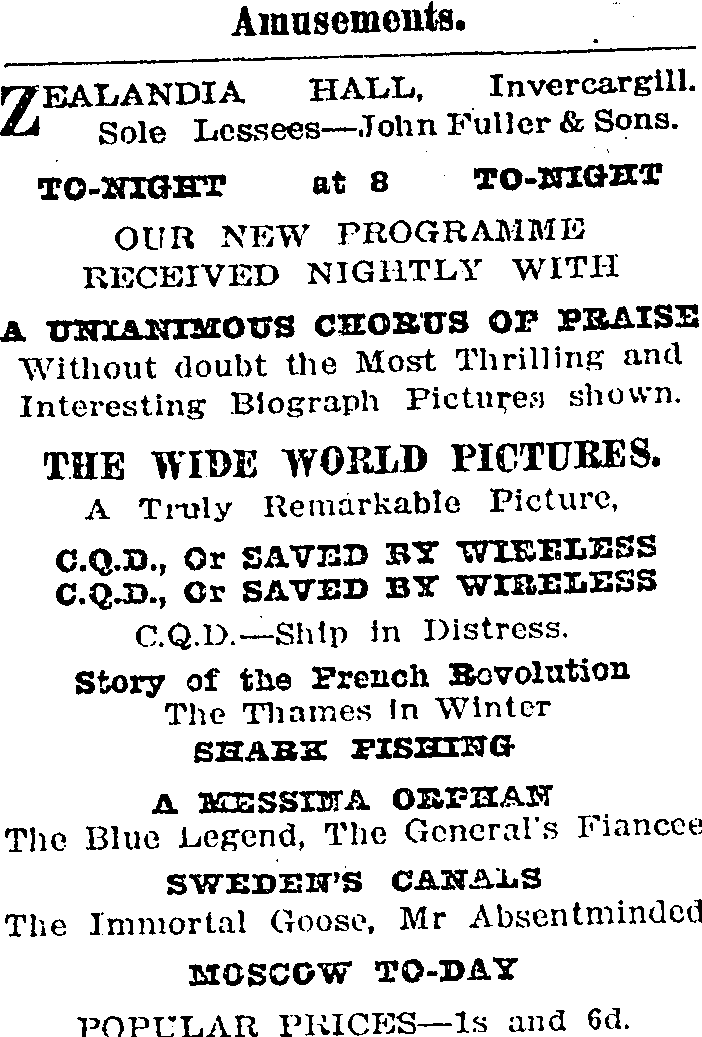
Southland Times, 7 June 1909

Otago Witness, 9 June 1909
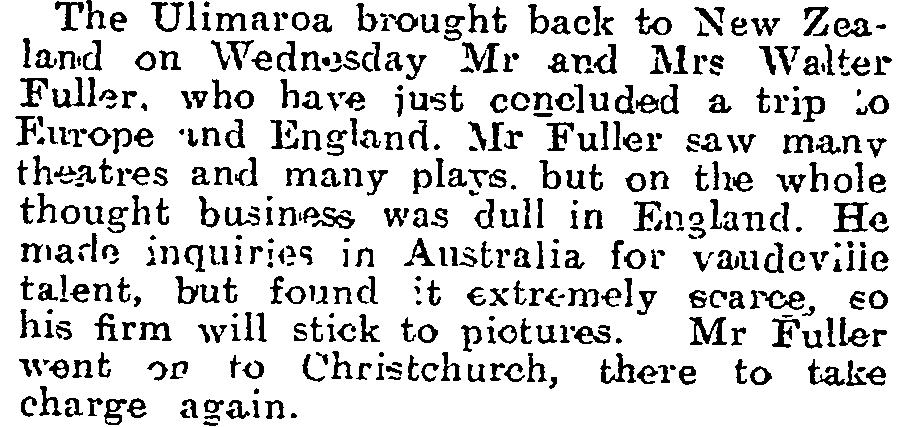
Otago Witness, 9 June 1909
HONOUR TO WHOM HONOUR IS DUE
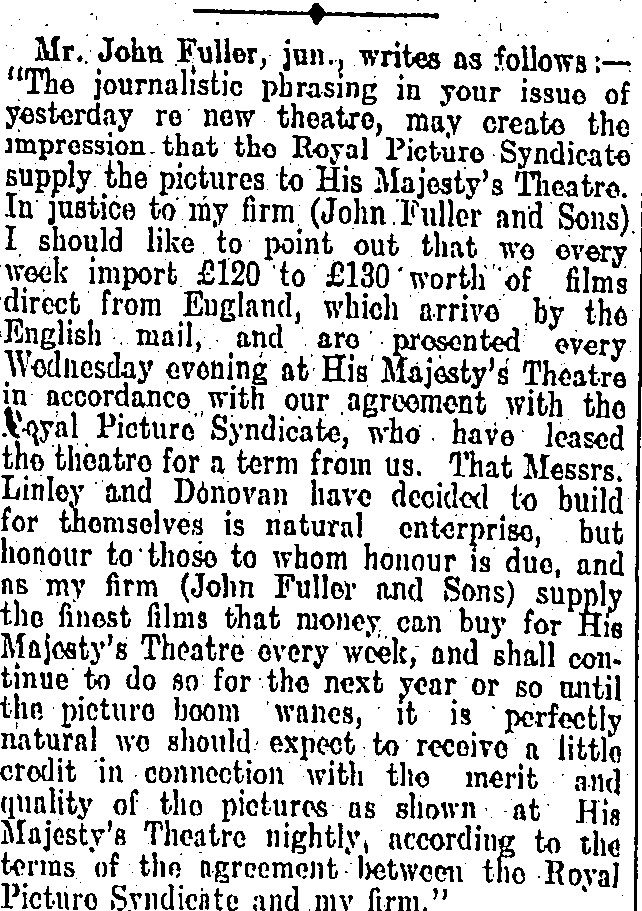
Dominion, 10 June 1909
John Fuller Jnr. is quite understandably defending his theatre, but at the same time it is interesting to note that the Fullers really don’t know what the future will bring, with his comment “my firm (John Fuller and Sons) supply the finest films that money can buy for His Majesty’s Theatre, every week, and shall continue to do so for the next year or so until the picture boom wanes.” I am sure the Fullers were closely following developments, keeping up with the latest innovations and ready to move with the times. Little could they know the future of television in every home or the invention of the computer or mobile phone. They simply had to deal with things on a day to day basis and be ready for every and any eventuality.
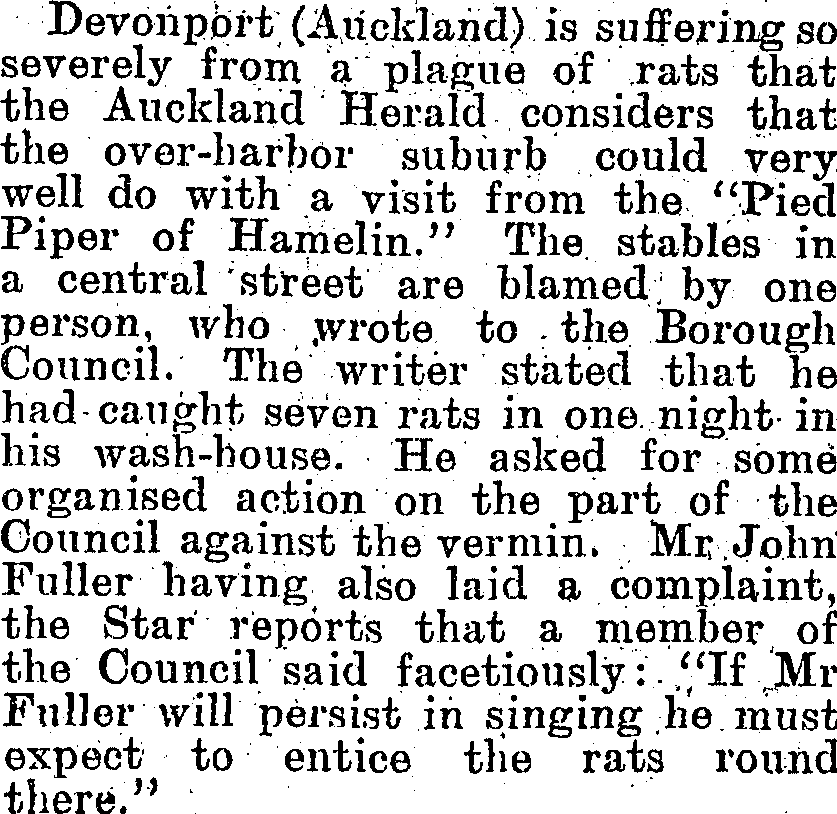
Marlborough Express, 10 June 1909
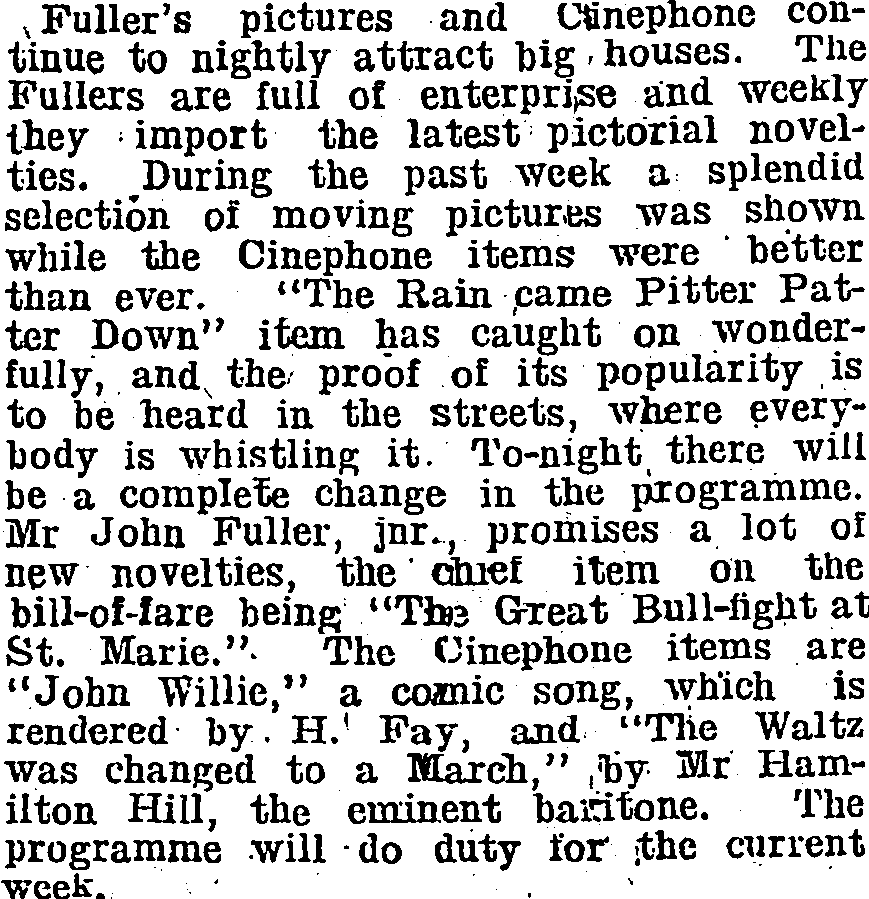
Truth, 12 June 1909
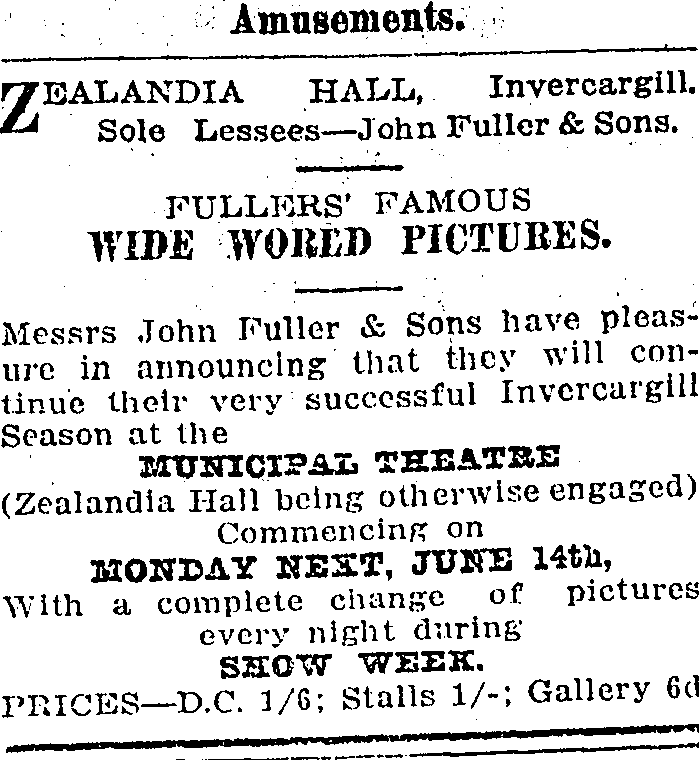
Southland Times, 12 June 1909
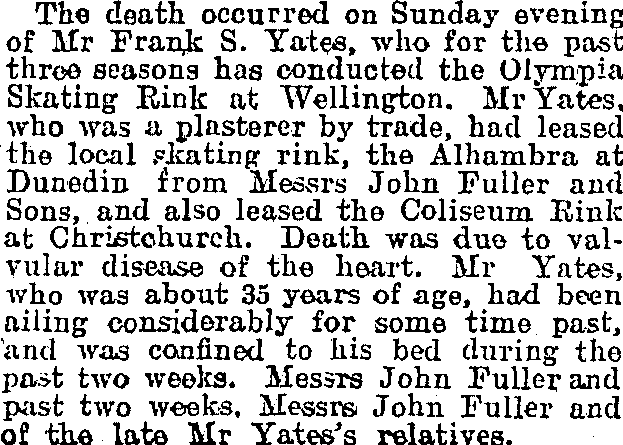
New Zealand Times, 29 June 1909
The sudden death of Frank S. Yates who ran the Alhambra Skating Rink in Dunedin and the Coliseum Skating Rink in Christchurch was an interesting insight into the eclectic nature of the Theatre business. There is a misprint in the newspaper and I am sure it was meant to end with a message of condolence from the Fullers to the Yates family.
THEATRE ROYAL, FULLER’S CINETONE

New Zealand Truth, 26 June 1909
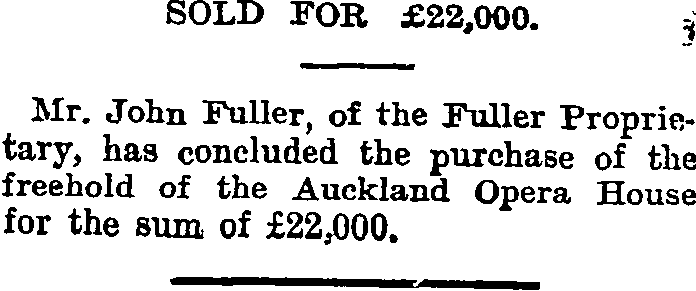
Auckland Star, 8 July 1909
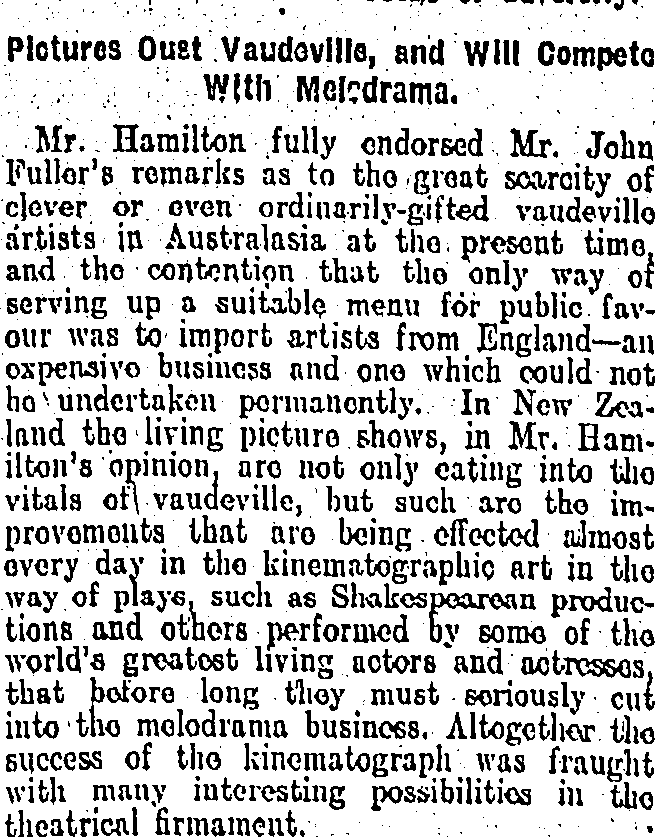
Dominion, 12 July 1909
THEATRE ROYAL
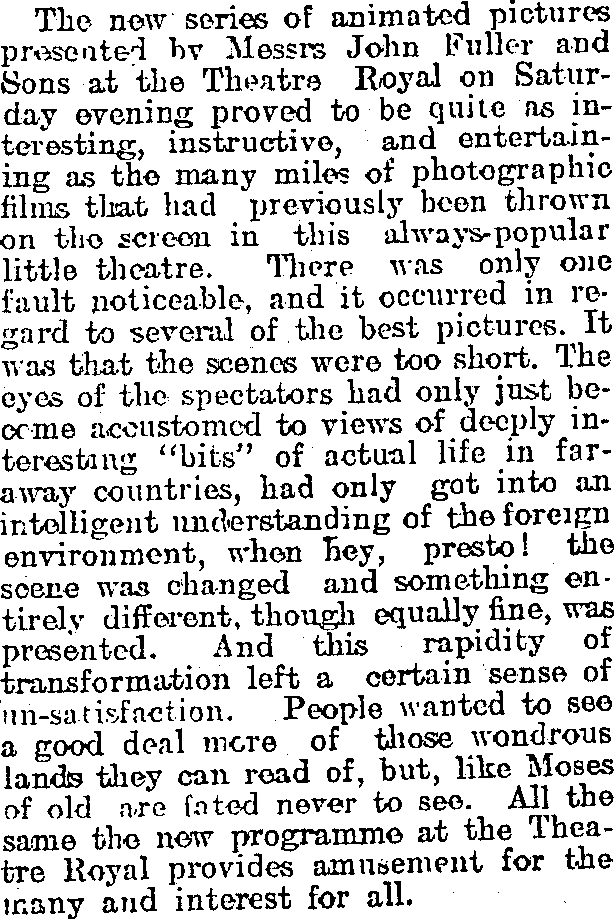
New Zealand Times, 12 July 1909


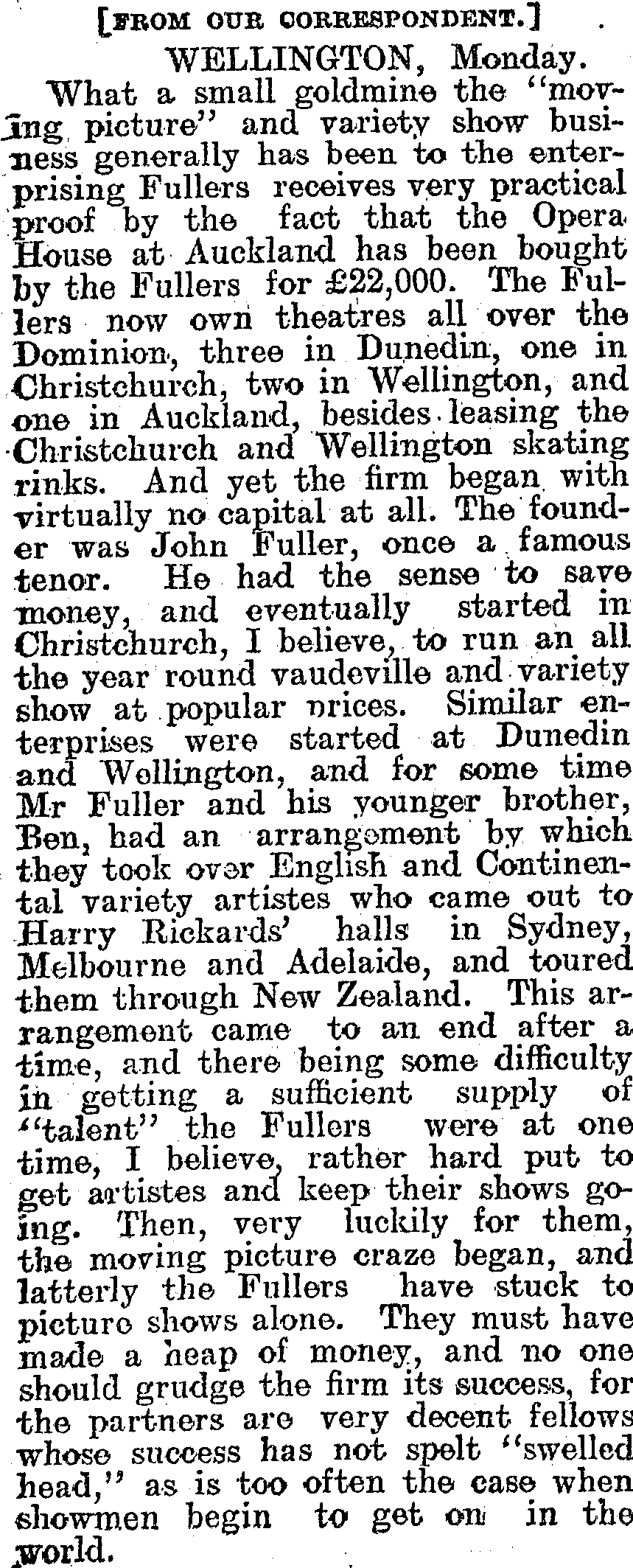
Marlborough Express, 14 July 1909
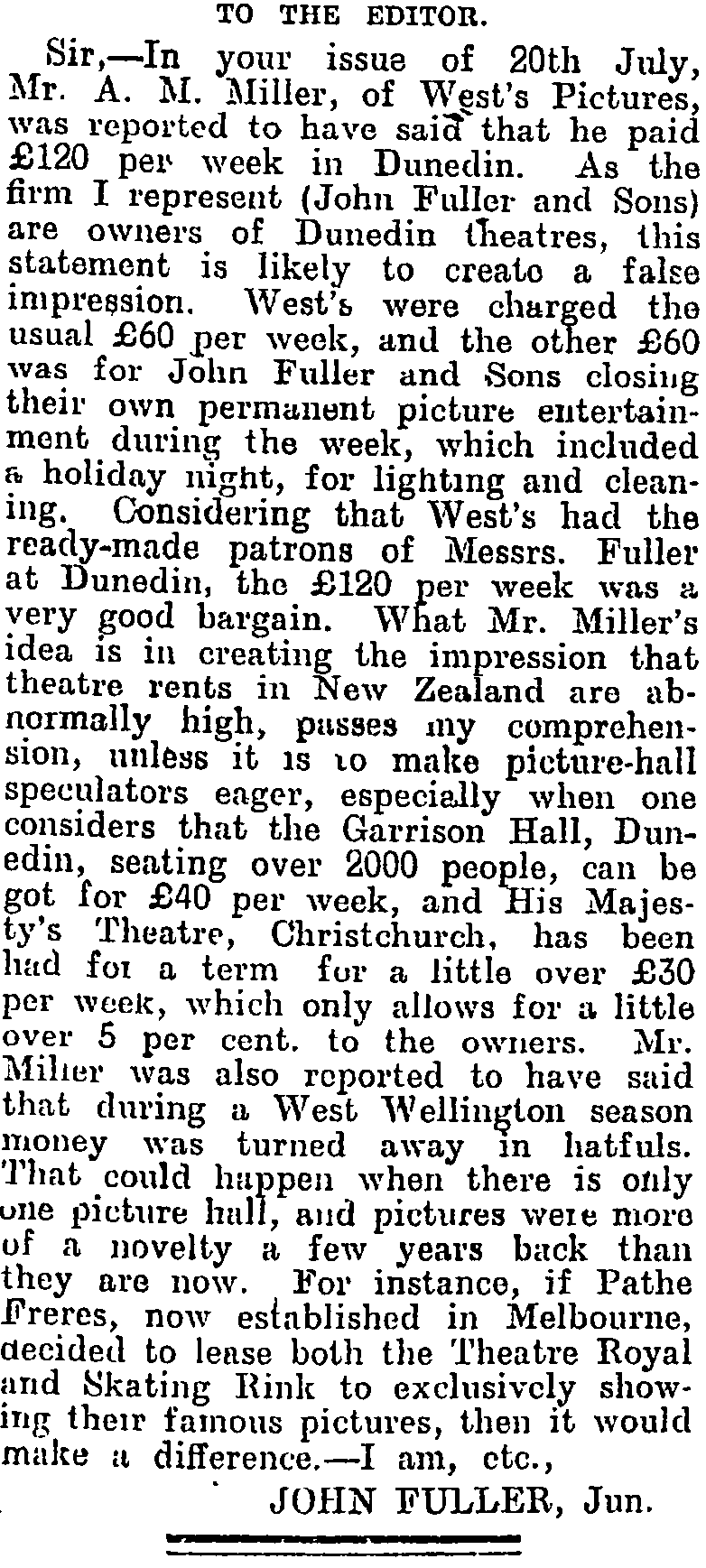
Evening Post, 2 August 1909
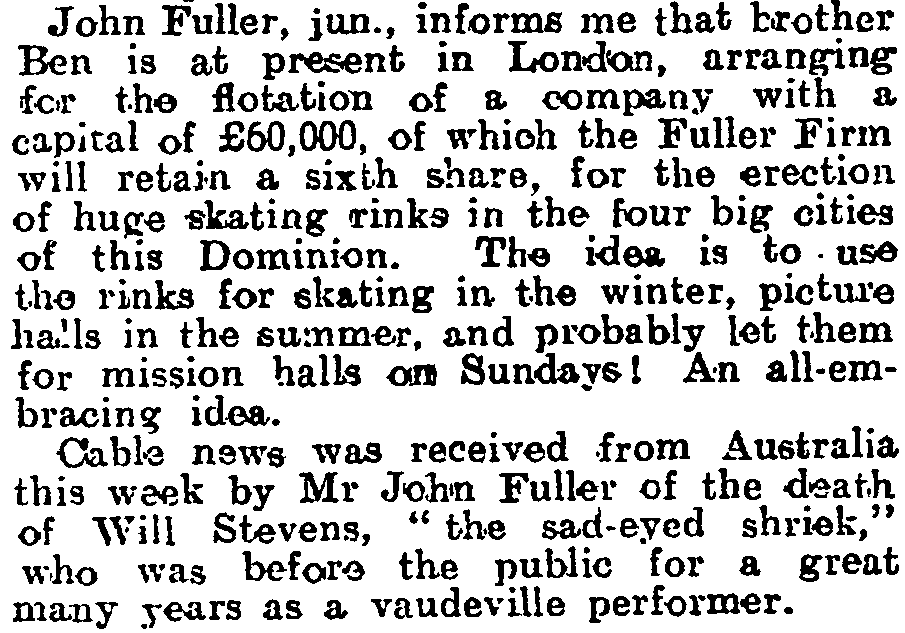
Otago Witness, 11 August 1909

Examiner, 18 August 1909
It was sad to read about the death of the popular comedic artist and singer Will Stevens in Sydney. He had appeared with John Fuller Snr. and Fuller’s Theatres for eight years in New Zealand and before that the two men had appeared in London with the Mohawk Minstrels and also the Moore and Burgess Minstrels from Islington. My grandfather John Fuller Jnr’s earliest memories was helping to “black” his dad’s face for his evening performances in London.

Referee, 1 September 1909
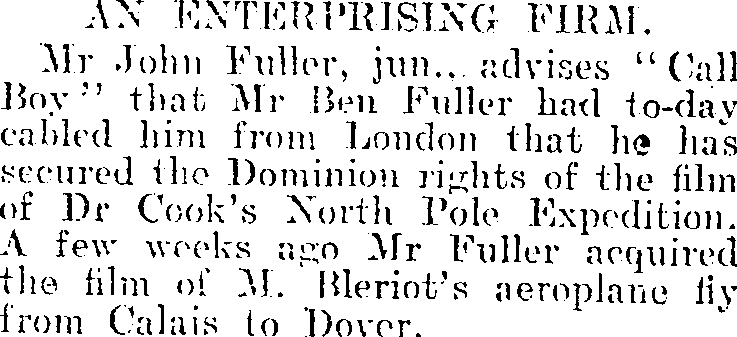
Star, 11 September 1909
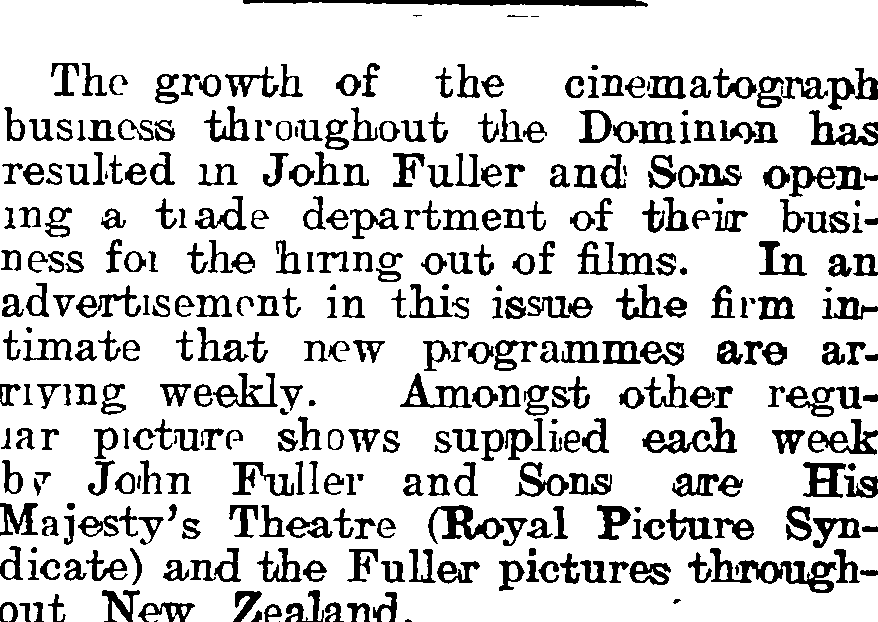
New Zealand Free Lance, 11 September 1909
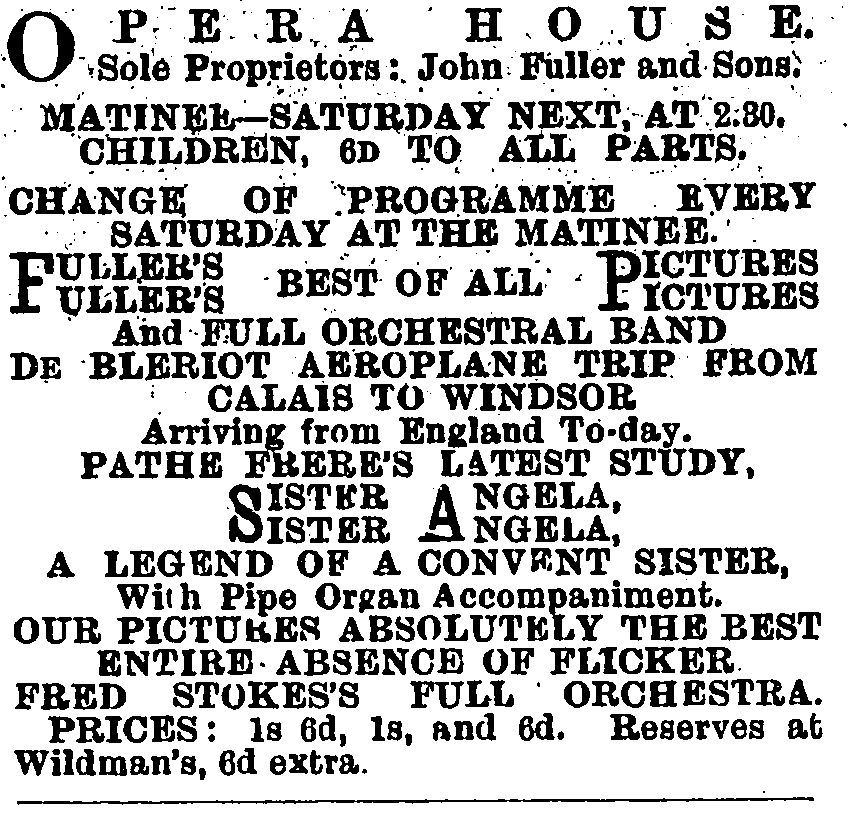
Observer, 11 September 1909

Sunday Times, 12 September 1909
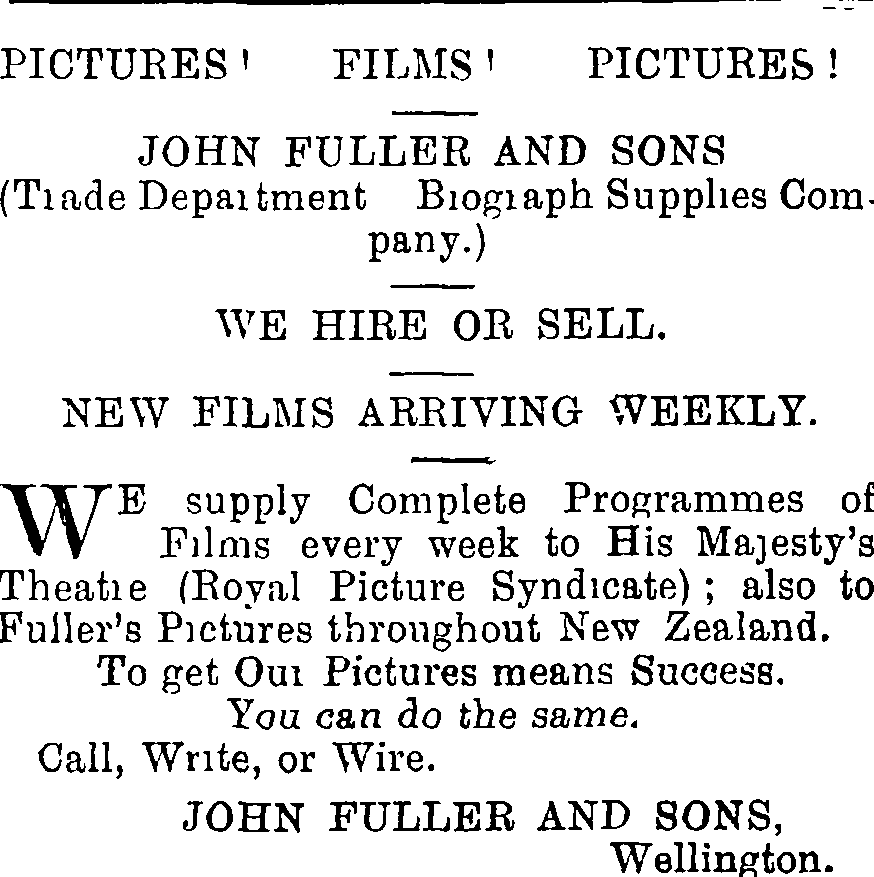
New Zealand Free Lance, 25 September 1909
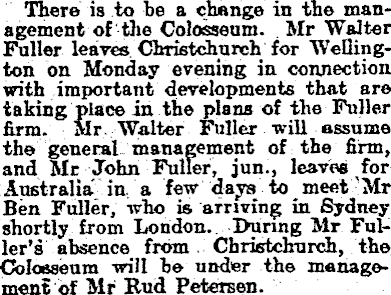
Press, 30 September 1909
The Fullers often re-organised their management team as needs required. It could be seen that during the years 1907-1909 all the main Fuller management team were travelling extensively. Firstly John Fuller Jnr. travelled in 1907, followed by his father John Fuller Snr, then Walter Fuller and finally Ben Fuller, all these men had gone on world tours just at a time when the Fuller Theatres were at their all-time most successful apex. Johnny had even commented in his diary that he may have travelled to Europe by ship second class however, he had “gotten used to the comforts of life” and had decided to book his return passage back to Australia from England via America and Asia first class.
One of the most important observations I could see was that Fuller Theatres were transitioning away from vaudeville and varietal theatre toward presenting silent movies in their theatres. This was a major development, one that would not have been taken lightly by the firm, but one that had to be taken if they were to keep up with the modern world, the requirements of their patrons and to keep in front of their theatrical competitors. I can also see that upgrades to their theatres were being completed to modernise and improve.
The Fuller family visits to Europe, America and Asia during this period were not just as tourists, these were working holidays for these men, who were visiting the most up to date movie houses in the world, gaining entry to their films to supply their New Zealand Theatres with the most up to date films that were available. The New Zealand public could not get enough of these films bringing the world “live” to their doorsteps and in this endeavor they craved more and more films about their modern and ancient world. Of course it was a win/win situation for the Fullers too who were producing the films that their audiences demanded. It was truly a business where they had to be moving with the times and importantly, one step ahead of their competitors.
JOHN’S ARTISTS COMPLAINING
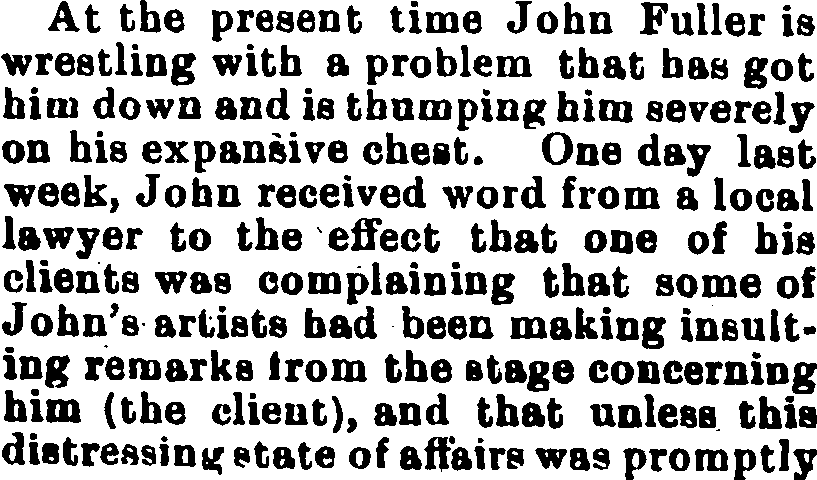
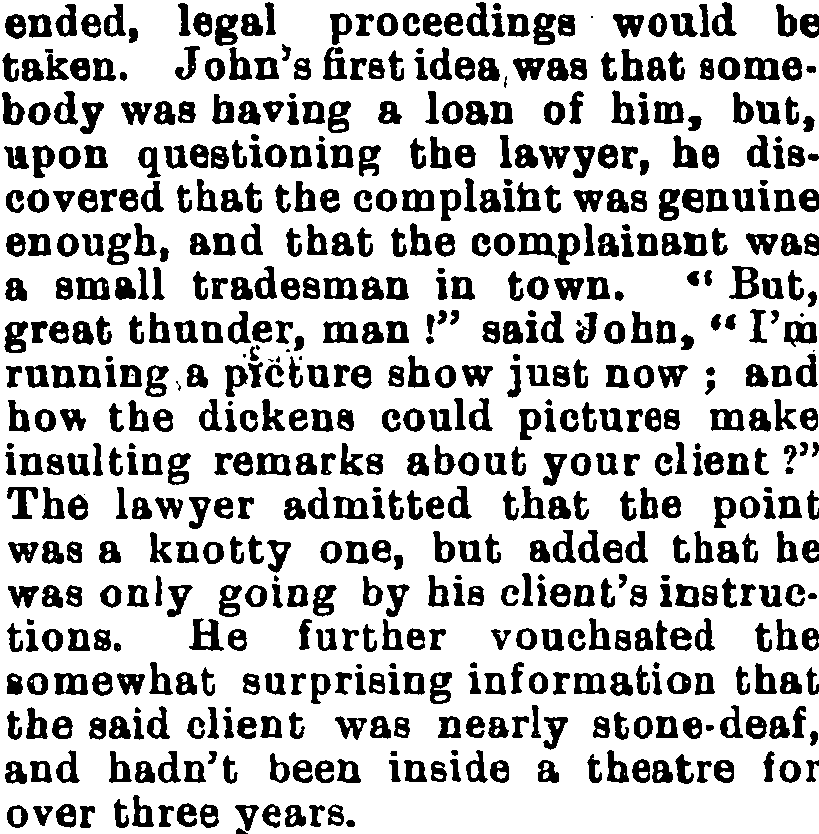
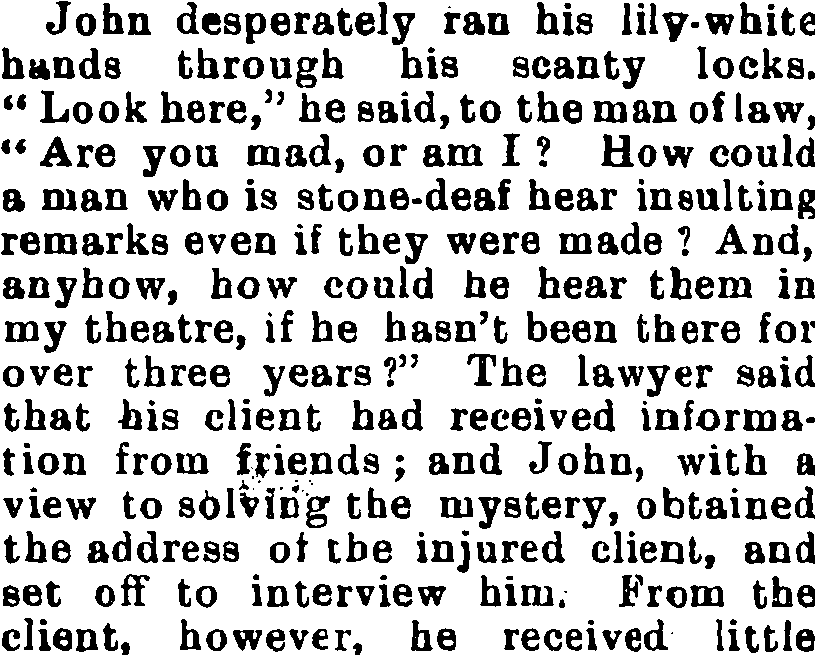
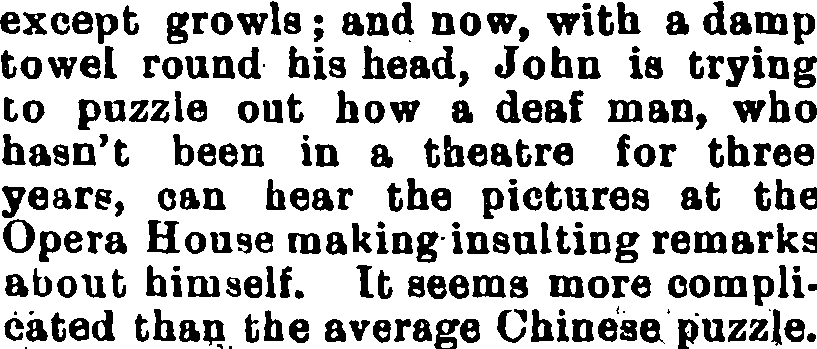
Observer, 2 October 1909

Otago Witness, 6 October 1909
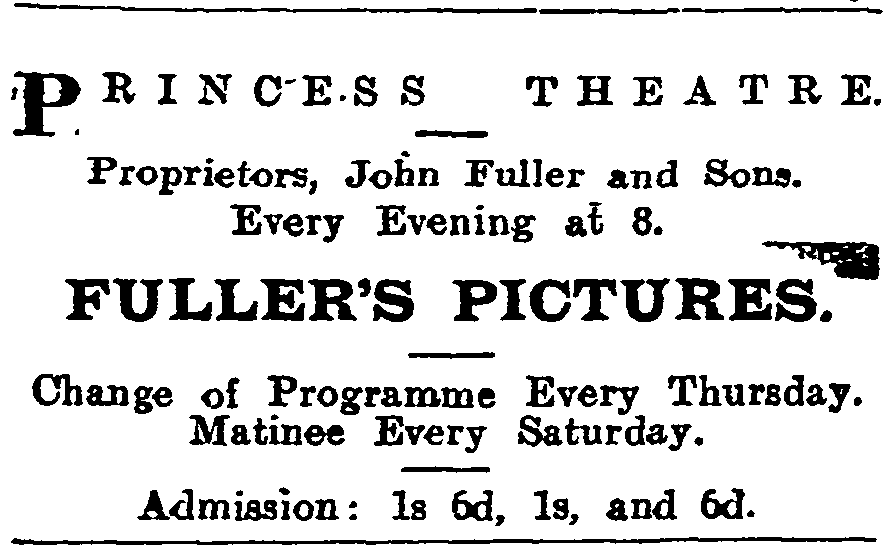
Otago Witness, 20 October 1909
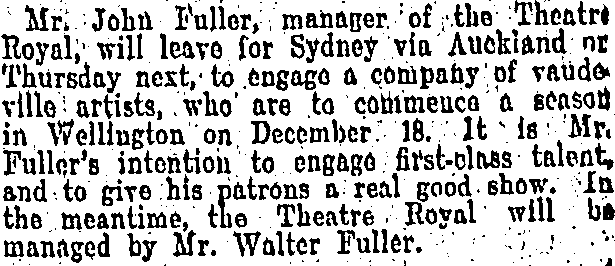
Dominion, 18 October 1909
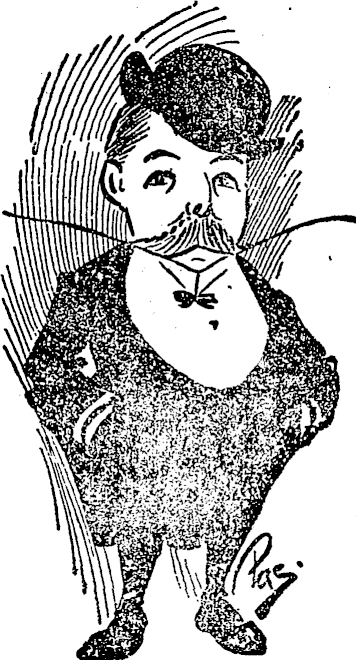
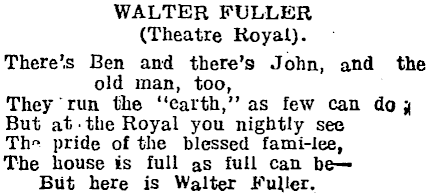
New Zealand Truth, 30 October 1909
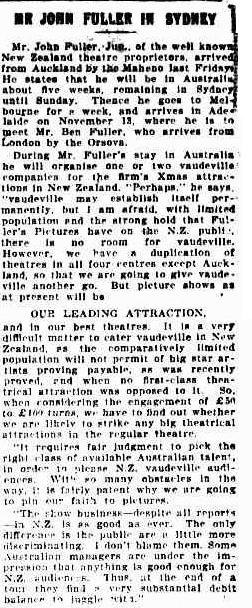
Sydney Referee, 12 November 1909

Press, 27 November, 1909

New South Wales, Australia, Unassisted Immigrant Passenger Lists, 1826-1922 for Mr. and Mrs. Ben Fuller, 27 November 1909 travelling aboard the Orsova
It was wonderful to be able to capture this shipping document for Ben and Lily Fuller, travelling from London to Sydney first class aboard the Orsova. I can only assume that when Johnny and Gertie Fuller met the Orsova in Adelaide they then caught the ship to Sydney with Ben and Lily and then the four Fullers all caught the Maheno back to New Zealand. In today’s language I imagine the reunion of Ben and Johnny must have been a “de-briefing” and a chance for the two couples to catch up on a more leisurely fashion.
So much had been going on in this first decade of the new century for the Fuller family. The rapid development of the film and picture industry had necessitated that all four of the Fullers, Johnny Fuller, John Fuller Snr, Walter Fuller and Ben Fuller had travelled to Europe to keep abreast of the new films being produced, conscious about the importance of obtaining the best and the latest films for their New Zealand theatres. These films were mostly 8 minutes in length and many were captioned, because of course, this was the era of silent movies. It meant that the Fullers were still responsible for the added musical accompaniment in their theatres to make these film productions as slick and professional as possible. Sound effects were still such an important and dramatic part of their theatres, orchestras still added to these dramatic sounds as much as narrative content by an stage orator, contributing to the New Zealand public’s thirst for newer and up to date information about what was going on in the world both theatrically and historically.
The Fullers were able to bring the latest news events, catastrophic weather and disaster events, ceremonial processions and celebrations and impending war happenings from around the world. The family recognised that their patrons desired to be informed on world events and they were eager to bring these films and short stories to the screen as quickly as possible, all this adding to the popularity and the financial success of their business. Advertising was also such an important part of their business and newspapers responded by rewarding Fuller’s Theatres with complimentary reviews of their latest films.
AMUSEMENTS
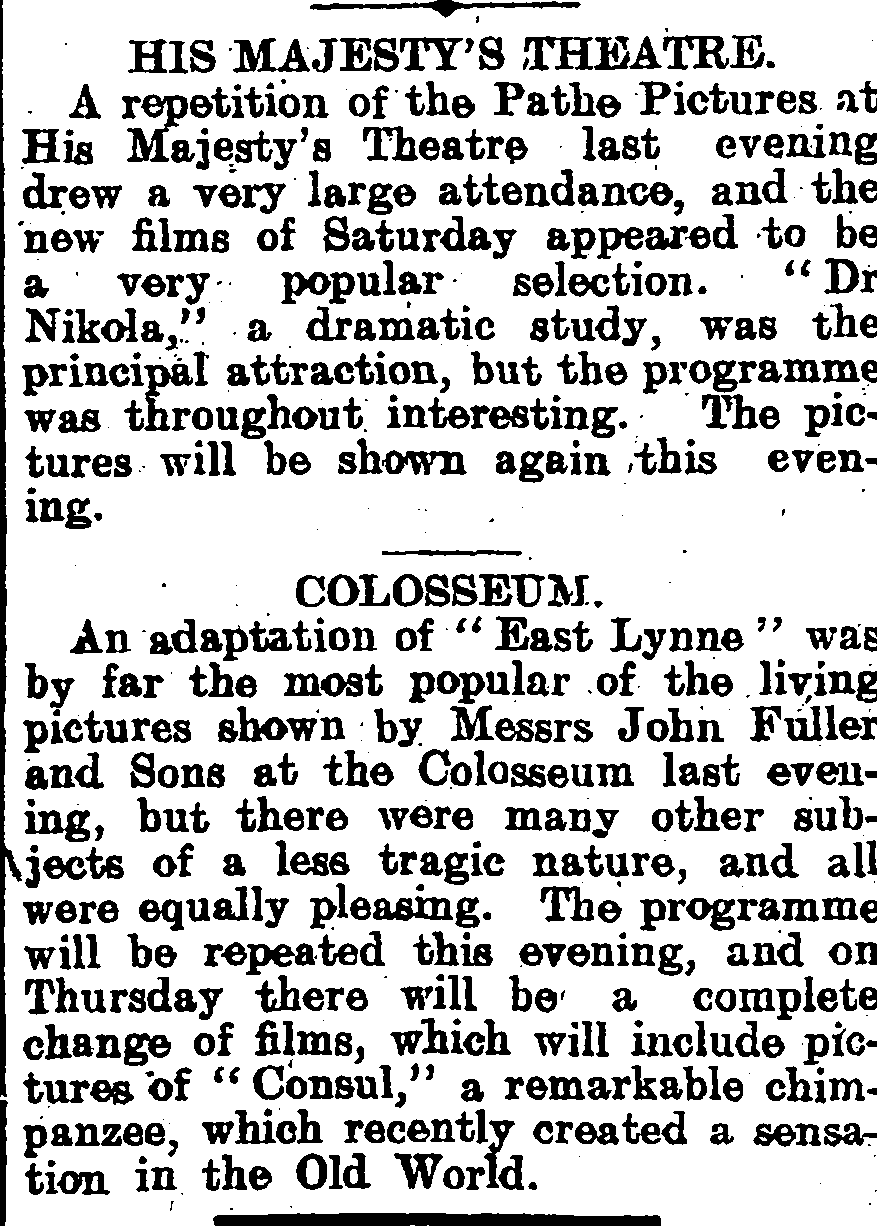
Star, 30 November 1909

Referee (Sydney), 1 December 1909
Ben Fuller’s interview with the Referee in Sydney is a wonderful reflection about this flamboyant and charismatic man, who had the gift of the gab and never ever let an opportunity pass him by without the opportunity to promote the Fuller family and their theatre business. All done with his relaxed friendliness, flair and his signature smile; not forgetting his ability to speak to any one, on any topic and always with an interesting opinion.
A NEW THEATRE
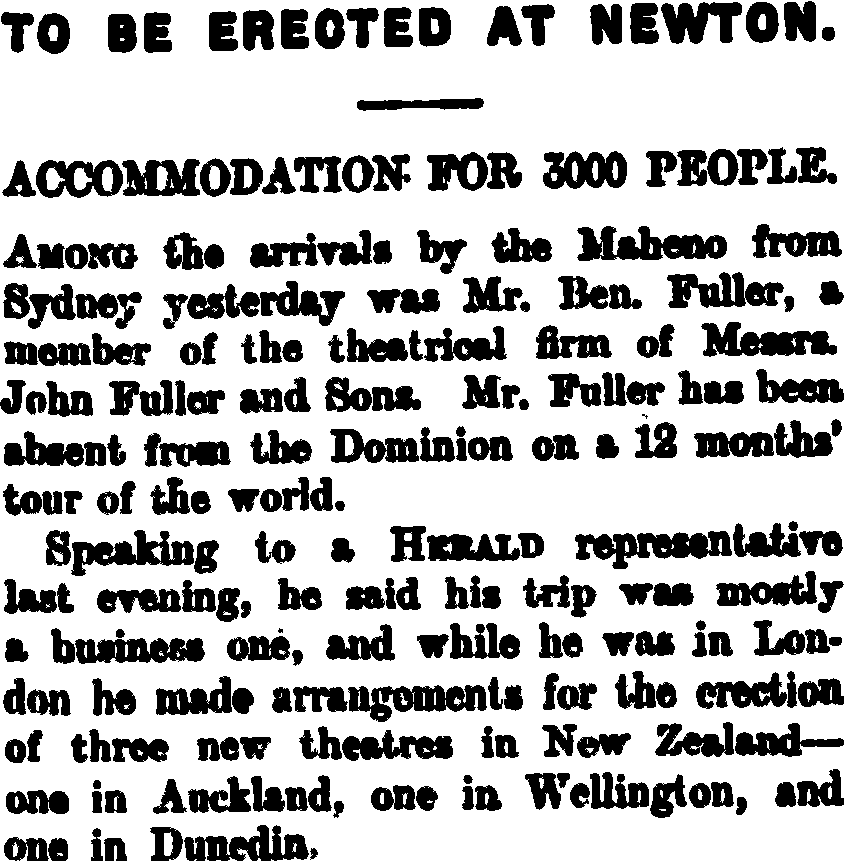
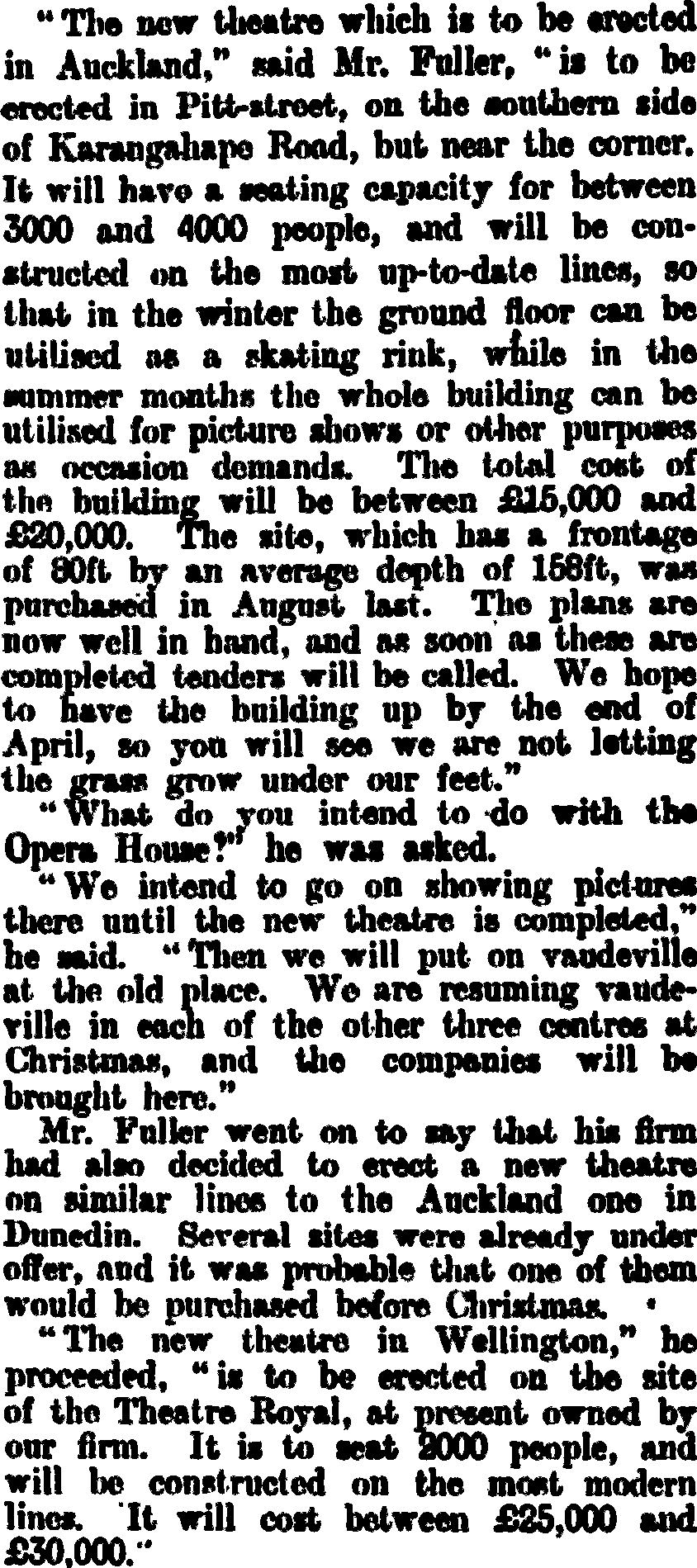
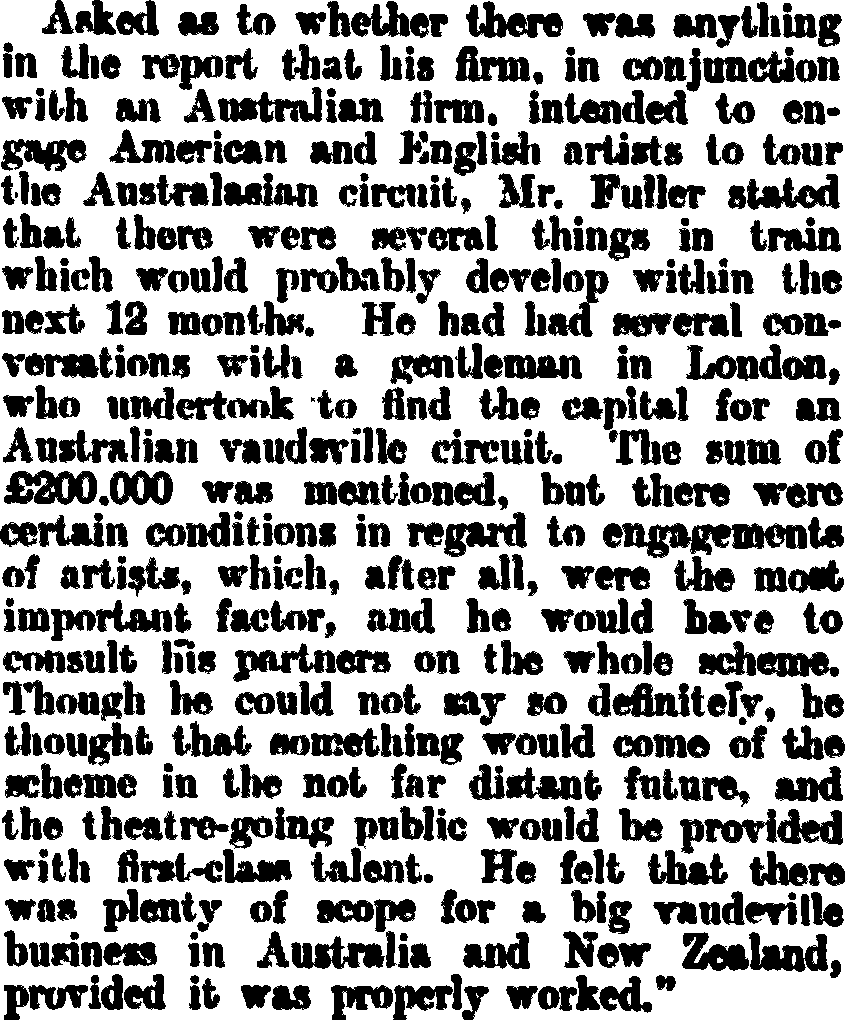
New Zealand Herald, 6 December 1909
The Karangahape Road Theatre survives today as the Mercury Theatre in Auckland, now a classified and protected theatre, which is still functioning, although in a much diminished state, having been converted into two picture theatres, compromising much of its former glory.
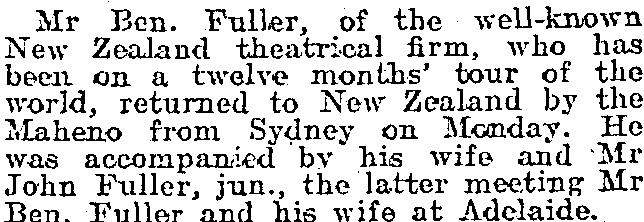
New Zealand Times, 8 December 1909
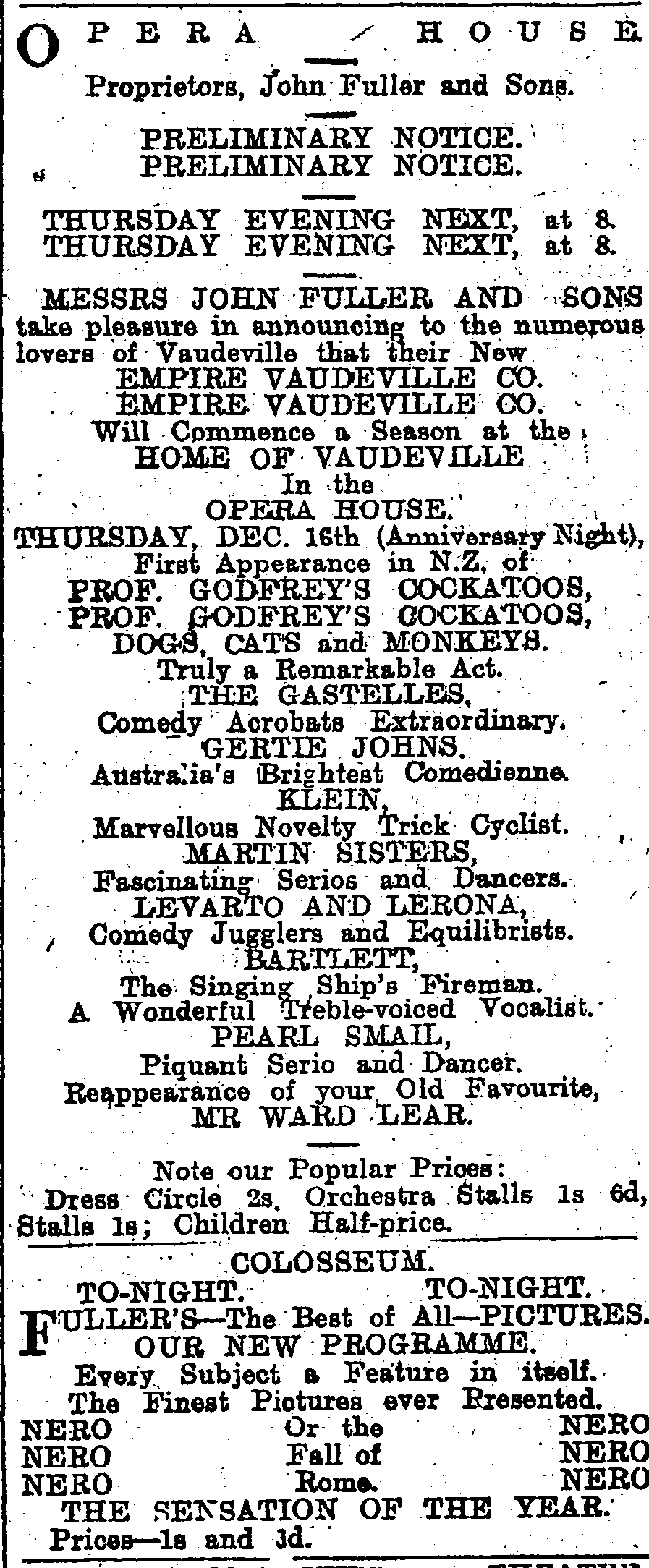
Star, 13 December 1909
A wonderful representation of talent included Prof. Godfrey’s Cockatoos, Dogs, Cats and Monkeys, the truly remarkable acrobats The Gastrelles, Gertie Johns, Australia’s Brightest Comedienne, Klein, the Novelty Trick Cyclists, the Martin Sisters, Dancers Levarto and Lerona, Comedy Jugglers and Equilibrists Bartlett, Bartlett, the Singing Ship’s Fireman, the treble voiced Pearl Smith and the re-appearance of an old favourite, Mr. Ward Lear. Films including the finest picture ever presented of Nero and the Fall of Rome.
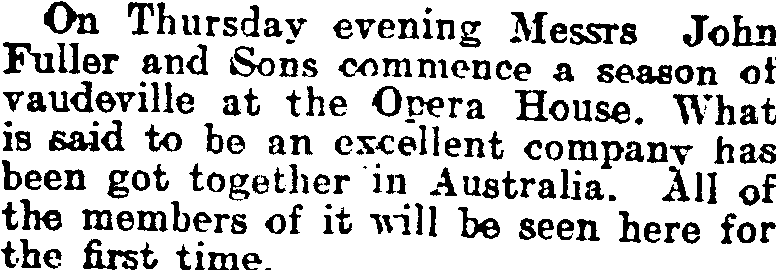
Dominion, 14 December 1909
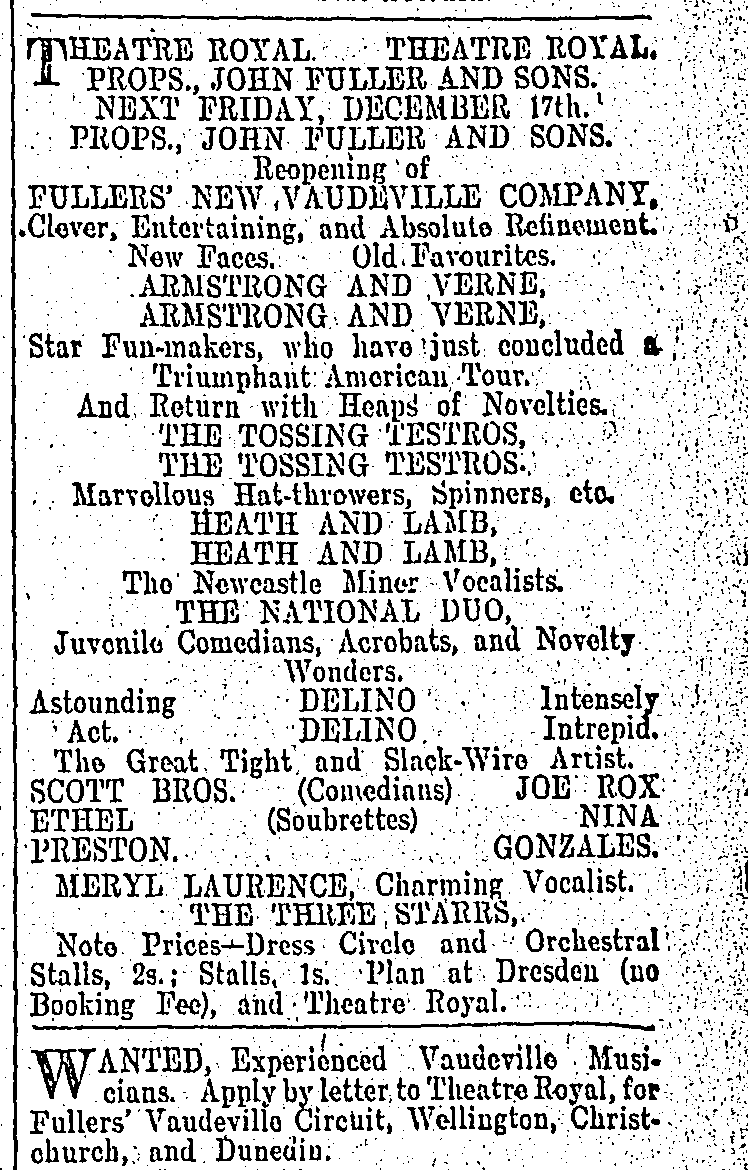
Press, 14 December 1909
Theatre Royal at Wellington was pressing forward with its entertainment schedules,
Presenting new and old faces including Armstrong and Verne, The Tossing Testros, Heath and Lamb and Newcastle’s Minor Vocalists, The National Duo, with Juvenile Comedians, Acrobats and Novelty Wonders, the astounding Delino Act, the Great Tight Wire Artists, Comedians Scott Bros., Joe Rox, Soubrettes (Operatic Sopranos)- Ethel Nina, Preston Gonzales, the charming vocalist Meryl Laurence and the Three Starrs.
It would be wonderful to hear from any descendants of these, or other acts I have listed in this chapter, which would make this history so much more interesting.
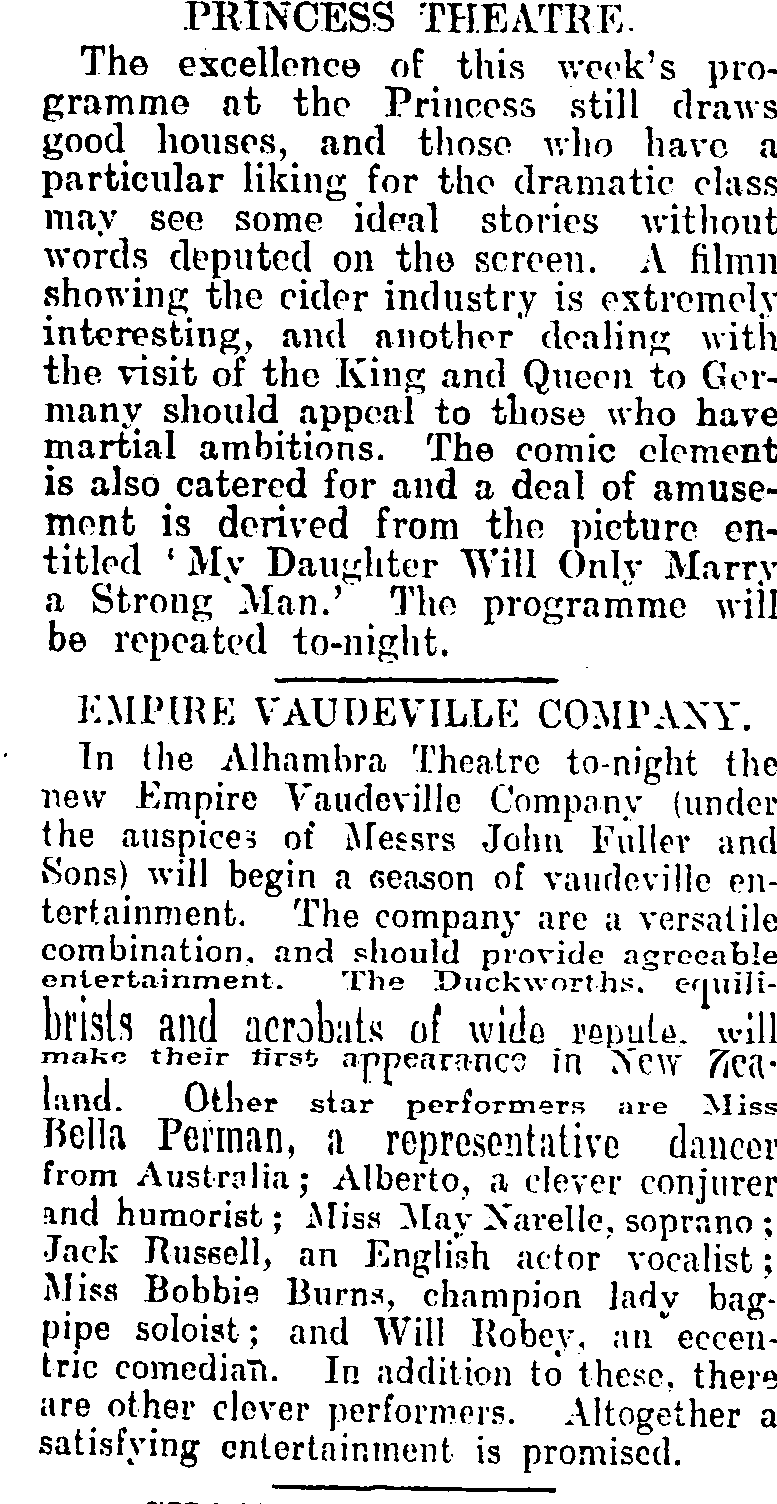
Evening Star, 20 December 1909
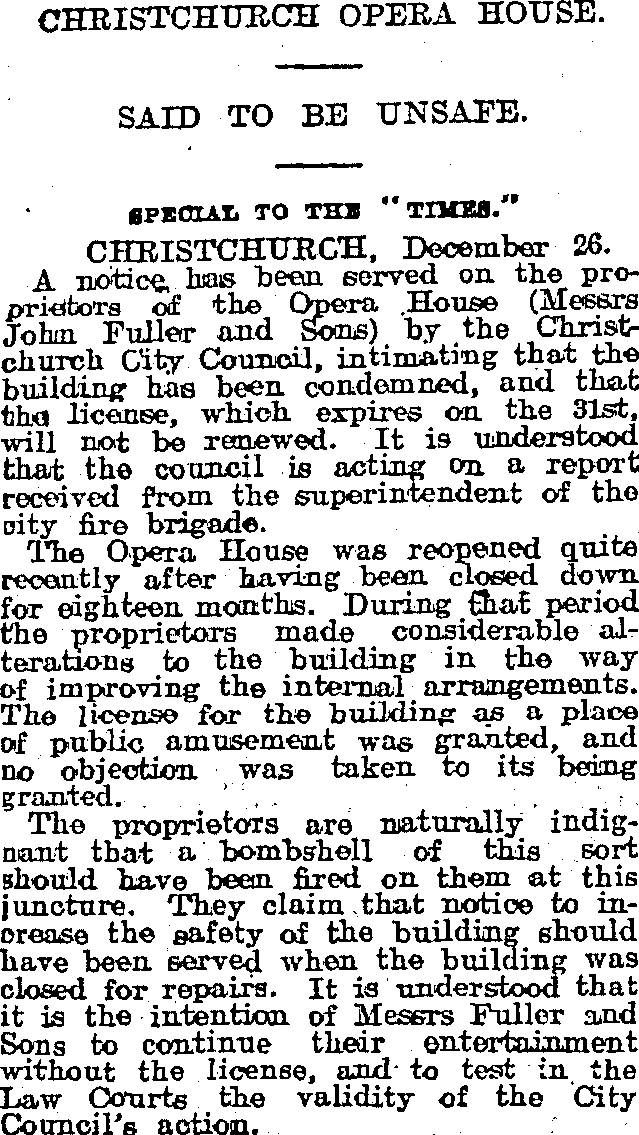
New Zealand Times, 27 December 1909
It must have been a terrible shock for Fuller’s Theatres to receive this bombshell announcement about the Christchurch Opera House being condemned and that their licence would expire on 31 December 1909, not to be renewed. The Fullers were obviously aware that there was a review of the safety requirements for the building, but it would seem they were not aware of the major repairs needed to upgrade the building for fire safety issues and compliance.
WELLINGTON MANAGEMENT

Critic, 29 December 1909
My next chapter will continue the Fuller Family Theatre history and will highlight my grandfather Johnny Fuller’s civic contributions as a Wellington Councillor, which sadly also coincides with his divorce from his first wife Gertie. The divorce was a most salacious affair, which caught the attention of the New Zealand and Australian newspapers and the general public. Johnny and his Fuller family had become the equivalent of modern day celebrities and the press and public couldn’t get enough of their private and public lives. The divorce was to prove to be a most traumatic and life changing occasion for both Johnny and Gertie, not forgetting their young daughter Phyllis, who was ordered into a Wellington convent’s care by the presiding judge during the divorce case.
I will also highlight John Fuller Snr’s famous Pig’s Whistle Defamation Court Case from 1913 and the hilarity he bought to the court room when the judge asked John to render for the court his vocal abilities. He may have lost the case and was ordered to pay damages, however, he recouped all the money and more, the following night, when John mounted an hilarious theatrical re-creation of the court scene and hilariously mocked the judge and jury; not a dry eye was to be found in Auckland’s Opera House that evening.
Virginia Rundle
23 April 2019
Bibliography:
Trove Digitised Newspapers from the Australian National Library
Papers Past New Zealand
Ancestry.com for their Shipping Records and New Zealand Electoral Rolls
Early English Newspapers, kindly provided by Jean Thomas
Thanks must go to family members for kindly forwarding me photographs of the family, including Scott Fuller, Carolyn Begg, John Stuart, Virginia Telford and Emily Dickson
Thanks again to my son Rowan Rundle for reconfiguring some of the early newspaper articles, so they now fit onto one page
Also to my husband Geoff for his help scanning Johnny’s Diary and putting up with my continuous research and writing and for his unstinting support on our family trail travels around the world
Special thanks to my sister Lavinia Chrystal for helping me to transcribe our Grandfather, John Fuller Jnr’s World Tour Diary of 1907

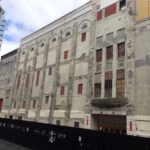
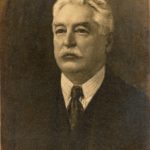
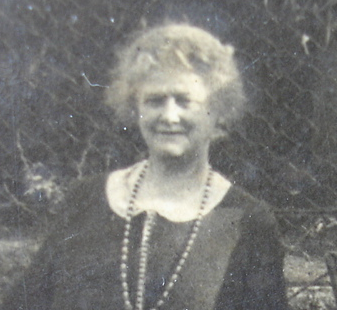
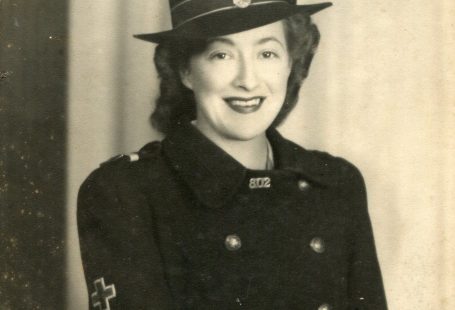
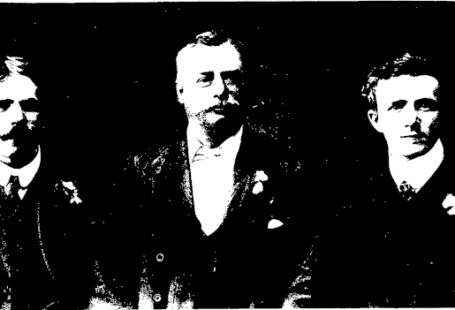
4 comments On Chapter Five – Fuller’s Earth – 1905-1909
I enjoyed going to your webiste. I leave comments rarely, but
you definately deserve a thumbs up!
Hi. Thank you for such an interesting history. I am currently writing a thesis about His Majesty’s Theatre in Dunedin, and just about to tackle events in 1907!
Hello there – fascinating history. Thank you. I grew up in Avalon Beach, NSW – daughter of Arthur Murch, the artist. The Fullers lived at the bottom of Palmgrove Road and I remember the house. Arthur Murch drew a beautiful crayon of Penny Fuller (early 1960’s?). I still have this portrait. My brother John was about the same age as John Fuller. Arthur did a fabulous portrait in 1950 of George Wallace the comedian who visited the house and I think was related to the Fuller Family. The portrait is now in the Rockhampton Art Gallery, Qld. I have some studies for this portrait. Would love to know if you are a branch of this Fuller family. Thank you.
Such an incredible history of the Fuller’s as a former Fuller myself I am in ore of your research. I really enjoyed reading this, bravo. I am sure somewhere along the line they must be distant relatives of my London Fullers. What characters about right lol. I was searching for my Nan’s sister Sophia (Sophie AJ) a dancer that went apparently to Russia in 1913 no one knows what happened to her as war broke out. Can only hope she had such an amazing life fear that may not have been so lucky though…